LET’S TALK ABOUT SIDEWAYS TRAINING YOUR MEMORY to retain more from a lesson
E N j OY YOUR h ORSE
whatever the weather
LIG h TNING
and its effects on horses and riders
WOUNDS back to basics
RESET YOUR RIDING... the Pelvis
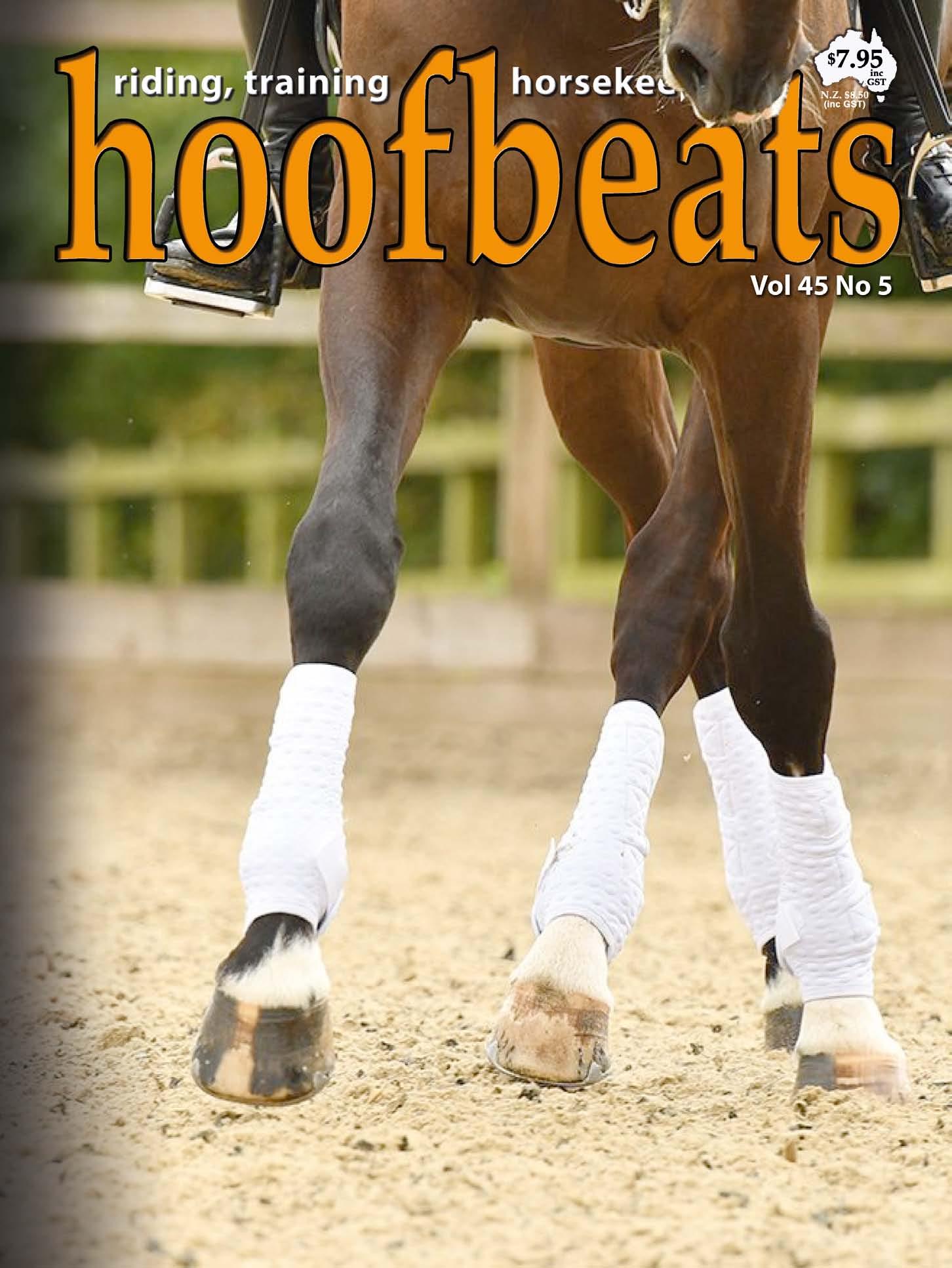



the green horse: Horses and the Land
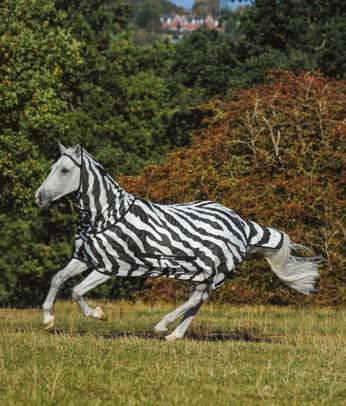
WIN
to hoofbeats to

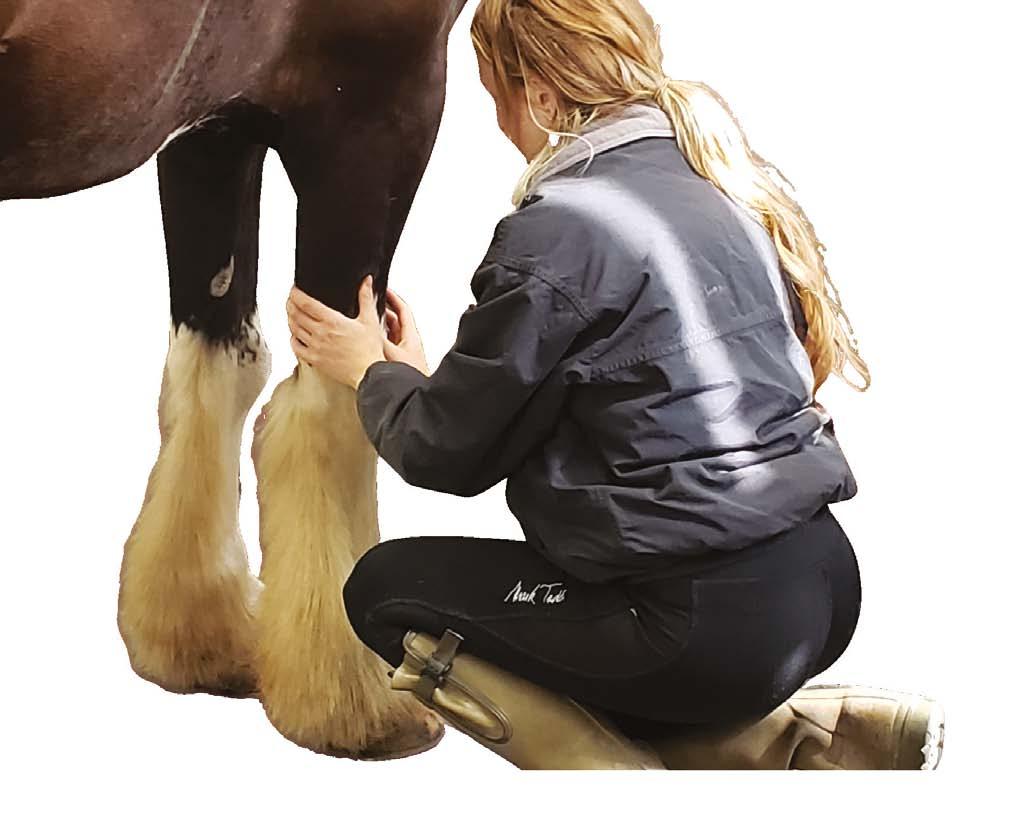
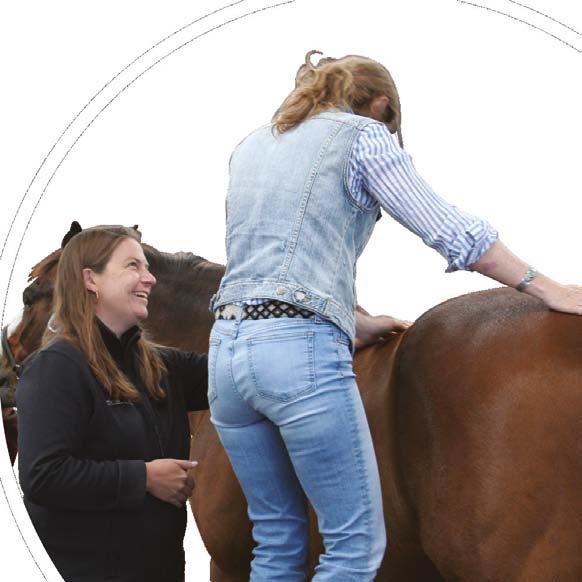




Learn



Taught

Anim A l Sport S t her A py r eh A bilitAtion certific Ation for l icen S ed p rofe SS ion A l S Onsite Module 3 coming to Australia for the first time. Sept. 15-24, 2024. Sign up for Module 2 now to be ready! www.academyofanimalsportscience.com
of 300+ hours
programs welcome
Graduates
eebW
to clearly define
the rehabilitation goals for the individual horse
by Dr.
Schlachter, DACVSMR, Dr. Nicole
MEEBW, PhD and Debranne Pattillo
the program is recognised by relevant associations within the industry
individualised treatment/rehab plans based on assessment and goals
Carrie
Rombach,
Ensure
Write
Academy of Animal Sports Science
STANDARD RETURNS THE GOLD

Longer lasting.
Non-irritating.
Contains permethrin.
Natural Citronella Oil.
May protect for up to 2 weeks under ideal conditions.
Zone Control: Also apply to stables, floats and rugs.

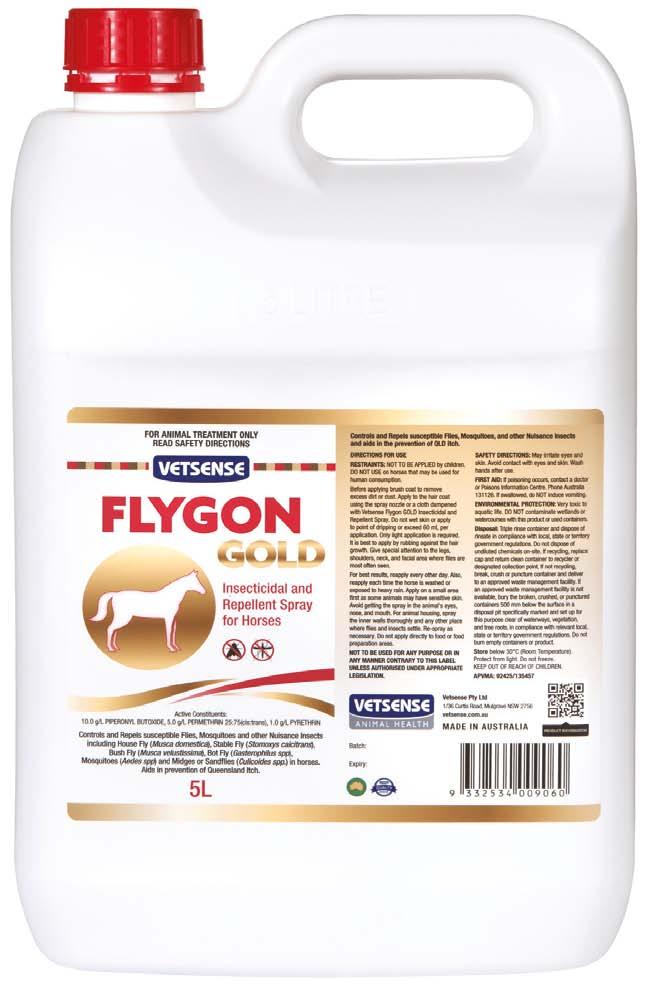


Flygon GOLD Controls and Repels susceptible Flies, Mosquitoes and other Nuisance Insects including House Fly (Musca domestica), Stable Fly (Stomoxys calcitrans), Bush Fly (Musca velustissima), Bot Fly (Gasterophilus spp), Mosquitoes (Aedes spp) and Midges or Sandflies (Culicoides spp.) in horses. Aids in prevention of Queensland Itch.

Contact Vetsense: Available from all participating saddleries, rural supplies, produce and feed stores, vet clinics and online stockists.
A National Riding, Training and Horse Care Magazine . . . . incorporating The Green Horse -sustainable horsekeeping.
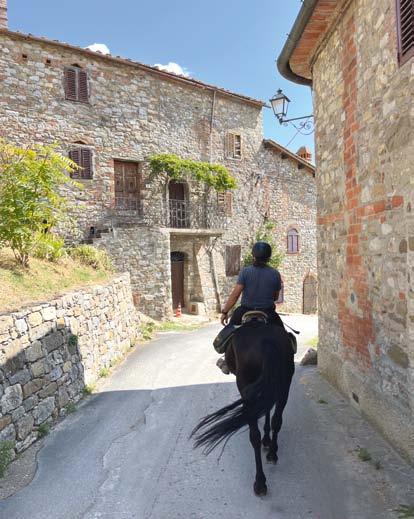
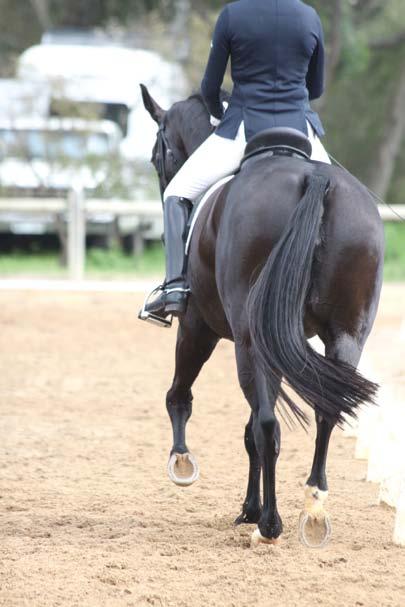

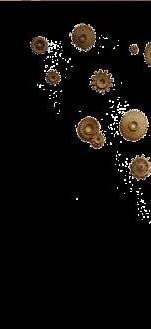
4: Training Your MeMorY by Wendy Barker
When you’re paying for coaching it makes sense to learn strategies to ensure you get as much out of your lessons as you can.
10: a TasTe oF TuscanY by Denise Legge
Keen to embark on another overseas holiday with horses, Tuscany ticked all the boxes as a top destination to combine a love of travel, food and wine, and, most importantly, riding.
16: Zarah - from dancing on stage to dancing in the saddle by Deidre Rennick
Zarah Lont faced her first health challenge as a teenager, going on to overcome more health battles than anyone should with determination and a dedication to riding.
20: reseT Your riding by Mel Macaulay
Pelvic stability is important for riders as it allows for clear communication and connection with the horse.

24: Wounds - back To basics by Dr Jennifer Stewart
Horses can be prone to injury and most wounds will progress through the healing stages well. A number of factors can influence the reasons for those wounds that don’t.
30: PLease eXPLain
Why do some horse owners soak or steam their horse’s hay? Kentucky Equine Research explains. Is my horse crying? Why can’t horses breath through their mouth, and how can I improve my sitting trot are also addressed in this issue’s Please Explain.

34: is Your ProPerTY

PrePared by Rhiannon Brown
36: can a soiL TesT TeLL WhaT ’s in Your PasTure? by Nerida Richards
36: sToP The roT by Bounce Back Horse Fence
37: dung beeTLes To T rescue by Wendy Elks
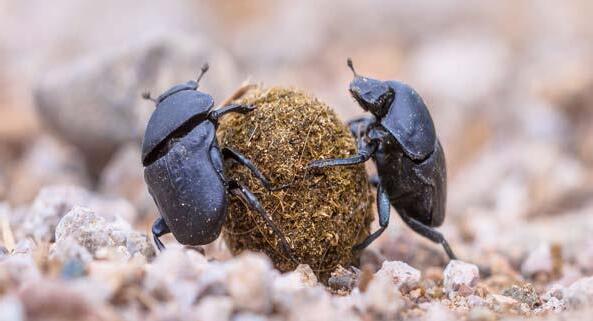
44: rosehiPs- the herb with a punch by Country Park Herbs
February/March 24 - Page 2
Vol 45-5 February March 2024 Inside
hay
PLEASE EXPLAIN- soaking

ediToriaL:

As many of our long term readers would know, Hoofbeats had its start in 1978 with my husband Rob and I launching the magazine with two other horse owners. It was an instant hit in Western Australia where the magazine was initially launched, and Rob and I have worked together on the magazine ever since, joined these past 45 years by people equally passionate about horses and putting out content that’s informative, practical and enjoyable to read, which was what we wanted to read when we started out in horses.
Unfortunately, over the past few years Rob’s had some health challenges, the consequences of their impact increasing the past few months. While we’ve worked hard to keep all that’s involved in producing a magazine every two months ticking along I will admit that it has been pretty challenging at times, and would not have been possible without the support of a few individuals. As any small business owner will tell you, it can be hard dealing with curve balls when you’re running a business at the same time as supporting your partner through serious health issues. As a result the last couple of issues have come out a little later than usual, a pattern that’s occurred once again with this issue so we thank you for your support as you wait a bit longer for your magazine to reach you in the mail, via your local stockist or access on your device. Over the years we’ve had so much feedback on our articles, many of which are as relevant today as when they were first published. With my focus and time dedicated to Rob this issue it was suggested we consider revisiting a couple of topics that are of ongoing interest to horse owners and it was interesting delving into the archives and being reminded of just how many great features and articles we’ve done over the years. We will be working towards addressing the publication date in the future, meanwhile we hope you enjoy reading the couple of revisited and updated features in this issue.
Sandy Hannan - Managing Editor
MAnAgIng EdIToR: Sandy Hannan
AdvERTIsIng: Tracy Weaver-sayer
gRAPHIcs Michelle Quinn, Jacqueline Anderson
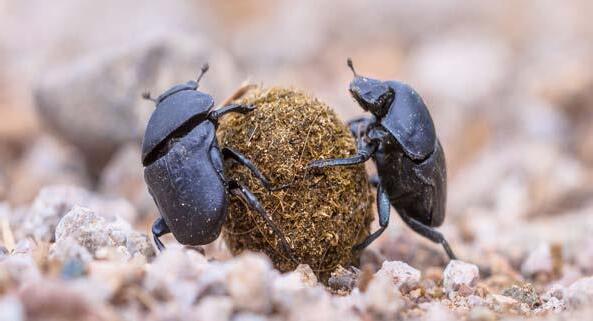
Produced by HoofbEAT PubLIcATIons
90 Leslie Road, Wandi, 6167 Ph: (08) 9397 0506 conTAcT
ffice/accounts: enquiries@hoofbeats.com.au
Ads: ads@hoofbeats.com.au
Editorial: editorial@hoofbeats.com.au
hoofbeats.com.au
MEDIA PARTNERs
Equine Veterinarians Australia
The

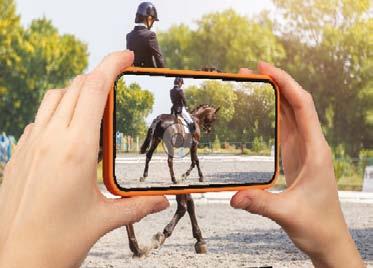
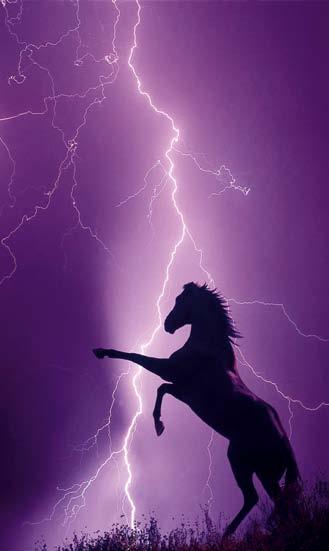
38: LighTning and iTs eFFecTs on horses and riders by Anna
Marsden
In november 2023 there were 40,465,119 lightning strikes across Australia affecting horses, riders (and others) as well as starting numerous fires.Lightning is a potential killer so what can you do to protect yourself and your horse when a storm approaches?
46: enjoY Your horse... whatever the weather
by Portland Jones
While it’s still hot it’s important to consider the impact of the heat on your horse and what activities might be best suited to the weather.
48: LeT ’s TaLk abouT sideWaYs
by Liz Tollarzo
often associated with dressage, lateral work is important for all horses as the ability to move your horse sideways when asked is useful for every rider.
52: onLine coMPeTiTions
by Wendy Elks
showing horses can be expensive, especially when you factor in all the associated costs and travel. online shows present an opportunity to compete in equestrian disciplines against a variety of competitors.
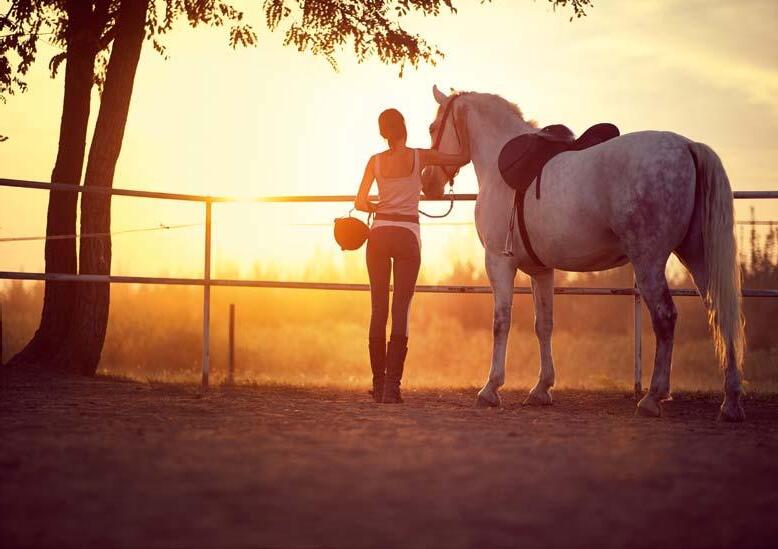
58: For The Lo Ve oF TheM ... the non ridden horse
by Wendy Elks
not all horse owners are able to, or wish to ride, many are content to have a paddock ‘ornament’ and coming home to see their horse grazing in its paddock gives them all the satisfaction they need.
reguLar FeaTures :
63: horse FronT - neWs
65: subscribe subscribe to go in the draw to win one of three bucas buzz-off Zebra rugs. for more information on the bucas range visit www.shoofdirect.com.au/bucas
To subscribe to Hoofbeats go to: www.hoofbeats.com.au


co Ver PhoTo
We just loved the image of this horse showing its lateral steps, and it fit perfectly with Liz Tollarzo’s feature on Let’s Talk About Sideways. This is a compilation of a series that Liz did a few years ago and we will upload these to the web site shortly so you can view them online should you want more on the individual movements.

opinions expressed in this magazine are not necessarily those of the publishers or the editor. Contents of advertisements are the responsibility of the advertisers Features and photographs are welcomed via email. Reproduction of any part of Hoofbeats is protected by copyright and only permitted when a written release has been received from the publisher.
YOUR MEMORY
COMPETITIONS
LIGHTNING TRAINING
ONLINE
RESET YOUR RIDING... thePelvis WOUNDS: backtobasics EN OY YOUR hORSE whatevertheweather LET’S TALK ABOUT SIDEWAYS TRAINING YOUR MEMORY toretainmorefrom lesson LIGhTENING and effectson horsesandriders thegreenhorse:HorsesandtheLand
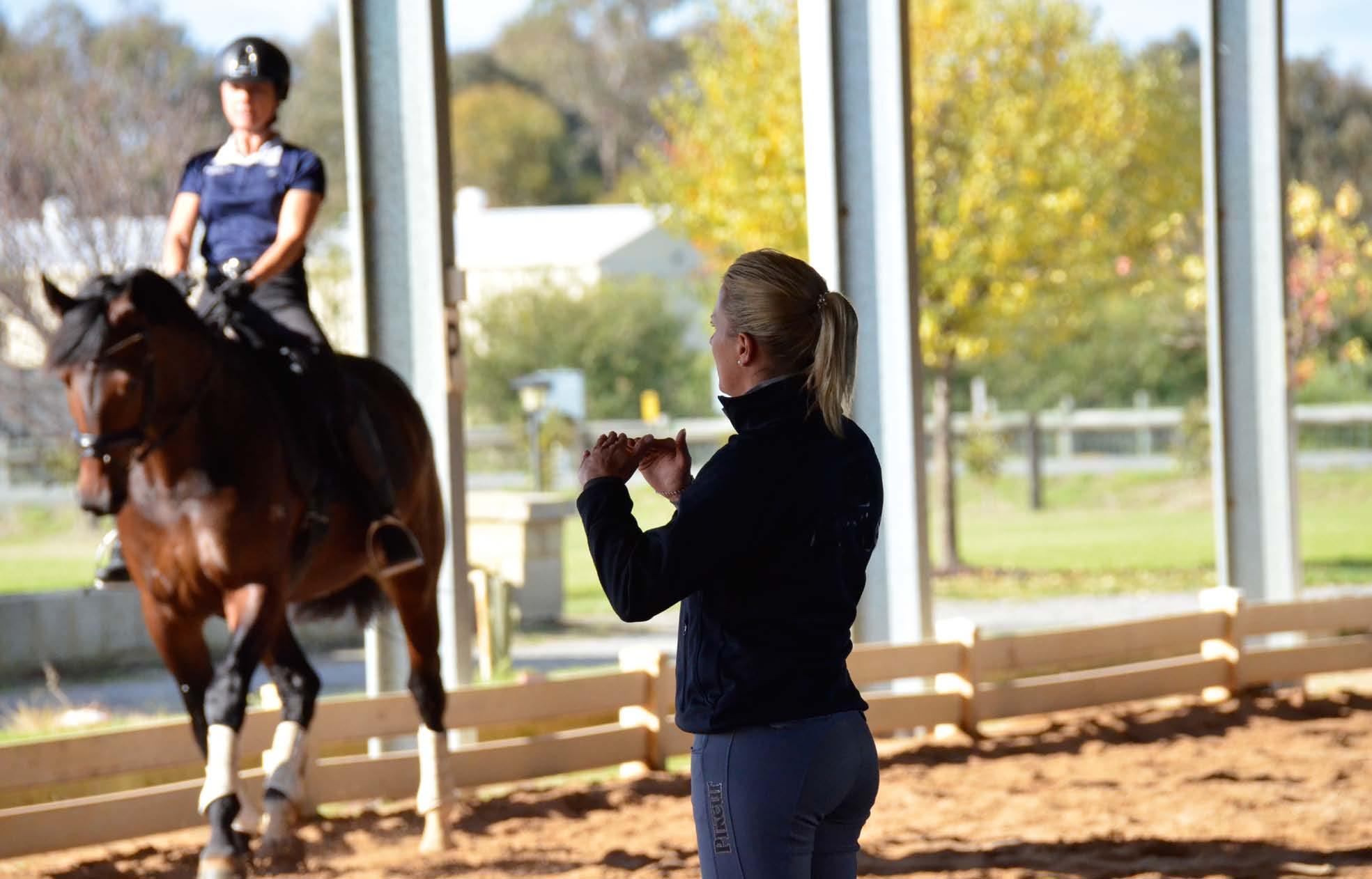
T raining your memor y
T raining your memor y to retain more from your lesson or a clinic
If we really enjoy a lesson but then don’t do anything with what was covered, we’ll forget 95% of what we learnt within 24 - 48 hours.
Using some of these active learning strategies, we can gain a lot more from a fantastic lesson!
 by Wendy Barker
by Wendy Barker
February/March 24 - Page 4
You’ve just had a great lesson (or a great clinic) with a fantastic instructor.
How can you gain the most from the knowledge and skill this trainer imparted to you?
We may leave a riding lesson with our head full of new ideas, only to find we can remember very little of it just a few hours later.
Lots of riders spend quite a lot of money and time on clinics and lessons. A single 45 minute lesson with an international trainer may cost as much as $350.
What can riders do to gain as much as possible from the lesson?
There is a vast array of research showing how quickly we forget, and how much we forget within 24 hours of a learning opportunity such as a riding lesson. The findings are pretty alarming –even when we find the information valuable and relevant, unless we use some strategies, we will forget the lion’s share of it.

Research shows that onetime exposure to new ideas and content is not enough to ensure learners remember key information. It is also not enough to improve skills (skills acquisition).
Techniques To ge T T he mos T ou T of a lesson
1
Spaced repetition – repeating a skill improves that skill performance and verbally going back over information improves recall of that information.
As you drive home from a lesson, go back over the key ideas and techniques that you covered with your groom, or a friend on Bluetooth on your mobile phone. Articulating what you learned is a powerful way to strengthen your retention. This is one of the most valuable ways to reinforce points you learned while they are fresh in your mind.
Chatting to a friend or your groom about what you learned during a lesson or clinic while it is still fresh in your mind is a valuable tool to help retain the information.

2
Spacing effect – studies now show that interspersing practice with rest periods of 10 seconds to a few minutes allows the brain to replay and consolidate learning. Spacing effect is 20 times more effective than endless practical repetition of a skill.
‘Wakeful replay’ (hippocampo-neocortical replay) enhances skills when practice events are separated by brief rests, rather than repeatedly massing actual practice in immediate succession. Capable riders can do this while allowing their horse a brief stretch in walk.
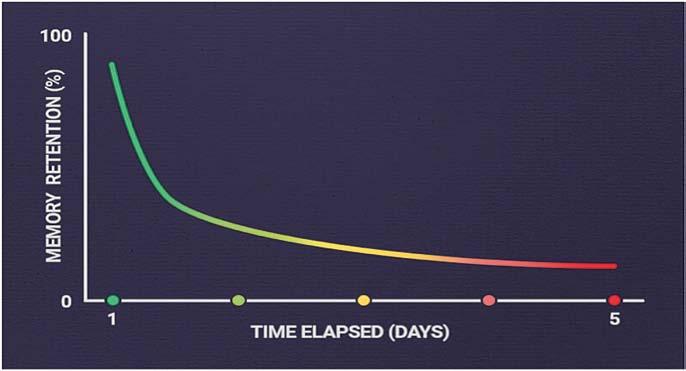
Left: The Forgetting Curve (or Memory Retention Curve) (Ebbinghaus) has a steep fall in the first few hours. Our ability to retain information plummets within 24 hours unless we review what we learned, even if we found the information personally meaningful.
February/March 24 - Page 5
MEMORY RETENTION
Covering key techniques and details many times and in different ways really strengthens retention of skills and knowledge.
3 4 6 7
Simply jotting a few key points on the back of an envelope the same day as the lesson, then using these to write the notes in a little more detail with a heading and date will dramatically improve how much you remember from a lesson.
See sample notes from a lesson at end of article.
Setting a specific goal leads to more rapid mastery of a skill (Romiszowski).
Before the lesson (while driving to the venue), plan specific goals to work on e.g. making a transition clear (e.g. the canterhalt, the canter-walk or the canter-trot). At the start of the lesson ask the trainer for help with this goal.
Learning feedback promotes greater learning.
5 8

After competing or having a lesson, read the comments on a dressage test sheet, or get feedback from ‘eyes on the ground’ from a knowledgeable trainer or fellow rider. This feedback should not simply be: ‘That was right’ or ‘Do it again’, the feedback needs to provide detail related to what was well -executed or poorly executed. Protocol Dressage Days and Jump Training Days can provide fantastic feedback for riders.
‘Overlearning’ is a powerful way to improve and retain skills including motor skills – practice makes perfect.
Repeating times tables in lower primary school is a good
example of overlearning—something we never forget. Motor skills involve specific movements of the body’s muscles to perform a certain task. The nervous system, muscles, and brain of a rider’s body all have to coordinate to achieve the task successfully. The task could be simply rising to the trot or achieving a correct canter depart. Transfer and retention of motor skills are improved significantly by ‘overlearning’.
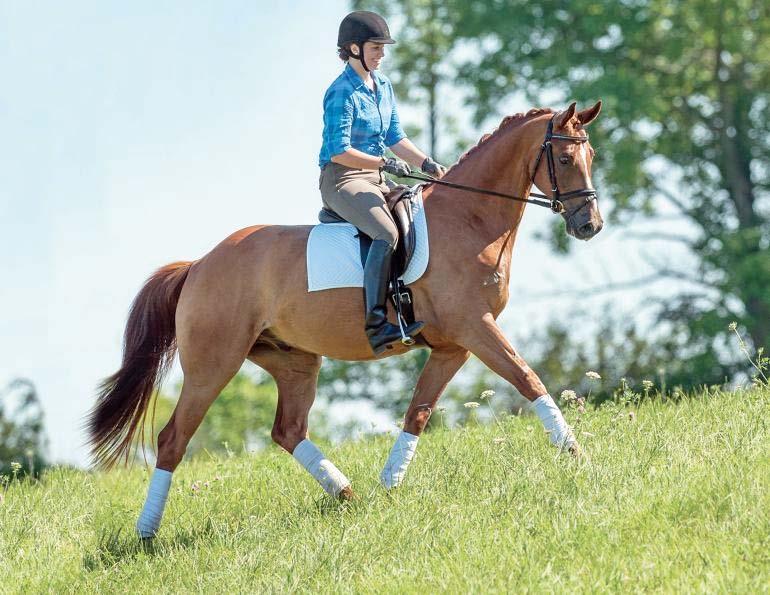
Interspersing practice with rest periods of 10 seconds to a few minutes allows the brain to replay and consolidate learning.
If clear canter transitions on the correct leg are not secure, a rider generally needs to execute many repetitions in a lesson, executing just one clear correct canter transition will not be sufficient to enhance this motor skill.
Elite riders have over 10,000 hours of practice, so their bodies have overlearned almost everything they need to perform at the optimum level.
Overlearning is just as true when a rider is learning a dressage test, or a cross country or showjumping course – going over it many times until they can confidently repeat it out loud is the best way to be sure to recall it under competition pressure.
Spaced repetition – repetitions of new knowledge or skill should start close together, then we

should go back over it at increasingly longer intervals so memories grow stronger and deeper.
When a rider first starts to ask a horse for a change of canter lead, through trot or walk, they will need to practise it frequently to be able to coordinate the sets of different aids. As their mastery improves, they can practise this skill less often.
Filtering – selecting what was important from a body of learning and writing notes about – filtering - is a form of active learning because the learner has to review and actively do something with the knowledge, and this requires higher order thinking.
February/March 24 - Page 6
Keeping a diary or notebook (hand written or digital) of key points taken from lessons is a very powerful way to reinforce newly acquired knowledge. The best way to recollect the key points is following up on point 1 – where the learner talked about key points in the lesson while they travelled home from the lesson with their groom or on the phone to a friend.
Multiple senses (multi-sensory learning) – learning that incorporates visual, auditory, tactile, and kinaesthetic elements enriches the learning experience and strengthens understanding and engagement, as well as memory retrieval of the material being learned. Different parts of the brain are stimulated simultaneously, helping to sustain attention and concentration.
Riding horses should engage all of a rider’s senses. ‘Feel’ is the hardest sense for less experienced riders to develop. Feel could be described as kinaesthetic awareness of what the rider and the horse are doing.
Visual learning.

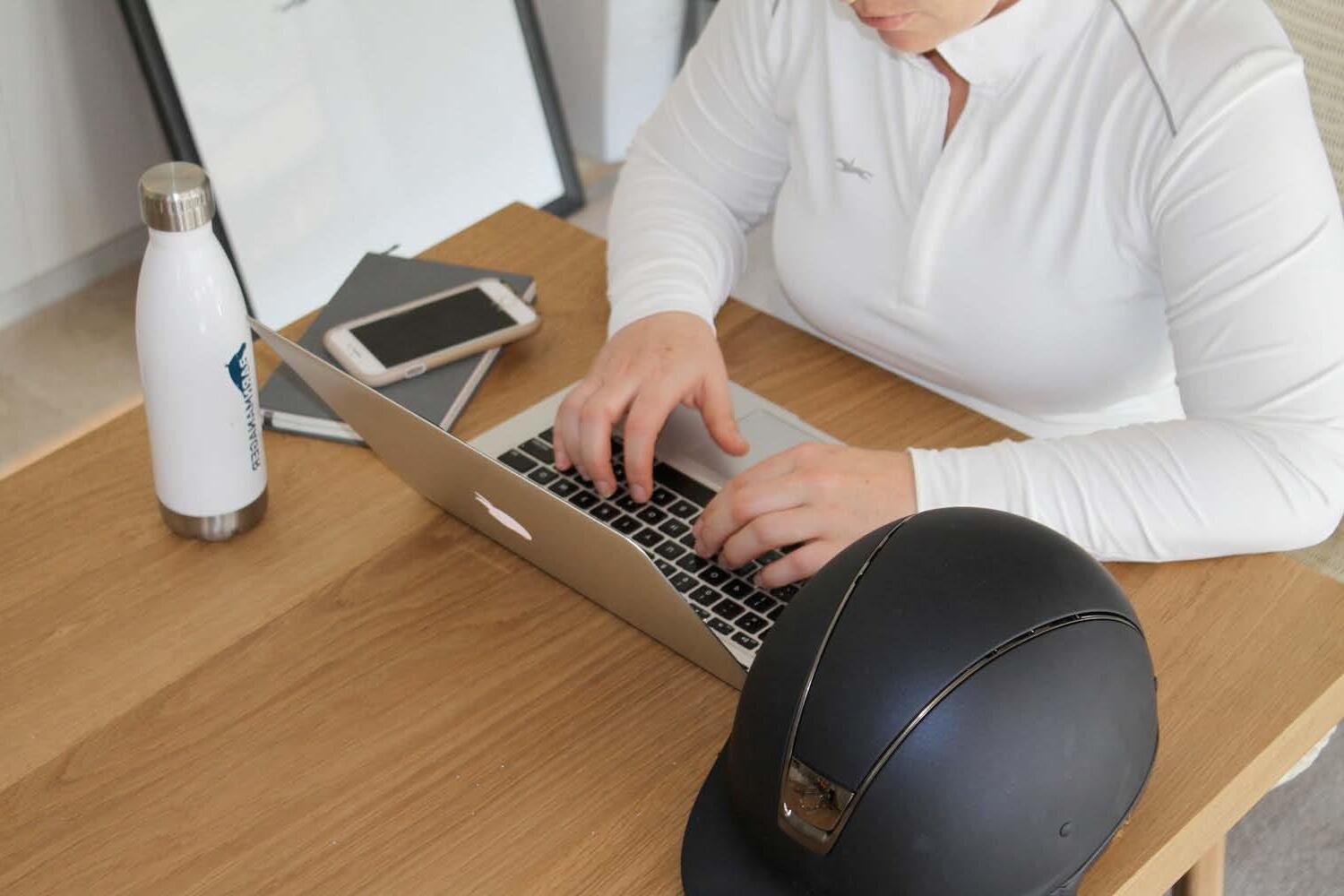
Auditory learning.

Keep a diary of key points from lessons.
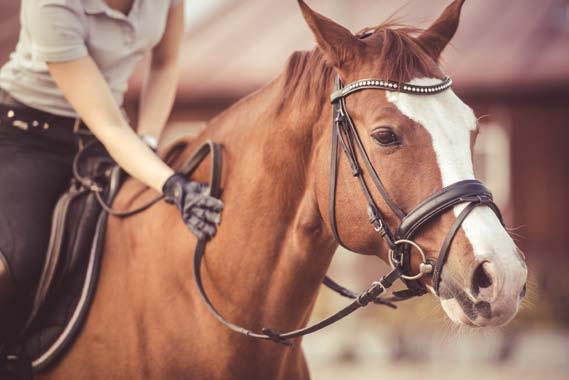
Tactile learning.
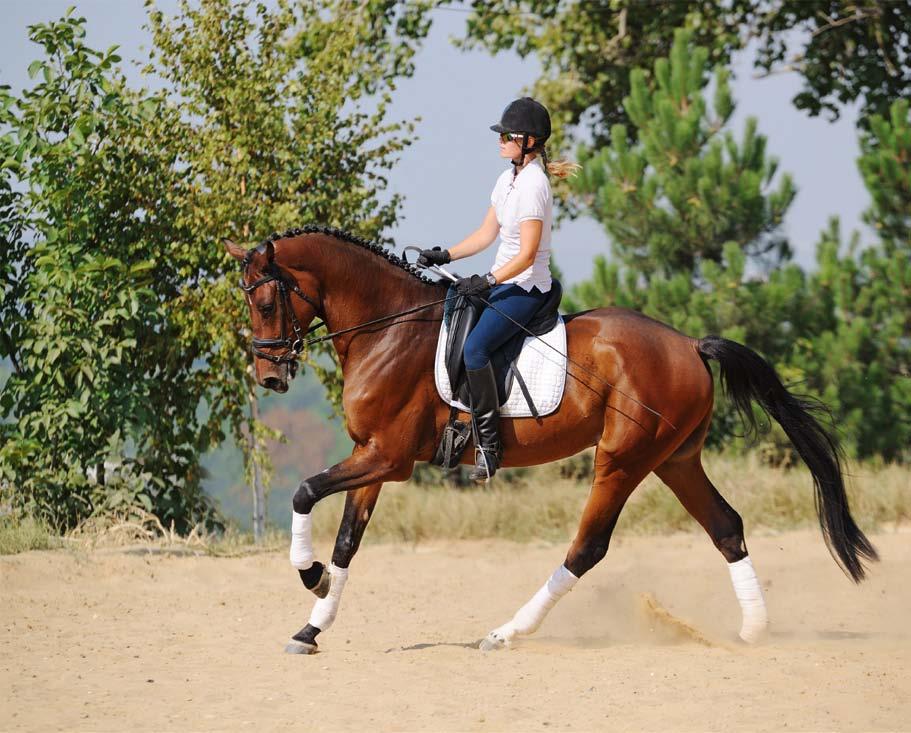
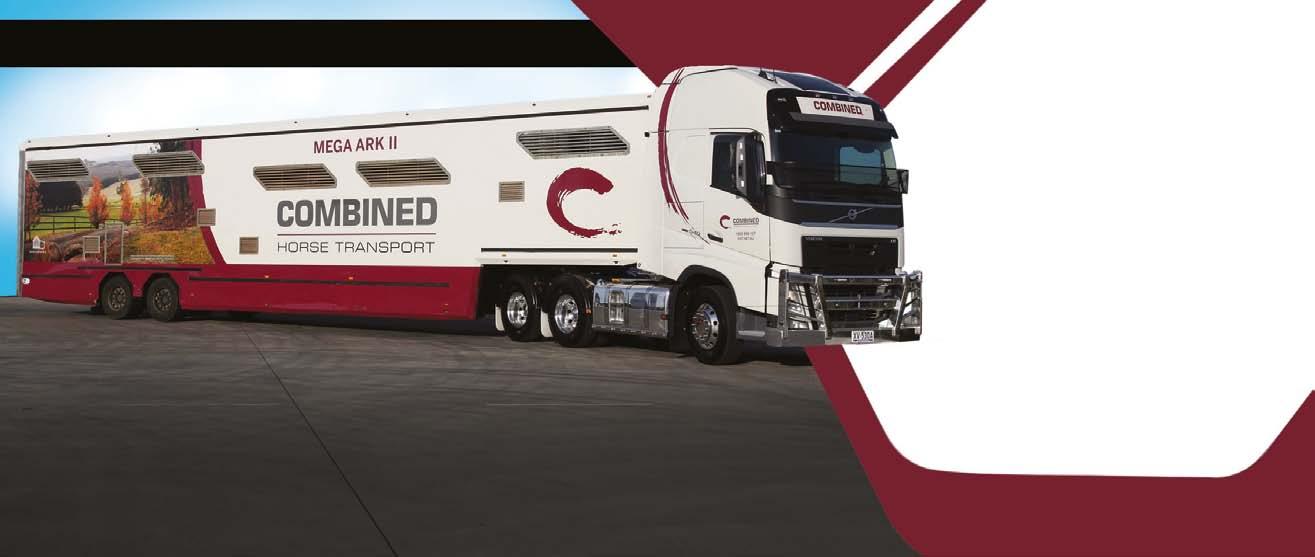
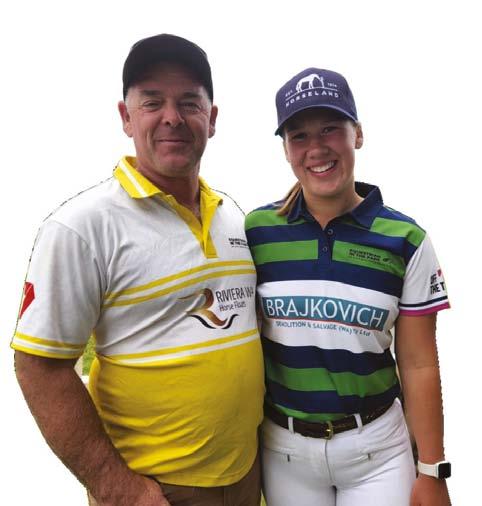
February/March 24 - Page 7
9
Rest stops at Professional Spelling Stations CHT’s Mega Ark Fleet features include exclusive anti hip and tail rub, fans replacing the air every three minutes GPs Tracking - track your horse’s journey on your phone Two experienced and Professional horse People On every Journey ChT.neT.au | Phone 1800 998 157 in early 2023, my transition from long term staff member to business owner has gone incredibly smoothly thanks to the support of many.
and I will continue to deliver the very best in equine transport, ensuring your horse travels in complete comfort in CHT’s state of the Mega Art Fleet. With our hands on approach and commitment to your horse’s welfare throughout CHT’s door to door first class service, we don’t just own the business, we drive it and treat every horse as if it was our own.” Glen Day
The new family behind The business Glen and Isabella Day
Isabella
Continued
i n T eres T ing fac T s
A) The brain processes visual images very slowly. Consequently, the brains of less experienced riders are frequently completely flooded by visual messages that ‘drown out’ the important ‘feel’ messages that their bodies are sending to their brains.
Closing their eyes for a few seconds at a time can help a rider’s brain make room for ‘feel’.
This can develop feel for issues such as:
• “Is the horse drifting left or right?” (in which case I need to straighten him before asking for canter)
• “Is he heavier in one rein than the other?”
• “Is my horse slightly uneven in the trot?”
• “Am I pulling on the reins?”
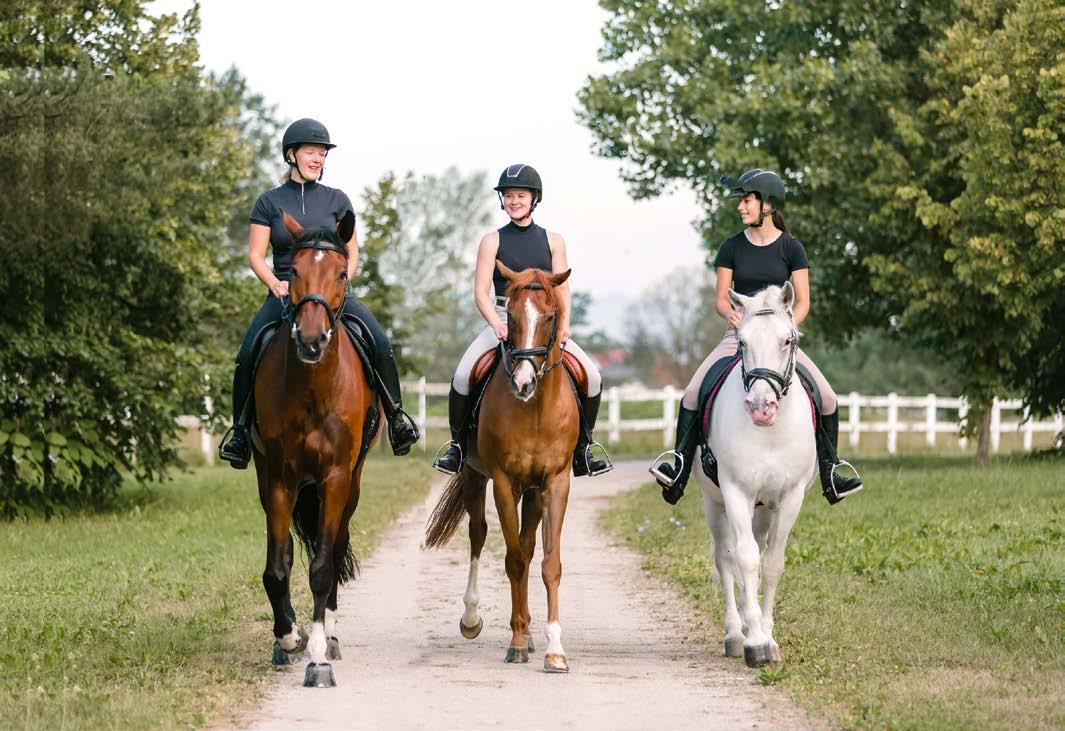
• “Is he active - are his hind foot prints stepping past his front prints?”
• “Is my weight greater in one seat bone than the other?”
• “Has the horse just quickened or slowed his tempo?”
• “Has he fallen out through the shoulder?”
• “Has he swung his quarters to the right (or left)?”
• “Did my half halt achieve a rebalancing of my horse?”
• “Is my horse about to jog in the walk?”
• “Is my horse about to break in his medium trot?”
• “Is my horse about to fall out of canter?”
• “Is my horse about to spook?”
• “Is my horse swinging through the back?”
• “Is my horse light and in self-carriage?”

10
Learning with others is more effective than learning alone – learning by observing others, and by social interaction enhances motivation, and leads to optimal development in adults as well as in children.
11
Watch other lessons by the same trainer before and/or after your lesson. Reflect with other riders on what was learned. In an ideal world, book your lesson on the second and third days of a clinic, and travel there to watch and learn for the whole of the first day Watch a video of your lesson with a coach or friend, stop and talk about some of the key ideas, and/or take notes from the video for your riding Lesson Notebook. These are active learning strategies, much better strategies than simply passively watching the video. In learning skills, sequencing problems from easy skills to hard skills is vital – as a rider’s performance improves, they can successfully progress to more challenging tasks. Trying to progress too fast to more difficult tasks is damaging. It undermines skills learning.
Coaches need to scaffold a rider’s riding skills on to previously mastered skills. Correct sequencing for a rider to learn lateral work would be to build foundation skills first by having them learning to ride a turn on the forehand, then leg yield in walk, then leg yield in trot, then shoulder in in walk, then shoulder in in trot. By contrast, asking a horse and rider to start to ride turn on the haunches when they have not mastered leg yield with the haunches-in, then travers on a long side then travers on a large circle is an example of poor sequencing.
B) Taping over the bottom half of a pair of sunglasses and asking a green rider to wear them
Continued
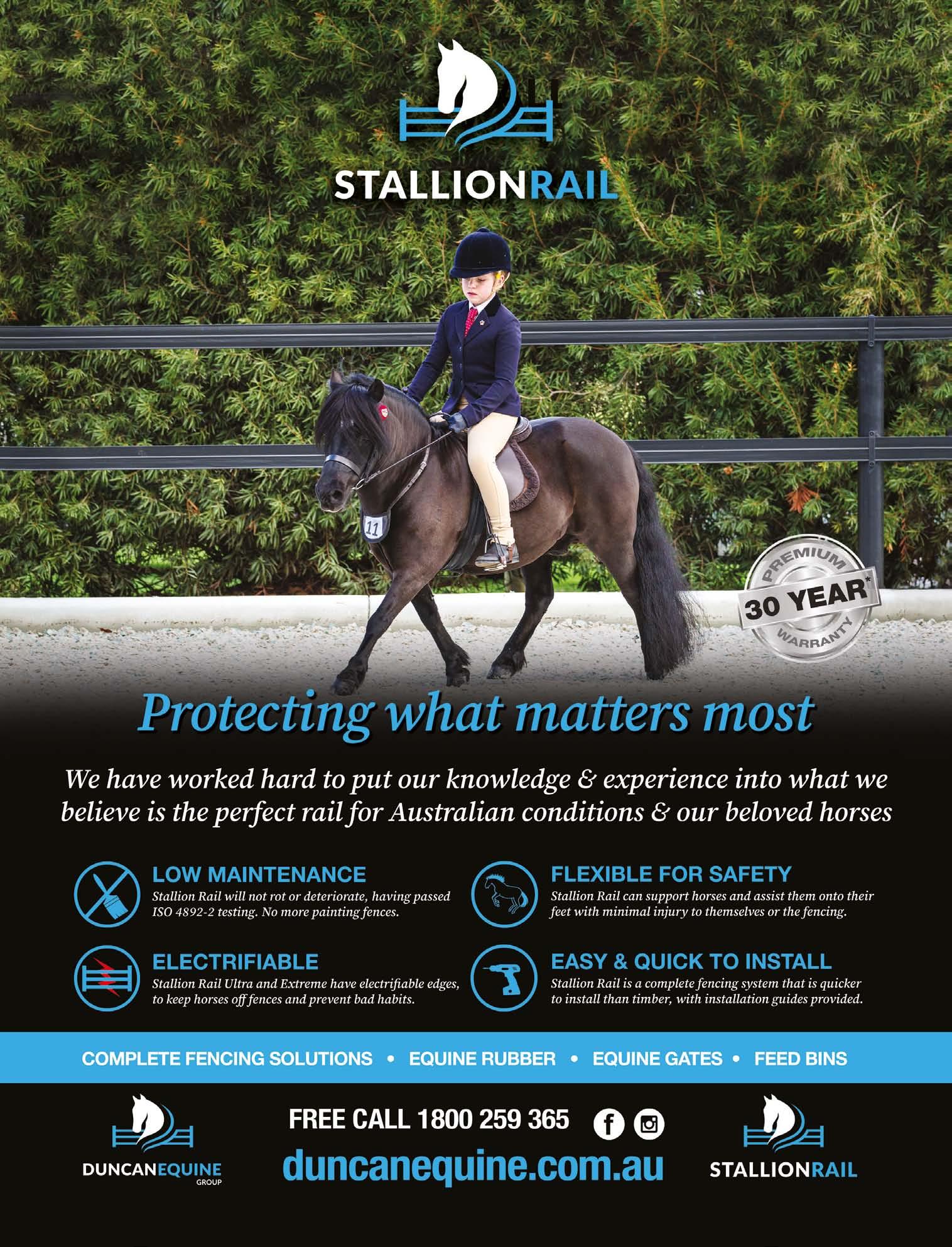
chun K ing
A valuable key for thorough learning is ‘chunking’ - condensing the material to be overlearned into six or fewer ‘chunks’.
Western-educated people tend to be very dependent on written material, so once there are more than six items to remember (whether a shopping list or a dressage test) they are likely to forget some of it unless they overlearn it. This is why we tend to write a list in our phone or on paper. We can however, remember up to six chunks. Each of these big chunks can act as a memory trigger for up to six smaller chunks within each big chunk.
Dress Age - Let’s take a Novice Dressage Test like 2.3 for example:
Chunk 1 – Trot - 5 movements
Chunk 2 – Canter – 5 movements
Chunk 3 – Walk – 2 movements
Chunk 4 – Trot – 4 movements
Chunk 5 – Canter – 5 movements
Chunk 6 – Trot – 1 movement
The longest Dressage Test is the FEI Grand Prix Special. It has exactly 36 movements, so GP riders can ‘chunk’ this into six bits in six big chunks, just as a Novice Rider can chunk a Novice Test into six chunks!
s howjumping - One way to chunk a showjumping course could be to break it into jumps on particular reins:
Chunk 1 – 3 jumps on the left rein
Chunk 2 – 2 jumps on the right rein
Chunk 3 – the combination
Chunk 4 – 2 jumps on the left rein
Chunk 5 – 4 jumps on the right rein
Cross Coun T ry - One way to chunk a cross country course would be by each minute marker (approximately five jumps in each minute marker). A second way would be to chunk it by distance – splitting it into 4 quarters (approximately 5 jumps in each quarter). Another way to chunk cross country would be to break it into location on the course, or different types of terrain:
Chunk 1 – 3 natural straightforward jumps near the clubrooms
Chunk 2 – 4 portable jumps on tracks in wooded uphill terrain, some bigger spreads
Chunk 3 – 4 more technical jumps – water, corner, light to shade, drop, keyhole, coffin
Chunk 4 – 2 jumps on twisty downhill part of course, second water combination
Chunk 5 – 4 jumps in open terrain where it could be possible to make up time
Chunk 6 – 3 straightforward jumps heading back to clubrooms parallel to entry road

Example of how I strengthen my recall to get the most out of a lesson
(I have notes from many years of lessons with great trainers. These notes are invaluable — I like to look back through these to help me solve coaching and training problems.)
FIRSTLy - as I drove home from a Jayden Brown clinic, I discussed Jayden’s ideas with my strapper (I know how much this helps me with my later recall once I’ve finished the horses, showered, and eaten dinner).
SECONDLy - before showering and eating I scribbled a few memory joggers on the back of an envelope.
THIRDLy - I wrote key points from Jayden’s lesson in my internationally.
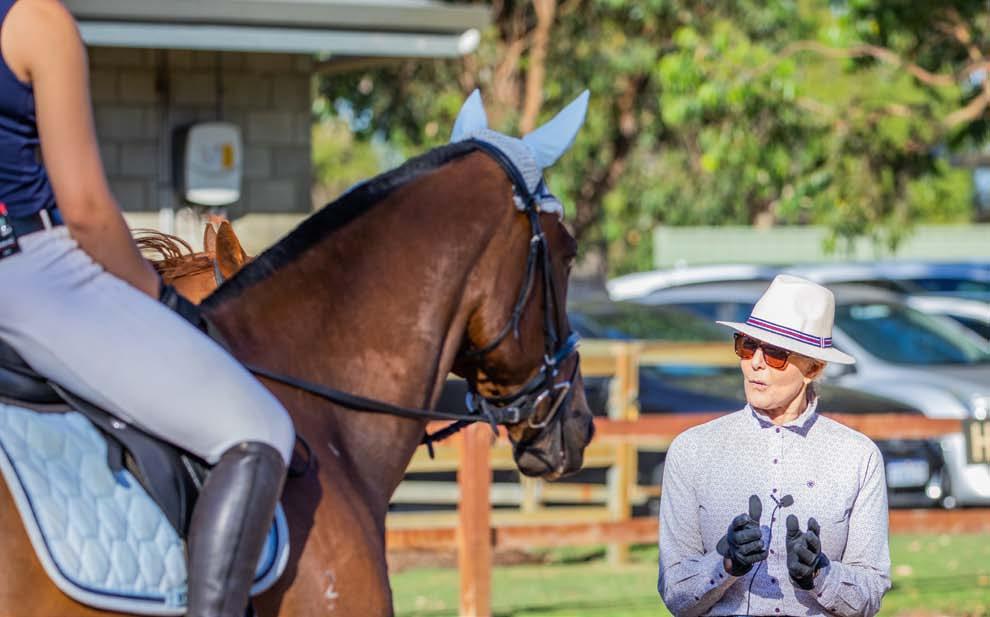
February/March 24 - Page 10
Jayden Brown and Wendy Barker
Sample lesson notes from the Jayden Brown clinic in Nov 23.
GOaLs – improve the tempi changes and canterpirousIfhe’sspookytostart,justholdtheoutside rein and flex him with the inside rein till he givesinthepollandsoftenstogethimmore through tothecontact. Ifhe’snotinfrontofyourlegenough,you havetomakesureyou’renotdoingallthe work!Insteadofconstantlyhavingtoremindhim togoforward,takeyourlegoff,andwhen hestops,immediatelymakehimtrot–i.e. negative reinforce his inadequate response fornottakingseriouslyhisresponsibilityto goforward.
Tempiflyingchanges(FCs)
Canter on the track. Leg yield 1-2 m to the insidethenaskforachange,thenlegyield back to the track and ask for FC. Repeat, repeat.Thisgiveshimmoreroomtobringhis frontlegthrough. Raisethenewinsidereinbothupandoutjust fortheactualFCtogivehimroomtobringthat frontlegthroughmore.
On the track ride a gentle continuous ‘s’ bend of about 1m out and back to wall. ask for the FC betweenthecurvedpartsofthe‘s’. Canbehelpful fortempichanges.
ExERCIsEs
Canter–strengthenandreactivenessexs.
Fwdandbackon20mcircle
Fwdandbackonlongside
asaGEnERaLpRInCIpLE: ifhechangeslatebehindputhis1/4stothe sideyou’reaskingforthechangetolighten lightentheloadonthatfrontleg.
Howsmallcanyoumakethecanter?
Howmanyofthosesmall cantersteps canyoucreate?
Travers in canter on long side – many



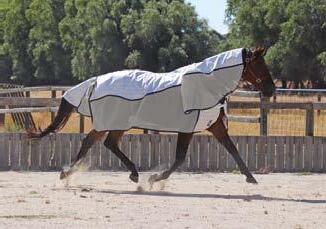
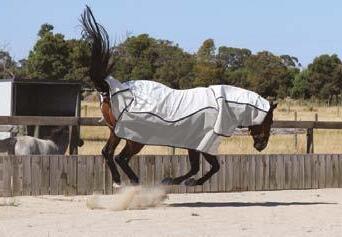
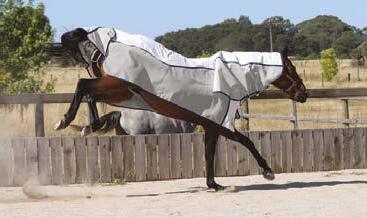

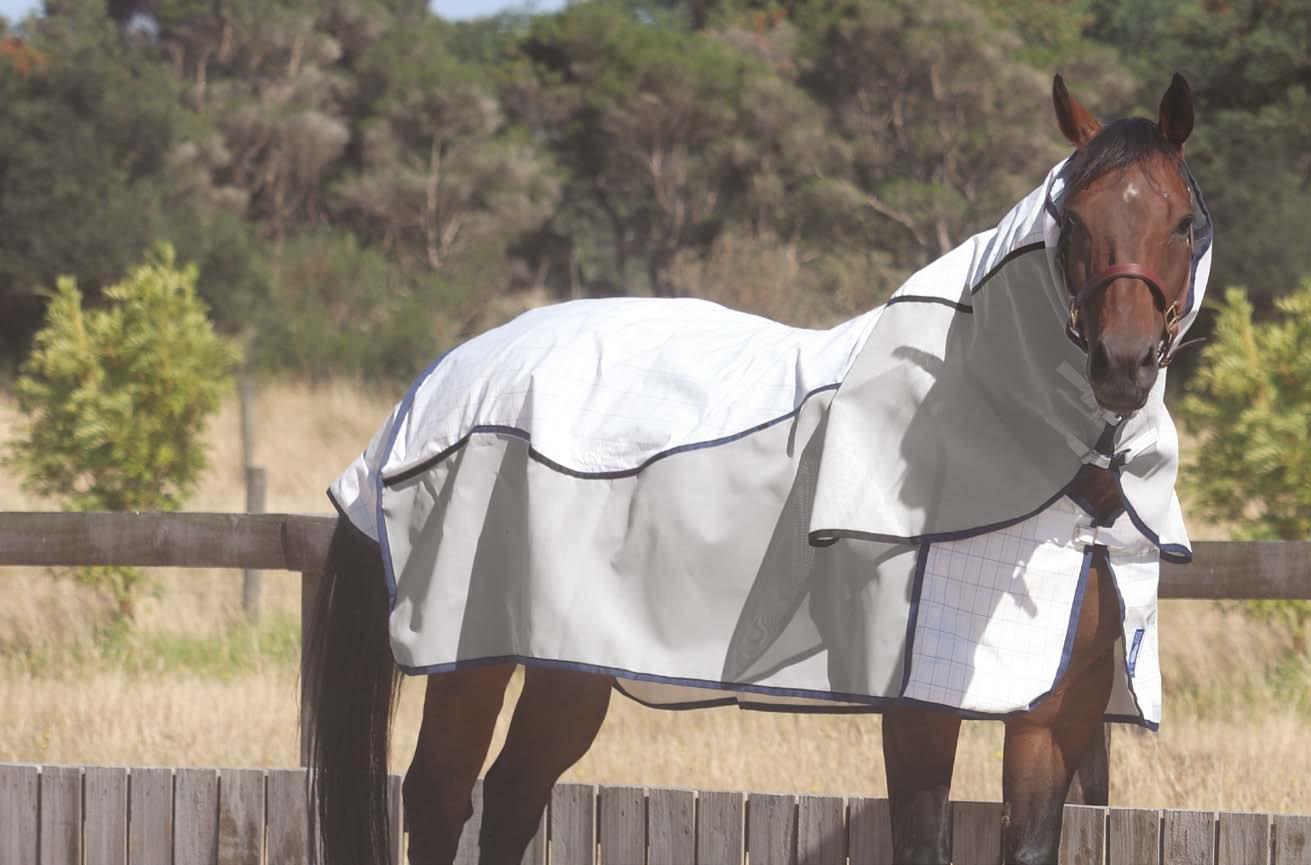
February/March 24 - Page 11
Summer comfort in affordable, a u S tralian made quality rug S . We’ve got them covered Phone 03 5940 9484 www.skyeparkrugs.com.au Whatever they’re doing... 100%australian made forconditionsaustralian

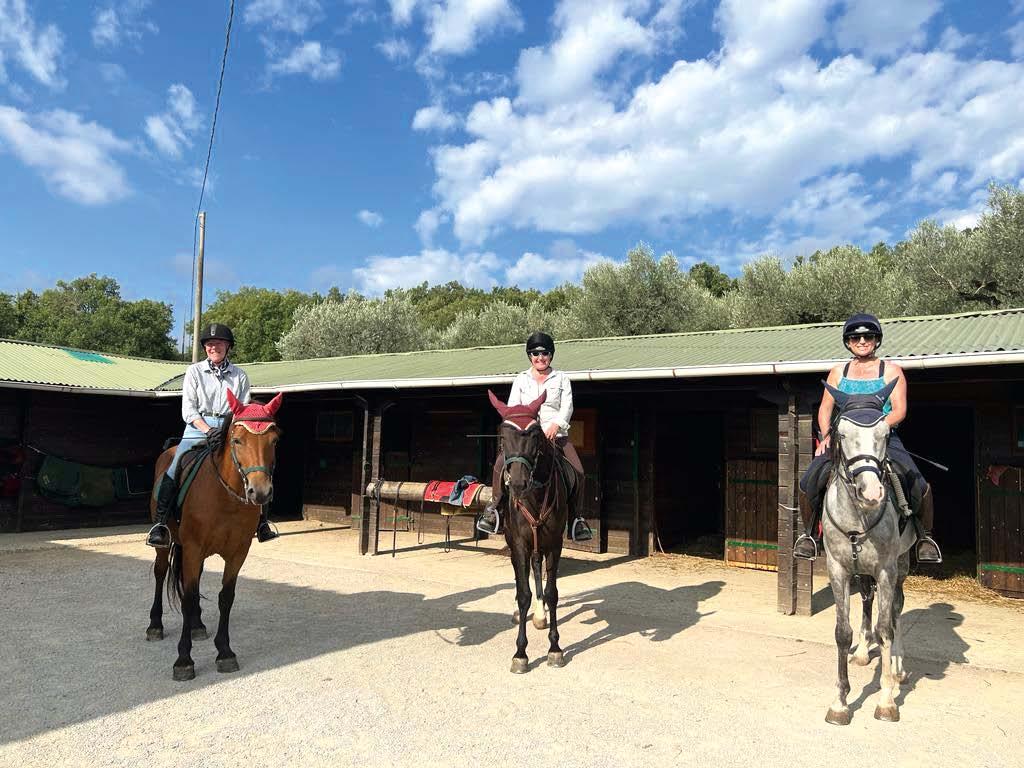
A taste of
TUSCANY
BY DENISE LEGGE
Prior to 2020, horse riding holiday travel enthusiast Denise Legge was a regular contributor, sharing her travel experiences from a range of destinations as she regularly incorporated a European riding holiday with a trip to the UK to see relatives and friends..
These features invariably included information about the horses, history of the area, interaction with locals and fellow travellers and a wide variety of food and beverages from the regions.
A pelvic fracture and COVID put a stop to her travel for a few years but after a total hip replacement (THR) in January ‘23 she was back in the saddle by April and had plans for a September UK visit with the added bonus of a riding holiday.
All Denise then had to do was research her next
Denise and her riding companions in Tuscany, Italy.

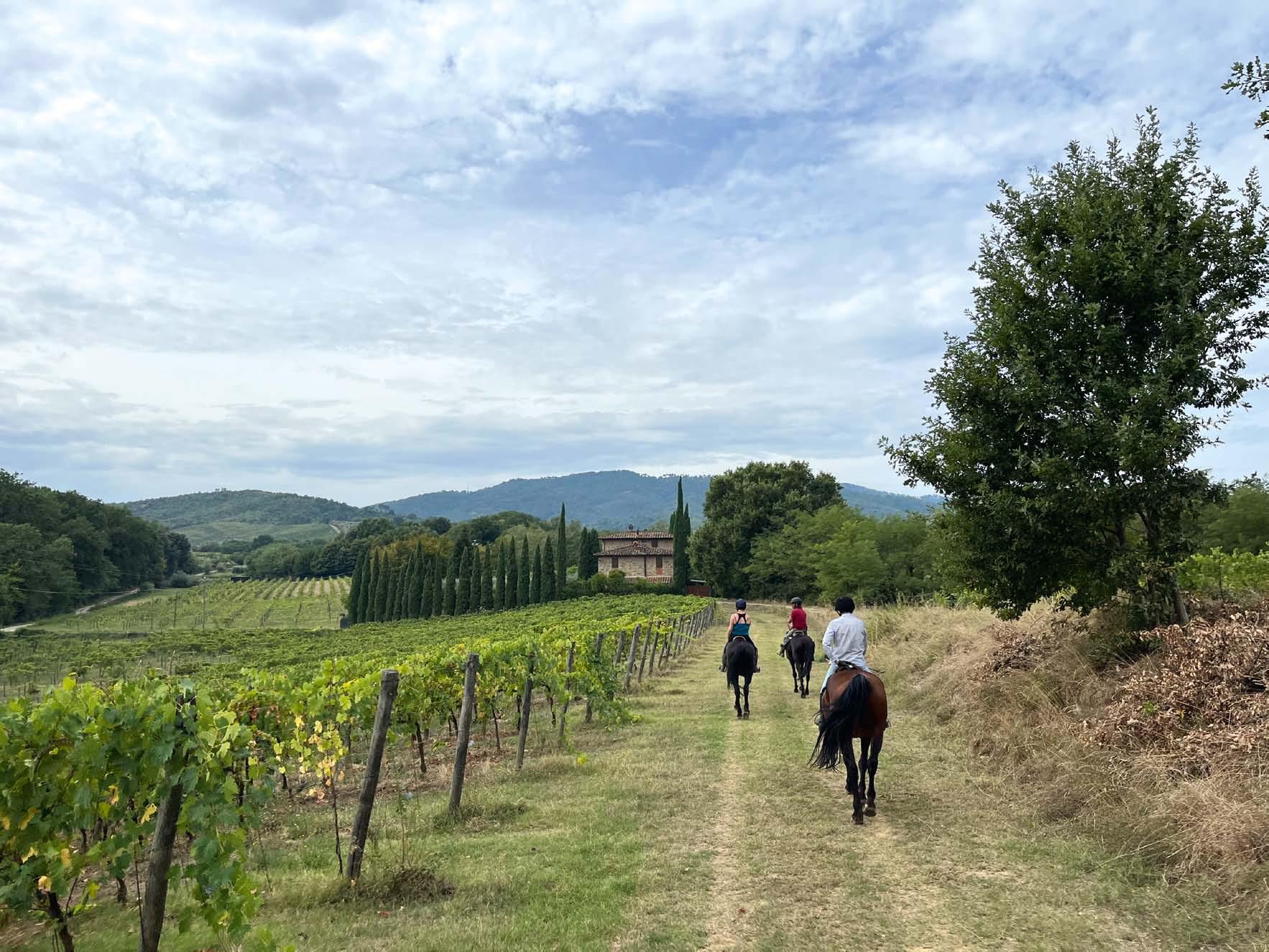
“The challenge with this holiday was to find one that ideally fit my time frame as I had recently started work at Denmark Agrigulture College helping out in their Equine program, plus, ideally the ride needed to be in a country I hadn’t ridden in before.
I was also well aware that unlike some of my other riding holidays I would probably not be fit enough for a 25 to 30km ride each day.
Searching through the FarandRide website I came across a four night/three day riding holiday in Tuscany. Two half-day rides and one full day ride, mostly at the walk with some short stretches of trot and canter. Perfect!
In preparation for this riding holiday I rode
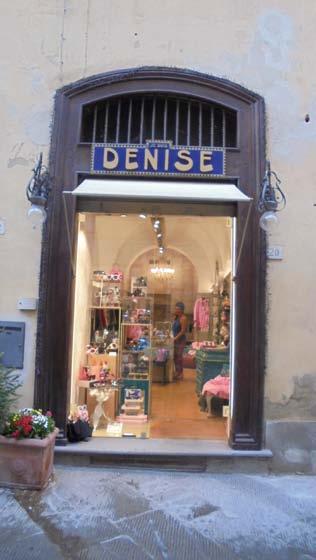
I managed the rail transfer from Pisa to Montevarchi-Terranuovo with no trouble and was met very efficiently by Eraldo (our guide and Riding Centre manager) and Heidi and Sasha, both part of the Riding Centre support crew.
In 10 minutes or so we were at Rendola Riding Centre. My accommodation was a delightful villa in the typical Tuscan style; comfortable bedroom with en-suite and heaps of books on hand to read. Eraldo has managed Rendola for the last four years, though COVID had put the brakes on some of his plans for the establishment. Eraldo gained his BHS Instructor qualification in the UK and is a fount of knowledge concerning the local flora and fauna. Though claiming crocodiles were my two Standardbred mares until my grass arena became too wet to use.
Knowing that fitness was important I booked additional riding time at a local stables and spent 10 to 15 minutes three times a week doing riding exercises on ‘Trojan’ the super, wooden saddle stand my husband had built after watching a riding DVD.
The weather in Tuscany looked as though it was pretty much on a par with the weather in Denmark, Western Australia so that made packing much easier. Getting there involved flying to Heathrow (UK), an overnight hotel and then a low budget flight to Pisa (central Italy), which was seemingly packed with cheerful Londoners off in search of some sunshine.
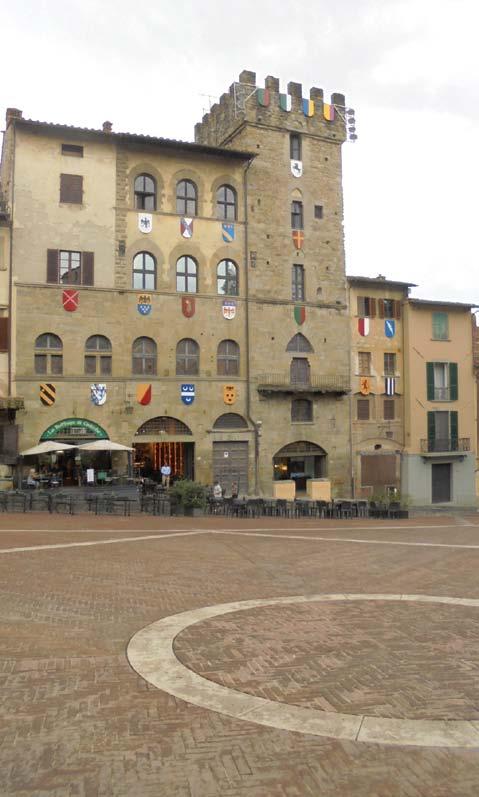
resident in the few lakes we passed might have been stretching a point!
The riding centre was originally established by Jenny Bawtree in 1969 and she still lives in part of the villa. On my first evening Jenny very kindly offered me a glass of wine as we sat in the warmth of the late afternoon sun on the terrace. Well, what an amazing lady. Jenny was certainly a pioneer in terms of establishing a riding centre and managed to partner this with a career in academia as well.
Isabelle, the cook, set the standard from the get-go with a beautiful meal and later on we would glean a few tips from her in terms of Italian cooking. Continued
February/March 24 - Page 13
Denise was sure this shop was named after her. a very medieval feel in the town of arezzo.
Along with me on my short holiday were Cathy Holloway from FarandRide and her friend Lara. So it was a quite intimate little gathering. It is good to know that FarandRide regularly check out their destination offerings.
The next morning we were allocated our horses, which were a mixture of breeds with a strong dash of Sicilian. On average they were about 15hh and generally willing, quiet and sure-footed. My ride for the first day was Rosa, so called because of a rose shaped star. A real sweetie but her canter was a little upright.
However since most of the ride was spent at walk interspersed with short stretches of trot and canter I didn’t mind at all.
VINEyARDS AND TERACOTTA ROOFED HOUSES
The countryside was just as I imagined with acres of vineyards, olive groves, country lanes, Lombardy poplars and terracotta roofed houses. It was refreshingly unspoilt and very typical of the area. A few of the vineyards were fenced off to deter both deer and wild boar. On our rides we spotted a few deer effortlessly leaping amongst the vines. And early one morning Lara was woken by some strange snuffling noises outside the villa and in the half-light reckoned it was a wild boar.
COOKING ITALIAN STyLE
After lunch and a break we were treated to an Italian cookery lesson under the watchful eye of Isabella. On the menu were ravioli and tiramisu. I never realised that pasta, from scratch, was such hard work! Needless to say it was very satisfying knowing that when we sat down to supper we had played a part in the meal.
Though we couldn’t claim any credit for the fantastic main course: saddle of rabbit stuffed with pork.
route. Now at this point you may well be asking why wasn’t I using my phone to take photos? The answer is simple - I did not have a ‘smart’ phone - yet!”
After lunch on day two we had a short break before setting off by train to Arezzo. The town has a very medieval feel to it. Jenny Bawtree, our history expert, was able to tell us more about its history. We had a guided tour and ended up at the famous square for drinks. I found it odd that the main square should be on a slope. And that was not the effects of our Aperol cocktails! Arezzo is probably most recognisable as the location for the movie ‘Life is Beautiful’. As to be expected there were a vast number of small shops; some selling souvenirs and others that looked interesting and quite classy. I even managed to spot a shop called by my
name.
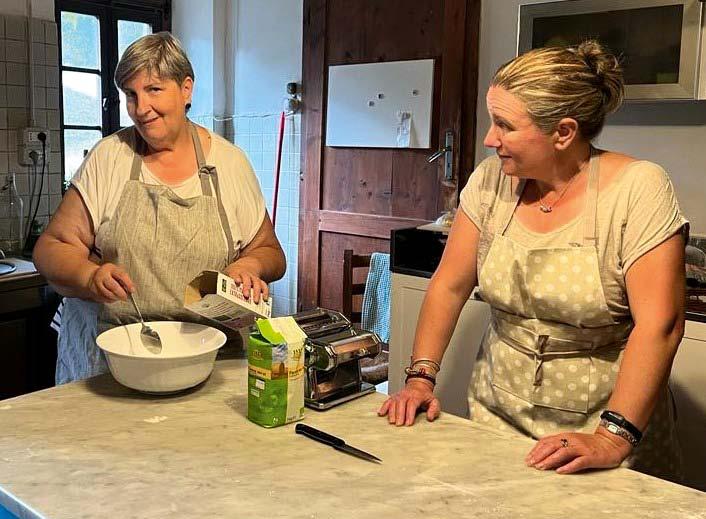
an Italian cooking lesson showed just how long it takes to make pasta from scratch.
The trails often opened up to spectacular views of the countryside as we wandered through small villages.
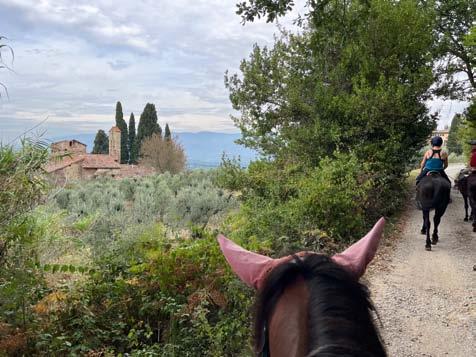
On my second day I was allocated Maya. Very similar in size to one of my own mares but a bit stubborn. Maya had spent time at a number of riding centres and could be described as sour but under the expert guidance of Eraldo was rediscovering her role as a safe trail horse.
The mare was quite stubborn; and when it came to trot and canter I found myself working harder than her. This was solved by waiting until the other horses disappeared around the corner and then let her go, which worked a treat.
LOST CAMERA
During our morning ride I managed to lose my camera (again! - I had done this in Croatia when cantering on a long stretch, the camera fell out of my saddle bag only to be run over by a tractor. Luckily a young lad found it and took out the SIM card and eventually this found it’s way back to me).
For this trip I had packed the camera in a small first aid bag (red), which was lucky as we were able to spot it when we retraced our
We had a couple of mishaps with the train back but eventually enjoyed a superb pizza in Montevarchi-Terranuova.
Day three was our big ride. Eraldo took us to Galatrona Torre, which is a 27-metre high sandstone tower with Etruscan origins some 500 metres above sea level. Much feuded over in the 14th century, the tower is now restored and is what remains of a once important castle and medieval power base.
On route we passed a snail farm as well as olive groves, small vineyards and old buildings. We stopped at an award-winning vineyard for an alfresco lunch and wine tasting. Our stay was extended due to a thunderstorm, which is not untypical at this time of the year. While we completed the last couple of hours ride feeling slightly damp the horses were great in terms of trotting through the villages in the dusk. It was only when we passed a metal cross marking the spot of Enricho’s death that I realised we were close to Rendola. Enricho was a local old man who collapsed at this particular spot and although buried elsewhere his point of demise was marked by a distinctive metal cross.
Needless to say we returned to another great meal prepared by Isabella and spent what remained of the evening wishing we had another day of riding ahead of us. Alas it was not to be and early the next morning Heidi drove me to the railway station for the next phase of my holiday: visiting the UK.
Putting aside airfares the whole cost of the holiday worked out to be good value: four nights accommodation, all meals plus wine and 10 hours riding, tour of Arezzo and authentic Italian cookery lesson plus free transfers to/ from the local train station were all included in the quoted price. So other than a tip for Eraldo, our hard working guide, and the support crew I didn’t spend any other money.
Rendola Riding Centre also offer longer based holidays (7 days) and I would full heartedly recommend this centre as a great way of enjoying a Taste of Tuscany.
February/March 24 - Page 14
A taste of Tuscany continued...
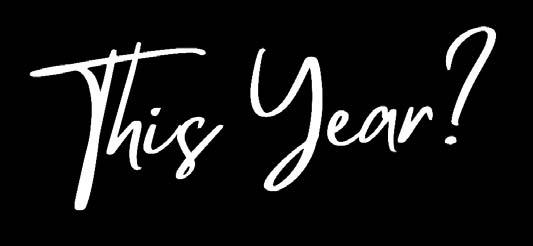

EEBW Certification
Our signature EQ100 Equine Body Worker Certification course is presented by Raquel Butler, DVM.
Feb. 12-20, 2024: Cootamundgra, NSW
MarCh 18-26, 2024: Oakbank, Sa
JaN 6-14, 2025: Taupo, New Zealand
MarCh 17-25, 2025: Cootamundra, NSW
May 12-20, 2025: VIC; exact location Tba
OCT 19-27, 2025: Oakbank, Sa

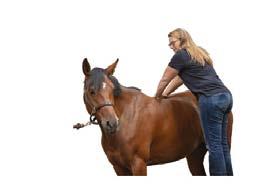
Myofascial Release
A favourite of students with Ruth Mitchell Golladay, PT. Level 1 and 2 are designed to take back to back.
DeC 9-13, 15-17, 2024 eQ1100 and eQ1110 Taupo NZ
Feb 6-10, 12-14, 2025: eQ1100 and eQ1110 Oakbank, Sa


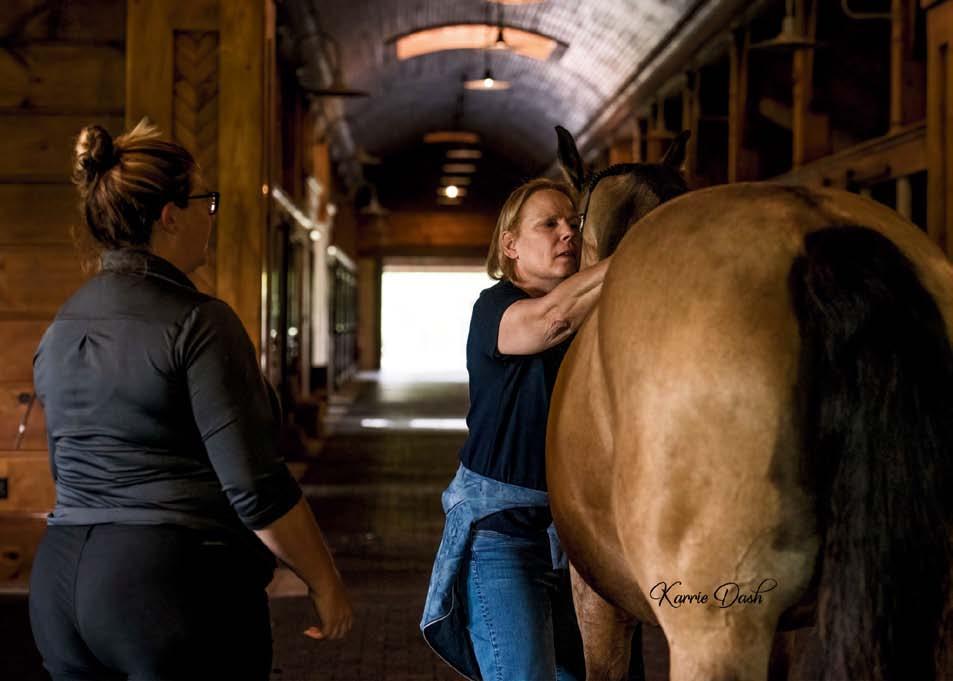
Adv. Soft Tissue Techniques, Spinal Mobilisation, Rehab Concepts and Clinical Reasoning
Take your work to the next level with Dr. Nicole Rombach and Debranne Pattillo!
Feb 22-26, 2024: eQ103: Cootamundra, NSW
Feb 2025: eQ103: exact date Tba. Taupo, NZ
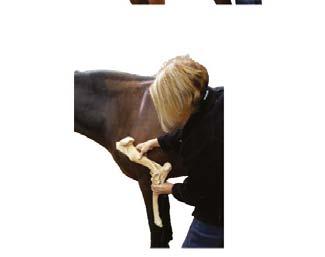
l 22-28, 2024: eQ900: anatomy in Clay with Megan Kanz, MeebW, Taupo, NZ
14-17, 2024: eQ300-600: biomechanics, Gait abnormalities lameness with Dr. Marc Walton, Cootamundra, NSW
l 28-30, 2025: eQ1700: Taping with Dr. butler level One, VIC 2-3, 2025: eQ1710: Taping with Dr. butler level Two, VIC 2025 Tba: eQ1200: equine Craniosacral Therapy with Dr. Sandra howlett: Cootamundra, NSW




SECURE YOUR PLACE NOW WITH A DEPOSIT
www.equinologyaustralia.com | www.equinologynz.com | equinologyoffice@gmail.com
And more for you!
Visit the websites for more information or email:
Zarah] From dancing on the stage to dancing in the saddle
By Deidre Rennick

Ifirst met Zarah Lont from Traralgon, Gippsland, Victoria at a five day camp with Sandi Simons in Drysdale in 2015. A slight young woman with a dazzling smile it was obvious that she had some speech, balance and mobility challenges.
Thinking this was likely to be cerebral palsy, a condition she would have had from birth, I was so impressed by the strength and confidence she brought to our round table. One of the features of a Sandi Simons’ clinic is the “round table”. Not a round table at all, a group of about eight women sat nervously around a long table, cupping steaming coffee in their hands, and waiting their turn to talk about what they wanted from the clinic.
With Sandi gently asking questions to dig deeper into our fears and dreams (as this was a confidence clinic for nervous riders), many a tissue was grabbed from the centre of the table. Back stories were told that showed many of us had prior bad falls, years away from riding or personal challenges. When it was Zarah’s turn, her story was much more than I expected. This is her story –one of persistence against the odds.
Contrary to my initial assessment Zarah had not had cerebral palsy from birth. She was an active child and began ballet from an early age. By the time she was 14 years old she was seriously pursuing a future in ballet. Practicing twenty hours per week and competing in solo and troupe competitions she was also working towards her top-level ballet exam.
One practice she noticed her balance was off. She started to struggle with her performances but had no idea why. Four days after her 16th birthday she was hospitalised for two weeks with cerebellitis (inflammation of the balance and coordination centre of the brain) and while in hospital, developed symptoms of meningitis. Whilst she recovered from the meningitis, the cerebellitis had left her with a range of effects including balance, coordination, spatial awareness, and vision problems.
Things went from bad to worse when two years later (year 12 at school) she was diagnosed with Hodgkin’s Lymphoma and was given chemotherapy for six months.
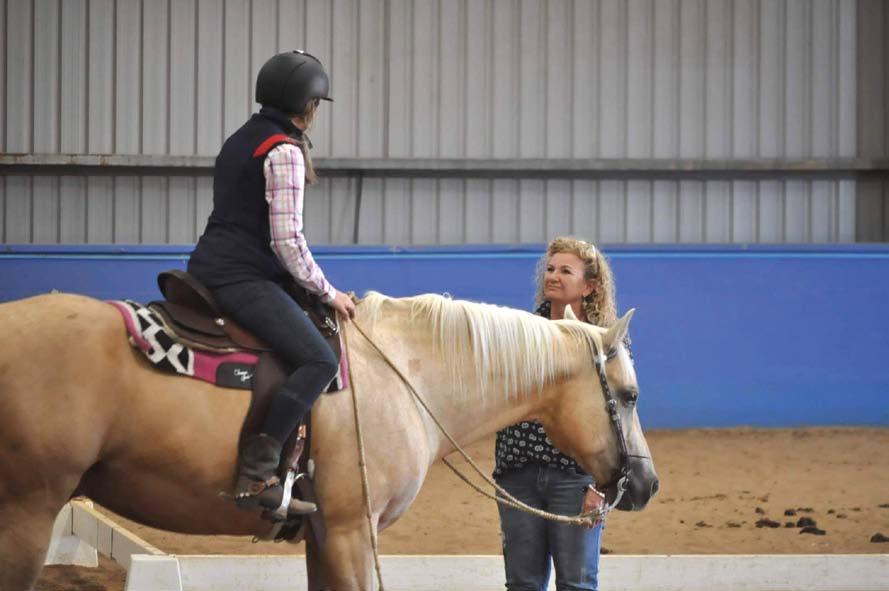
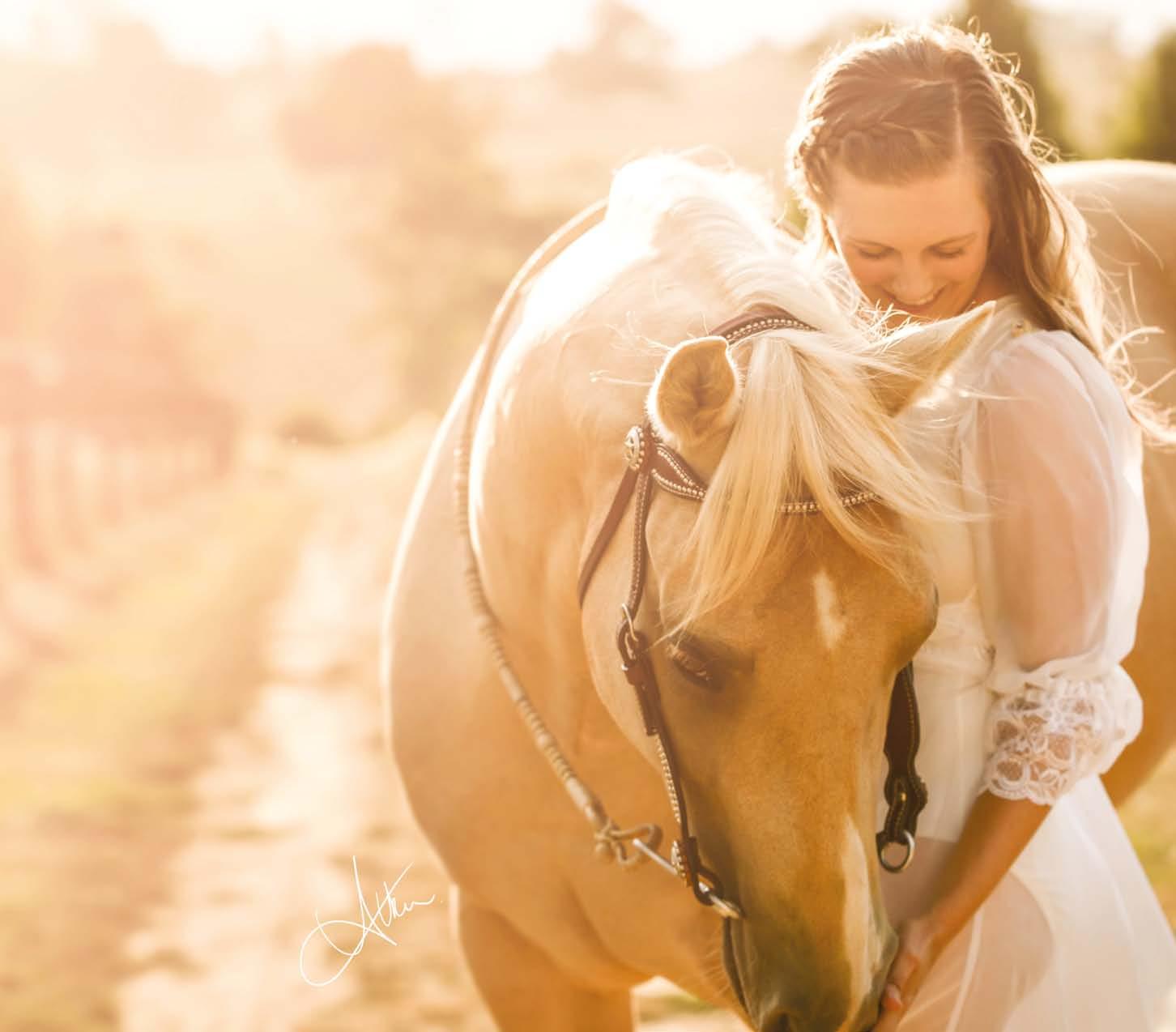
February/March 24 - Page 16
Photo by Jessica Atkins Studio.
Always the optimist Zarah believed she would eventually recover and return to ballet. Unfortunately, the damage to her brain did not resolve and after five years Zarah was resigned to living with a permanent disability. Whilst looking into rehabilitation options Zarah learnt about horse riding as therapy. Having had no prior experience with horses she was interested in the idea of horse riding to experience the joy of moving she got from ballet. Her boyfriend at the time was experienced with horses so suggested she buy a horse and he would teach her to ride.
So along came a brown pony called George. Zarah progressed in her confidence to be able to sit and walk on George. Zarah and George had only been together four weeks when another blow struck with the relapse of her lymphoma. Zarah was only 22 years old and in the final year of her speech therapy degree. She was lucky to have good friends who stepped in to look after George whilst she went through another round of treatment.
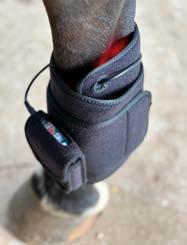


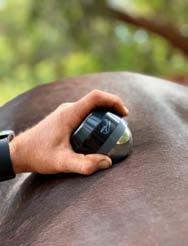

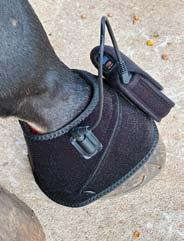
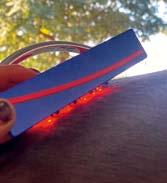
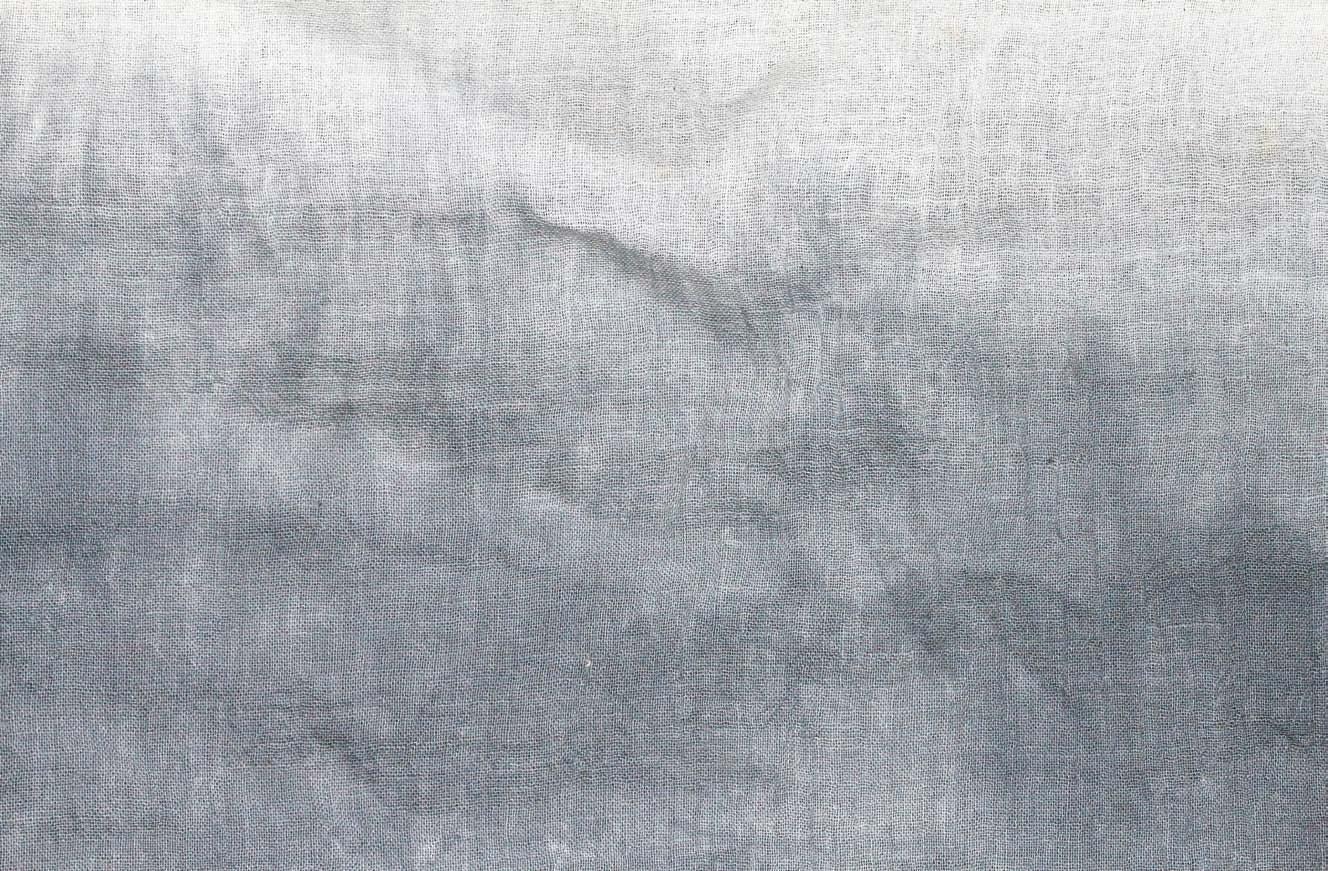
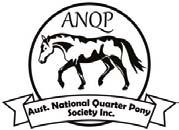
Zarah now had the yearning to learn more about riding and to progress. After she recovered from her last chemotherapy, radiotherapy, and stem cell transplant, Zarah joined her local Riding Develops Ability (RDA) group. There she was inspired by her coach Sheridan to consider para-dressage. Dear George had done his job of showing Zarah the joy of horse riding, but he wasn’t a dressage pony. Zarah moved onto a Welsh Pony called Damon and after getting her confidence built on a new horse she went for her para-dressage classification.
Due to her natural posture from years of ballet she performed quite well in the static test environment. What it didn’t show was her reality that when the horse started moving beneath her, her vision and balance problems intensified, making canter a risky and scary gait, even with allowed supportive aids. Damon proved to be a bit narrow and unable to support Zarah’s balance, so she moved onto a young mare called Dee. Even though Dee was a lot more supportive and had more even movement than Damon, the inability to canter was always going to stand in her way of competing under her para-dressage classification. This led Zarah to make a decision that would once again change her direction in life.
Ever since that first clinic, Sandi Simons had remained involved with Zarah as a coach and mentor, and Zarah would attend as many

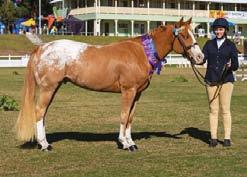
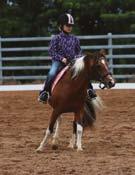

February/March 24 - Page 17
Order online www equinetherapyproducts com au oR find us on facebook and instagram Reliability & Results Driven All our products are designed by therapists or thoroughly vetted by therapists, vets and high performance riders to make sure they perform as required Handheld Therapy Devices From Red/Infra red torches to torches ranging from 420nm Blue up to pulsing 900nm NIR, Class 2 3B and 3R Spectravet Lasers as well as handheld PEMF units we have something for every budget Whole Body Therapy As well as hand tools we offer whole body therapy such as red/infra red systems that go from head to tail ActivoMed Rugs, Theraplates, Red light bays and more Massage Tools We have a variety of massage tools available from our 360 rotating Theraball that can be used for cryotherapy and thermal therapy as well as a range of stainless steel & magnetic gua sha, Red, Infrared & Blue Therapy Pads The Equine Therapy pads contain both red and infrared diodes of 660nm & 850nm or hoof wraps with Blue and Infrared diodes of 850nm & 420nm Register your Western Type Pony with the Australian National Quarter Pony Society www.anqpsociety.com uarter Ponies for all riders and disciplines! Smart Versatile Trainable Love Ponies? If your pony stands between 11.2 & 14.2hh and is of Western Breeding or Type, check for their eligibility today! Lifetime Registration of your Pony. Rewarding and Inclusive Awards Program. Photo credit: Lydia Plim Photo credit: Hoofprintz Photography Photo credit: Crystalyn Jones Art - Photography Photo credit: Chris Seen
clinics and lessons as she could despite living four hours away. Sandi suggested that Zarah might like to give para-reining a try. As it’s a self-classification system Zarah could elect to only walk and jog in competitions. Whist Dee tried her heart out during training and early competitions she was not built for reining. However, Sandi knew she had the right horse for Zarah in a stocky palomino called yogi.
Master saddler Shaw Palmer and Sandi collaborated to custom design and build a saddle specifically for Zarah and Yogi. This saddle gives Zarah a more stable deep seat and has allowed her to perform more difficult manoeuvres that were previously not possible, such as lateral movements and obstacles.
Fate once again stepped in just as Zarah and yogi were starting to develop a meaningful partnership of mutual trust. In 2019, at the age of 29, Zarah was diagnosed with breast cancer after a routine screen. It wasn’t going to stop her from pursuing her dreams, so she elected for a double mastectomy and reconstruction. Her scars had barely healed when Zarah was back in the saddle and working hard on her fitness and strength through intensive physiotherapy and clinical Pilates.
Yogi
He hasn’t done any RDA activitiesalthough I am looking into it. RDA is very English based so now that I have crossed trained him, we are ready.
He’s a 14 year old palomino Quarter Horse. Around 15.1hh, he’s a chunky boy, and takes 6’6” rugs (mainly to get the chest strap done up).
Today Zarah and yogi are continuing to work hard blending training in reining, dressage, and ranch riding, exploring liberty and riding at liberty (under close supervision). They say, “teamwork makes the dream work”. Yogi is impeccably trained and looks after Zarah every stride. With Sandi’s support, Zarah’s dedication to strengthening her body and Shaw’s amazing saddle Zarah finally achieved her goal of cantering a 20 metre circle.
Whilst Zarah knows she will never ballet dance again, she now dances with yogi. The performer is still within and she hopes one day to represent Australia in an equine discipline – yet to be decided!

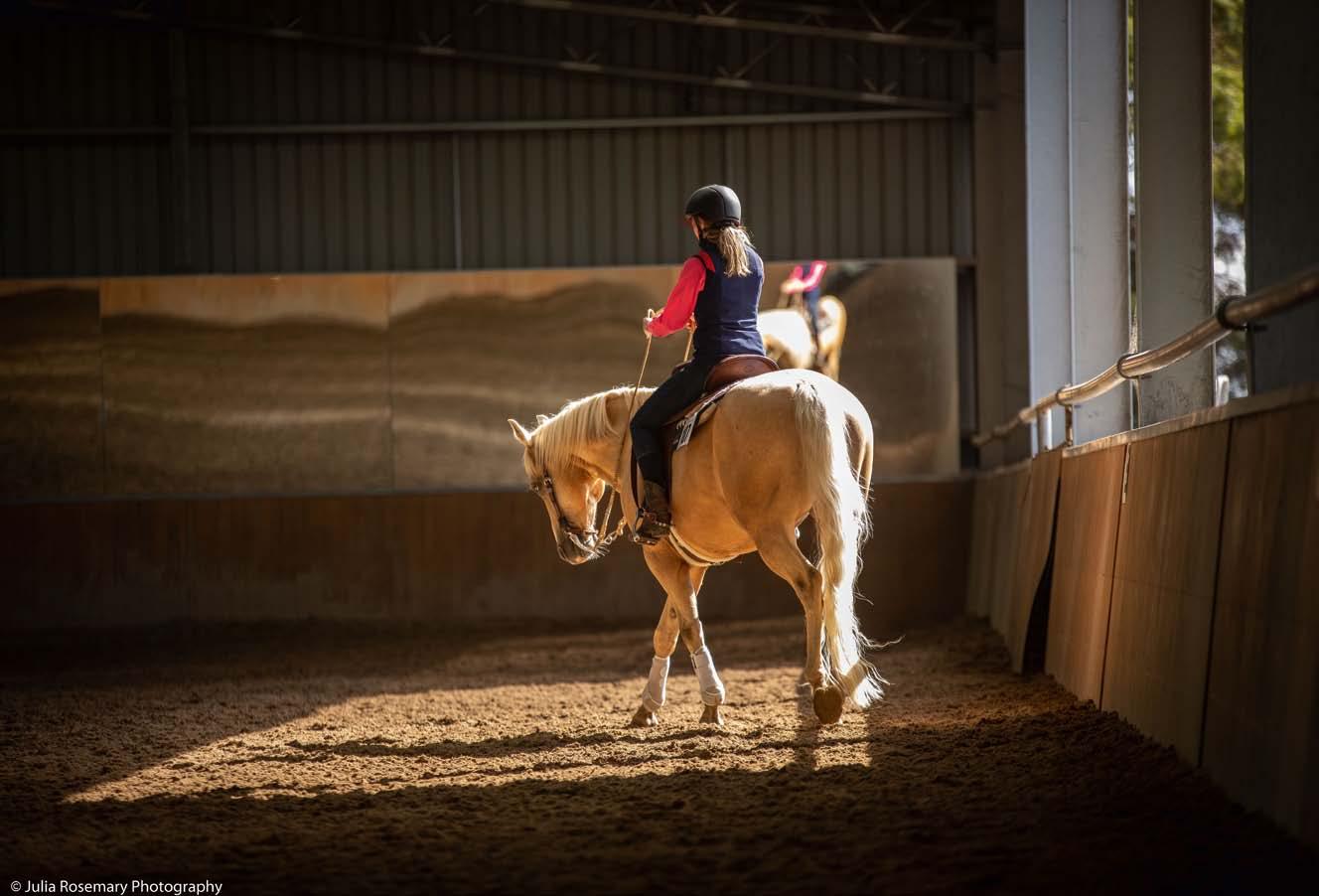
He had a professional reining career and did his reining futurity at 3-4 years old.
I bought him from a lady who was nervous herself, she mainly did reining and a little bit of trail riding, but he has spent his life in the reining arena - and he knows his job well!
When I got him, he was quite shut down and angry. He would pin his ears and pull nasty faces constantly.
He had almost no ground manners and was pushy - knocked me over, dragged me, it wasn’t fun.
Under saddle though it was a different story. He would move slowly, stop at any signal and look after me every step of the way.
Sandi helped me get his ground manners under control and now I can do everything with him, except float load. He isn’t a bad floater, he is just testy and knows that my balance on the tailgate is no good so pulls me over. He self-loads for anyone else though.
As my riding started to progress, I faced the challenge of him testing how little he could get away with doing - he is VERY lazy. Because i don’t have coordination, I am unable to kick/use my legs in the same way as other riders. Yogi saw that as his cue to stand still.
I started with ‘bumper’ spurs and they worked for a period to get him going. I worked hard on my balance on Yogi in a trot and my leg positioning and control by doing a lot of no stirrup work. I had to progress to small real spurs - makes sense as Yogi was ridden with spurs his whole life and didn’t understand anything different. I don’t actually need to use the spurs, he just knows when they are not there and stops.
The liberty training that I have done with him is what I credit him coming out of his shell to. He is not as cranky and pins his ears a lot less. It took about 12 months for me to even like him, but after owning him for 24 months, I was in love with him.
February/March 24 - Page 18
Jessica Atkins Studio photo.
Recognising and RewaRding VeR QuaRteR Ponies
productnews
• nutrition and health
• clothing and saddlery
• products and services

The Quarter Pony breed register for Australia, the Aust. National Quarter Pony Society Inc.(ANQP) complies with international breed standards and has an open access Online Studbook. The Quarter Pony stands between 11.2hh and 14.2hh and has a Western or Working type build, often with Quarter Horse ancestry. They are strong, resilient and intelligent equines with an excellent work ethic, making them perfect to transition from small pony to large horse.
Competitive in most events, many owners find no need to transition to a larger horse from their Quarter Pony, especially adults not wanting a stepladder to mount-up.
The ANQP Society is dedicated to the ethical and sound growth of the breed in Australia and promote an inclusive and friendly environment with a rewarding Awards Program for members and affordable fees. Opening up additional classes and showing options, and rewarding participation and event outcomes at a wide range of equine events, a studbook registration supports ethical breeding practices while a breed registration increases the value of a Pony.
Get in touch to see if your pony qualifies!
Visit: www.anqpsociety.com or facebook.com/anQPsociety. email contactus@anqpsociety.com.


a safe and comfoRtaBle JouRneY with comBined hoRse tRansPoRt
Established in 1983, Combined Horse Transport (CHT) provides long haul transport between the West and East coast of Australia with industry leading transport solutions in the company’s state of the art Mega Ark Fleet. After working with Combined for a number of years Glen Day made the most of the opportunity to purchase the business from Wayne Keily in early 2023, a natural progression from his full time role with CHT and inside knowledge and understanding of all aspects of the business and interstate and international equine transport. With his long involvement in the equestrian industry Glen, along with his daughter Isabella, have ensured Combined Horse Transport’s decades long reputation as a world class carrier remains their number one priority.
With first class customer service, door to door transport solutions, experienced team and focus on providing all horses in their care a safe and comfortable journey, Glen and Isabella treat all horses travelling with Combined Horse Transport as one of their own. They don’t just own the business, they drive the business.
For your horse’s travel requirements contact CHT on 1800 998 157 or visit cht.net.au.

scoot Boot wins e-commeRce exPoRteR of the YeaR awaRd
Tasmanian exporter Scoot Boot, which manufactures and supplies equine hoof boots to almost 100 countries around the world, took out the prestigious award ahead of four other national finalists at the 61st Australian Export Awards.
Designed by co-founder Dave Macdonald, a former farrier, Scoot Boots are a healthier, natural barefoot alternative to metal horseshoes to help protect horses’ hooves. They are constructed from thermoplastic urethane, a strong material that has high abrasive and shock absorbing qualities, making them extremely robust and lightweight to allow horses to travel over any type of terrain, no matter how harsh, with comfort and support.
Easy to fit on and off, Scoot Boots won’t get soggy or heavy when riding through mud and wet terrain, have superior traction and are easy to clean, making care for a horse’s feet simple and easy.
Scoot Boot Co-founder and Chief Executive Officer Annette Kaitinis said the win was an unexpected surprise for her team who had worked since 2015 to establish the brand and build the export market overseas. “Just last week we received our first order from Saudi Arabia and Lithuania; we recently onboarded two wholesale customers from Russia and we have growing interest from Latin American markets including Mexico. It really shows how the awareness of the benefits of going barefoot for horses is increasing, which means more horses are having healthier and happier lives because of our product.”
Visit https://scootboots.com/
Lydia Plim photo.
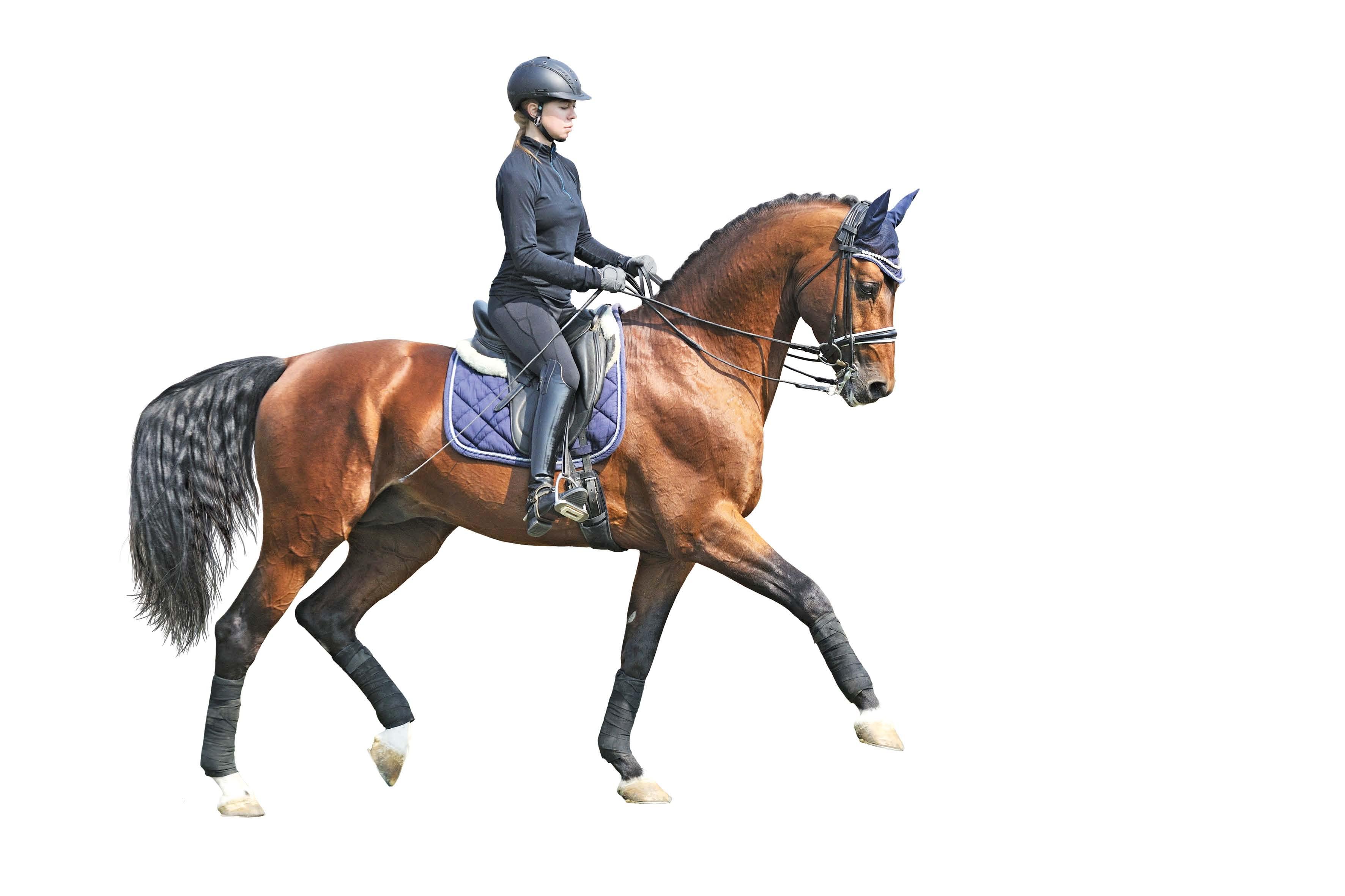
Part 1 T HE P ELVIS for a strong foundation
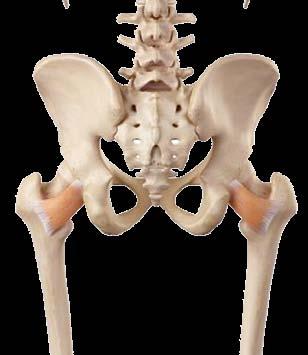
Reset
your riding
by Mel Macaulay
A well-aligned and functioning pelvis in an rider plays a crucial role in forming the foundation of their seat, which influences both stability for the rider and effective performance from the horse.
A stable, balanced seat allows the rider to clearly communicate with the horse; therefore, reducing conflict behaviours, improving the quality of the horse’s responses and movements, and increasing rider safety, confidence, and enjoyment.
some of the key aspects highlighting the importance of a well-aligned and functioning pelvis:
Balance and s Ta B ili T y
The position of the rider’s pelvis affects the rider’s centre of gravity and overall balance – a pelvis that tends to predominantly tilt too far forward will bring the rider’s centre of gravity too far forward, and the rider may feel unstable and tend to fall onto the horse’s neck. Alternatively, a pelvis that is predominantly tilted too far backward, the rider will be behind the horse’s movement and may brace their body or have a compensatory habit of swinging their lower legs forward and backwards to move with the horse.
February/March 24 - Page 20

A rider who has a stiff or tight pelvis will limit the horse’s movement. A well-aligned and functioning pelvis allows the rider to connect and move fluidly with the horse’s movements.
s hoc K aB sorp T ion
The movements of the horse and gravity generate forces that the rider’s pelvis is required to absorb and dissipate, which reduces the impact on the rider’s spine and hip joints. This impact absorption reduces the occurrence of hip or back pain, the risk of injuries to both the horse and rider and creates a more harmonious connection.
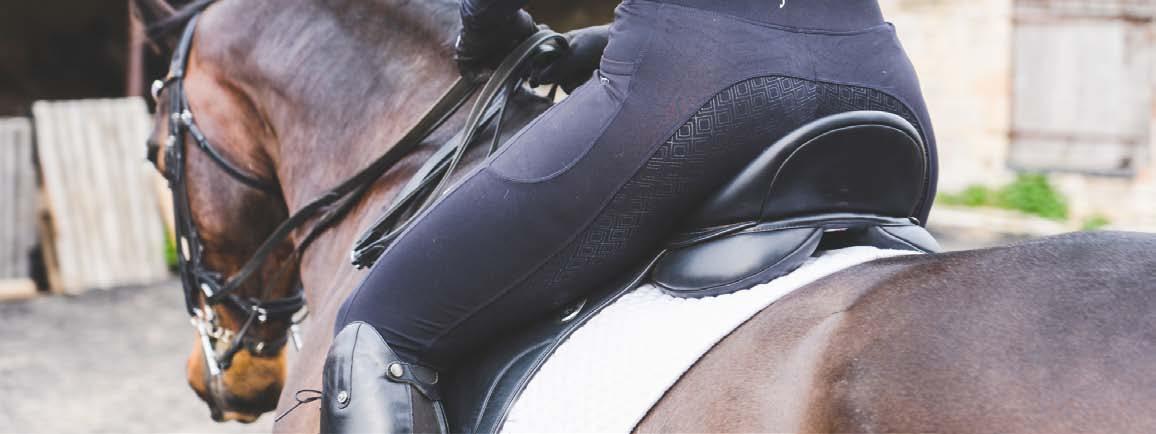
ethis allows the seat bones to widen (above) and the leg to lengthen (below).
Subtle shifts in the well-balanced rider’s pelvis provide clear, precise, well-timed and purposeful cues to the horse such as a change in tempo, direction, transition, or gait extension. If the rider does not have a stable pelvis, the seat bones could be unconsciously unbalanced, or moving unnecessarily. As horses are naturally more sensitive than us, this additional ‘noise’ increases the difficulty for the horse to determine an aid, the aid will be imprecise, inappropriately timed, and the horse in his frustration may display unwanted behaviours or become dull to the aids.
eAs riders become more aware of their body movements, and have greater pelvic stability and control, the connection between horse and rider improves as the rider does not need to brace or grip to maintain their posture. Tensed or tight gluteal muscles will bring the rider’s seat bones closer together, popping the rider out of the saddle. On the other hand, a stable pelvis with active gluteal muscles allows the seat bones to widen and the leg to lengthen, creating a deeper, softer and more balanced connection to the horse. This places the rider in a more efficient position to communicate with soft and subtle aids to the horse.
In essence, an equestrian with a well-aligned, dynamically stable, and functioning pelvis experiences improved stability, comfort, communication, and overall effectiveness in the saddle. Developing awareness of pelvic alignment and implementing appropriate exercises and techniques can contribute significantly to enhancing the rider’s skill, enjoyment, and overall performance when riding.


February/March 24 - Page 21
Continued
Reset your riding exercises
Try the following exercises to reset your riding with improving your pelvic stability. if you experience pain or discomfort, cease the exercise and seek appropriate medical advice from your gp or physiotherapist.
front to Back leg swings
Stand upright with a soft knee. Begin gently swinging your leg forwards and backwards, maintaining an upright position.
As your pelvic mobility increases, gradually increase the size of the leg swing.
10 – 20x each leg.
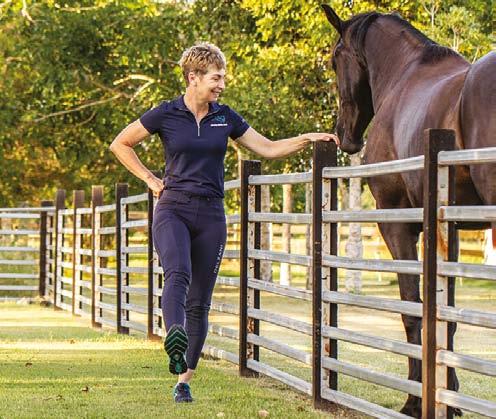

lateral lunge
Begin standing with feet hip width apart. Take a large step to the right with your right foot only.
Bend your right knee, keeping left leg gently straight. Sink down, pressing hips behind. Press up to standing and step feet back to starting position. Alternate from side to side.
10 – 15x each leg.
lateral leg swings
Stand upright with a soft knee. Begin gently swinging your leg sideways, then across the leg you are standing on. Swing gently and allow your leg to swing higher as your pelvic mobility increases.
10 – 20x each leg.
The leg swings are perfect for a pre-ride warmup, and for a regular mobility drill. You can work on your balance by attempting without holding on or hold onto the fence for added support.


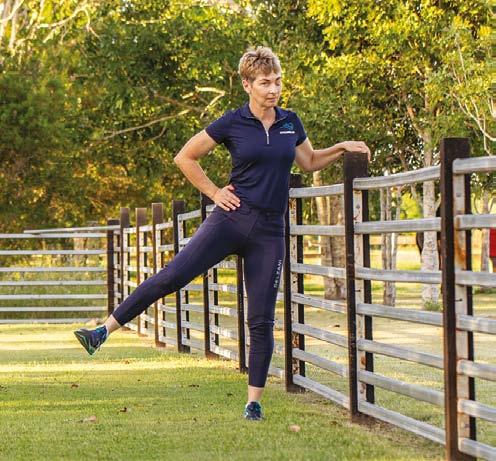

February/March 24 - Page 22

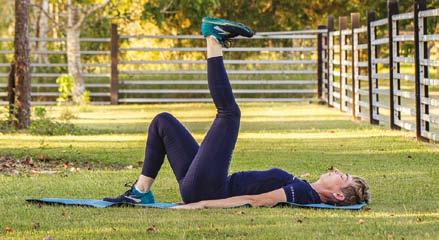
glute stretch
Sit on a firm surface such as a chair, or your mounting block. Lengthen your spine and open your chest as you place your right ankle on your left knee.
Allow your hips to open as you gently lean forward to feel a stretch in your right glutes.
Hold 20 – 30 seconds and repeat the other side.
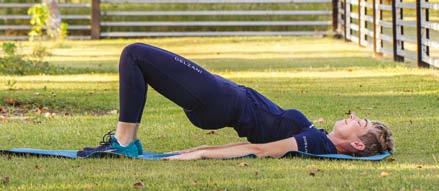
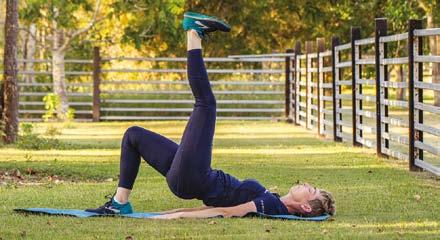
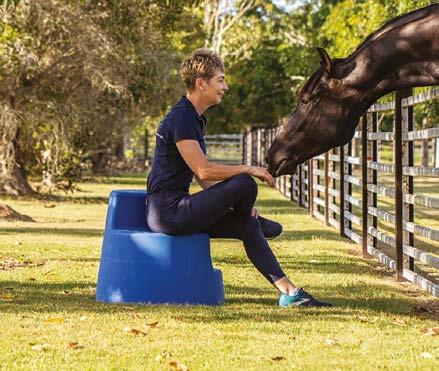
glute Bridge
Lay on your back with knees bent, feet and knees are hip width apart, and heels as close to your buttocks as possible. Engage your core so your lower back is flat against the floor.
Level 1: Check that your weight feels even in both feet and feet remain flat on the floor, lift, and lower your buttocks ensuring your hips remain stable and knees do not fall inside or outside. 10 – 20 x.
Level 2: Elevate one foot towards the ceiling. Press the other foot flat onto the floor, lift and lower your buttocks ensuring your hips remain stable and your knee does not fall inside or outside.
10 – 15x each leg.
Mel Macaulay from Strong Stable Seat is an equestrian biomechanics coach and registered Equine Scientist with a background in sports performance, rehabilitation, weight loss and assisting people create healthy lifestyles. Mel utilises a holistic approach for a lasting, well rounded outcome. Through the online Strong Stable Seat membership, Mel delivers multiple live streamed sessions each week to help equestrians improve their balance, body awareness and become more supple, stable and confident in the saddle. Contact: stongstableseat.com.au

February/March 24 - Page 23
Level 1: Start
Level 2: Start
Level 1: Finish
Level 2: Finish
- back to basics WOUNDS
For most of us, it’s an unfortunately all-too-familiar scenario: Your horse sustained a wound –maybe nasty enough for veterinarian attention.
After cleaning and treating, all that’s left is the daily care and nursing routine. But every time you examine the wound you question the progress.
Is the wound healing OK? Is the reddish colour around the edges ‘normal, what’s that fluid seeping from the corner?
ABOUT THE AUTHOR


because there is no evolutionary benefit of wounds that don’t heal – wounds want to heal and most do with very little input from us! So when a wound doesn’t heal well, there’s always a reason.

Dr Jennifer Stewart cEo bvsc bsc Phd dip bEP
Equine Veterinarian and Consultant Nutritionist.
www.jenquine.com
Dr Jen Stewart is currently the only practicing equine veterinarian and clinical nutritionist in Australia with more than 40 years experience. Consulting to leading international studs and trainers in various countries while working on research projects and being involved in nutritional management of a variety of


Equine Veterinarians Australia www.ava.com.au equine clinical conditions, including colic, tying-up, laminitis, performance problems, developmental orthopaedic diseases and post-surgery, Jen’s vision is to provide a world best-practice in equine veterinary nutrition and to BRING SCIENCE TO YOUR FEED BIN.
Lower limb wounds can present serious problems for horses, owners and veterinarians — and because horses favour a ‘flight’ response when faced with a choice of ‘flight’, ‘fright’ or ‘freeze’, limb wounds are not uncommon. In fact, they are the most common medical condition affecting horses — 4.7% of veterinary calls relate to skin wounds, compared to 2.8% for lameness and 1.9% for colic; 23.9% of euthanasias in horses less than six months of age were performed because of skin wounds, 16% in older horses.
And there are big differences between horses and ponies! Most pony wounds, whether on the body or the limbs, heal within seven to nine weeks. In horses, body wounds may take three months to heal and limb wounds a lot longer. Healing of limb wounds is often delayed, complicated by proud flesh - excessive granulation tissue - and scarring. To understand normal healing and how to minimise proud flesh and scarring requires a little bit of biology.
February/March 24 - Page 24
HEALING INHIBITORS
To help determine why some equine cuts, scrapes and lacerations fail to heal, it’s important to understand the top 12 inhibitors of healing
Infection
The most common reason wounds don’t heal and the underlying reason needs to be determined by your veterinarian.
Movement
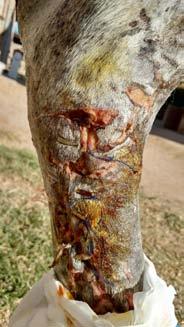
Foreign bodies
Bone fragments, splinters, dirt, wire, glass.
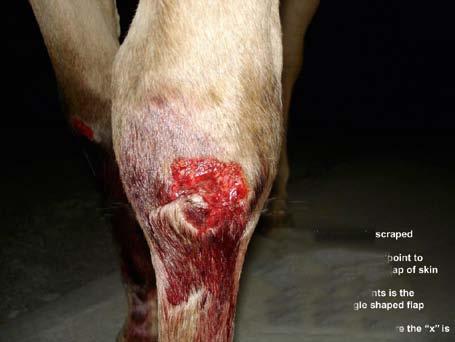
Necrotic/dead tissue
Tissue deficits
There must be healthy tissue in the wound for healing to occur - your veterinarian will discuss options if there are insufficient healthy cells.

Tissue must remain still for healing to occur and a plaster cast may be needed over high-motion areas.
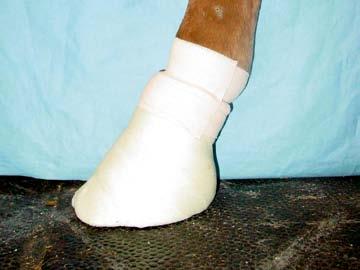
Tissue can die within a wound days, weeks or even months
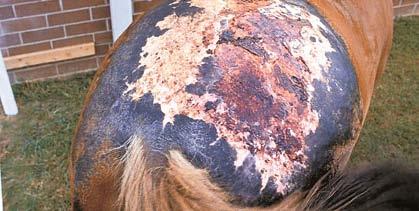
after the initial injury - veterinary treatment will be needed at assess and remove.
Reduced blood supply
A blocked artery that supplies the area - a veterinary inspection is needed.
Poor oxygentation
Lack of blood supply, anaemia (which is usually due to copper deficiency), bandaging too long, which prevents air access.
Poor overall health
Cushings, poor nutrition, deficiencies of protein, vitamins, minerals. Use a balanced complete all-in-one supplement to avoid risks of overlap, excesses and deficiencies.

Continued trauma Local factors
Rubbing tack, tight bandages, self-trauma, irritant pasture.

Human error (stupidity?)
Wound products range from unnecessary to harmful. Human wounds are different - always check with your veterinarian before applying any lotion/potion/antiseptic/ disinfectant/salve/dressing/ treatments or bandage.
Very hot, cold, dry or wet weather; pockets can form in the tissues.
Tumours
Sarcoids can develop in wounds and look identical to proud flesh but require a completely different treatment.
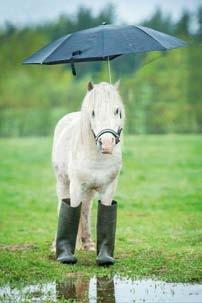

February/March 24 - Page 25
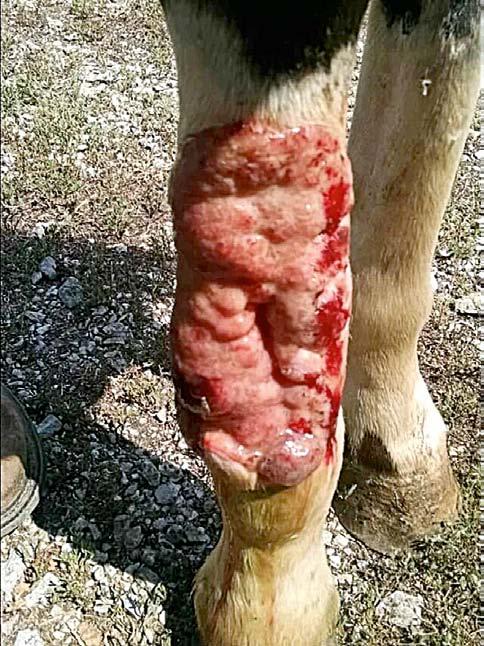
WHAT IS PROud FLESH?
During the early stage of wound healing, the body fills the wound gap with granulation
This tissue contains many blood vessels, which bring oxygen and nutrients to the newly forming skin cells and creates a base layer that works its way from the skin at the wound edges toward the centre of the wound, thereby forming a new epidermal layer.
This appears as a pale pink border around the wound edges that has no hair, pigment and various other normal skin components, such as sweat glands.
Proud flesh occurs when granulation tissue in normal healing wounds mushrooms over the skin surrounding the original wound.
This is more likely to occur if there is movement of the wound, infection, incorrect bandaging, pressure bandages, poor blood supply, tension of the skin surrounding the wound, foreign bodies and the use of irritant dressings and ointments. Left untreated, the mushroom crown of granulation tissue (proud flesh) can continue to grow many centimetres beyond the horse’s normal skin surface. The protruding lump of tissue is susceptible to re-injury, which leads to more irritation and inflammation, and prolongs the healing process even further. In most cases, proud flesh will not resolve on its own.
The formation of proud flesh can sometimes be prevented by leaving the wound unbandaged — this also reduces the cost of treatment. The best time to do this is after the wound has filled in with healthyappearing proud flesh. However leaving the wound unbandaged is not always the best option and veterinary advice should be sought.
Bandaging is necessary in some wounds to protect deeper vital structures, reduce swelling or stabilise the wound.
WOuNd HEALING HAS SEvERAL STAGES (all of which are faster in ponies):
1 Inflammation -
when bacteria and dead tissue are cleared away and the wound retracts (gets larger).

3
2 Proud Flesh Formation –
brings growth factors, blood vessels and fills in the gap, but if excessive and protruding above the skin margin at 10-14 days it delays and inhibits the next two stages.

4 Contraction –
full-thickness skin is drawn from all sides to cover the wound bed. If efficient, contraction reduces the wound size and hence the final scar size. This stage is delayed by bandaging. (Note: this is not the same process as ‘contracture’, which is the end result of scarring and can produce deformities if severe).

Skin migration (epithelialisation) –
starts after 2-3 weeks; slow movement (0.56mm per day) of individual skin cells (ie not fullthickness skin) across wound surface; cannot occur over proud flesh; if the wound is through the full thickness of the skin, this stage is accompanied by laying down of scar tissue.

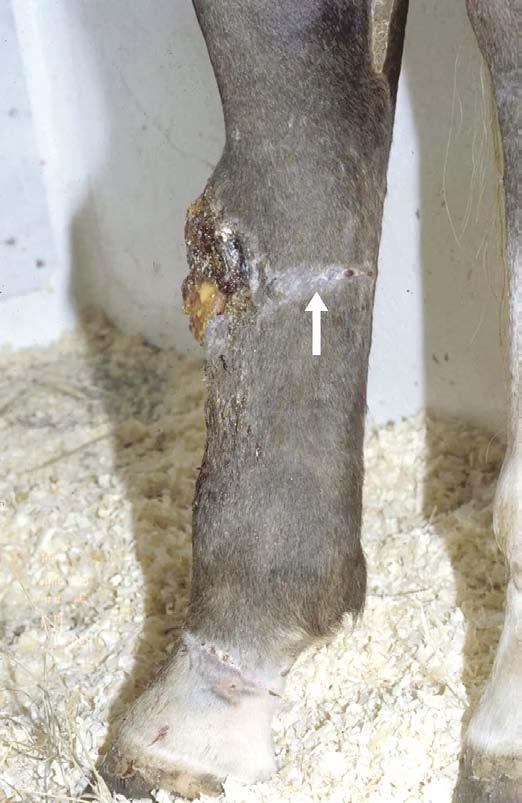
sites
Sarcoid affected horses are capable of transmitting the virus, often by flies, to other horses to cause the development of sarcoids.
Early signs that a sarcoid is developing within a wound are a partial or total separation of previously neatly fiitting wound edges, due to a failure of proper wound healing; unhealthy appearance of granulation tissue; lack of wound contraction; and inability to control exuberant granulation tissue (EGT).
ALARm ALERTS
INCLudE:
Wound breakdown

despite careful wound closure and excellent wound management
delayed healing after surgical removal of a sarcoid unhealthy granulation tissue or lack of wound contraction
WHAT TO dO WHILE WAITING FOR YOuR vET
Initial first aid should prevent wound contamination and minimise bleeding or haemorrhage.
If hosing the wound, do not use too much pressure as it causes trauma to the tissues, decreases resistance to infection and causes deeper seeding of bacteria within the wound.
Limit the pressure to what can be delivered by a gentle showerhead or a hand-held syringe and narrow needle –not a hose on mains pressure! Tap water can be used – but addition of antiseptics such as povidone iodine or chlorhexidine should only be done on veterinary advice as high concentrations result in compromised wound epithelialisation and wound contraction, and decreased tensile strength. (Figure 1- see next page.)
The type of treatment and choice of dressing must be chosen according to the condition of the wound and the stage of
February/March 24 - Page 27
SARCOIdS Continued

healing. Treatment may include irrigation, cleaning and trimming damaged tissue, antiseptics, antimicrobials and antibiotics, dressings, bandages and applications such as aloe vera, honey and live yeast. your veterinarian may also suggest live maggots, (especially for necrotic hoof defects and deep-seated abscesses on the body).
Because wounds are dynamic and changing, treatment must be appropriate and modified to match the different stages of healing. So it’s really important to follow manufacturer’s directions and veterinary instruction on the appropriate use, concentration, frequency of administration and mode of application for different bandages, dressings and applications.
New treatments on the horizon
New treatments include growth factors, vacuum-assisted closure, hyperbaric oxygen therapy, cell therapies, biological products, copper complexes, maltodextrin, yeast cell derivatives, corticosteroids, sugar, Manuka honey (the beneficial effects are confined to the first 21 days after injury) and medicinal maggots.
OWNER PROTOCOL FOR WOuNd mANAGEmENT
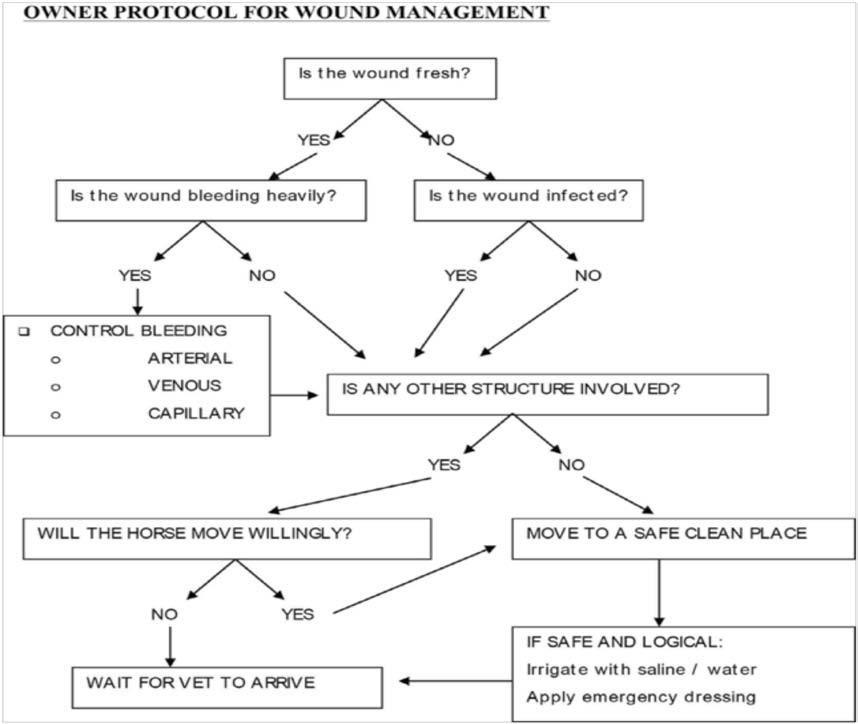
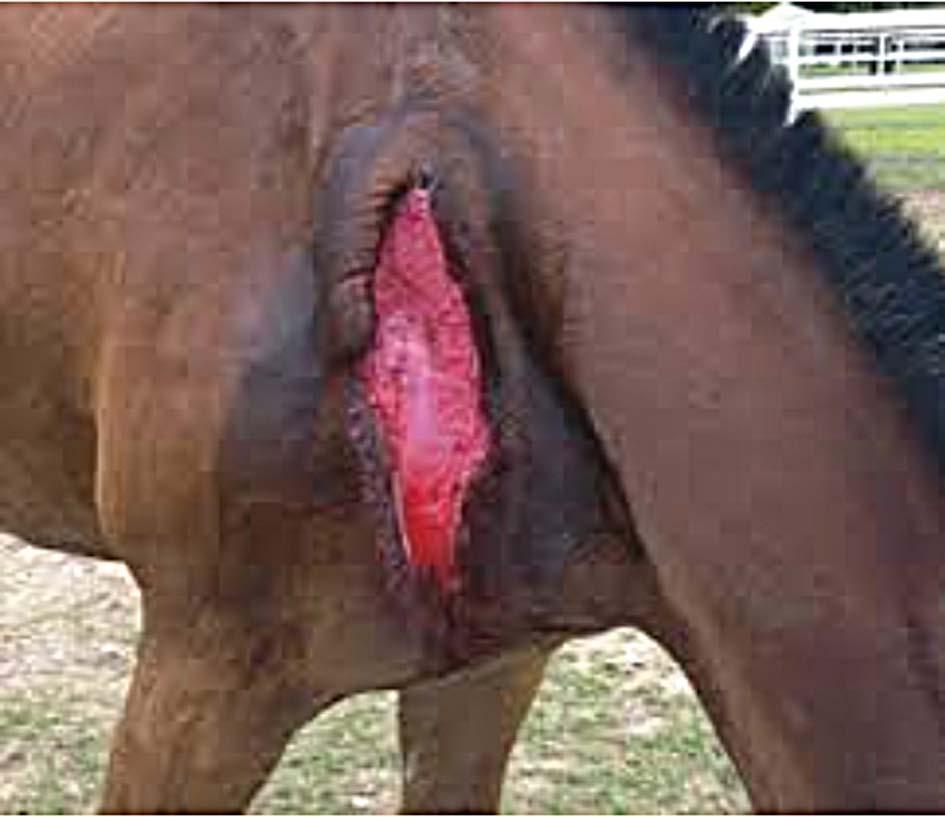
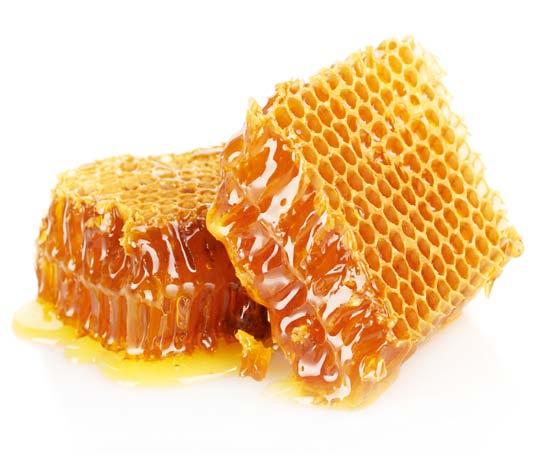
BANdAGING
The timing and type of bandage and wound dressing are all critical to healing and proud flesh growth. Your equine vet is the best source of guidance here. Bandaging in the early phases of wound healing protects from contamination, however once a sufficient bed of granulation tissue has formed, bandaging promotes excess
proud flesh and delays healing. Bandages increase the amount of wound discharges, cause chronic inflammation and reduce oxygen to the wound. To counteract these, the body increases the blood supply by increasing the growth of new blood vessels and cells in the wound = proud flesh.
The increased proud flesh slows the phases of wound contraction and growth of skin cells across the wound surface.
This delays and prolongs wound healing. No single material can produce the optimum result for all wounds or for all the stages of the wound healing process. There is a huge and increasing range of advanced wound dressings available and it’s confusing to know which to select and when, how and for what period of time they should be used. your veterinarian is best placed to provide up-to-date information on available dressings based on the condition of the wound and the phases of wound healing. And correct nutrition is important for healing - certain dietary deficiencies (eg copper, zinc, essential amino acids) can lead to delayed wound closure and reduced wound strength.
February/March 24 - Page 28
Manuka honey
Maggots debride the wound by dissolving dead and infected tissue.
Wounds, with a bed of granulated tissue, that are left without bandages are less inclined to produce excessive proud flesh.
Figure1.
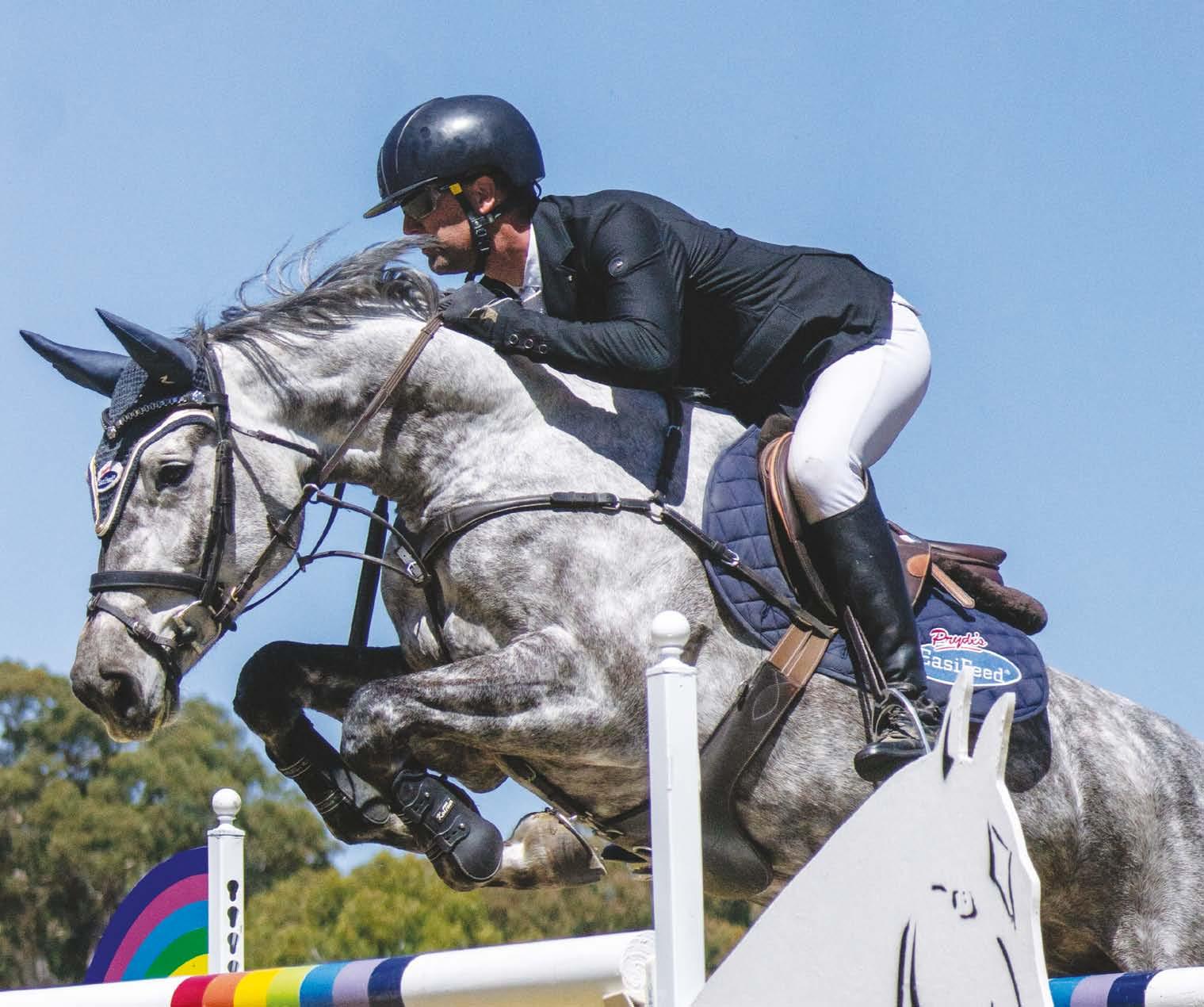
why do farriers and other equine professionals have confidence in nrg stride?
Stride stays on longer for beneficial absorption in warmer weather.
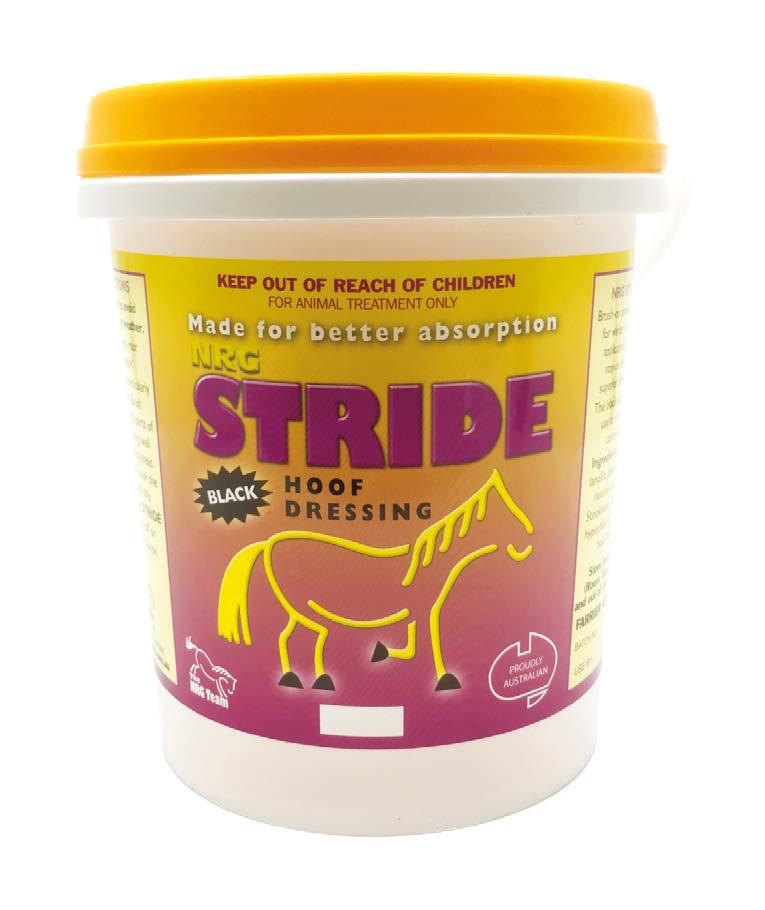
Encourages healthy hoof growth with our proven formula.
Nourishes hooves keeping them supple for improved shoeing and trimming.

Find out more at nrgteam.com.au
no hoof...
NRG Ambassador James Harvey riding Yirrkala Celeste. Credit Horizons Photography.
no horse!
Please Explain
WHY Some HorSe require Steamed or Soaked HaY for tHeir Wellbeing.
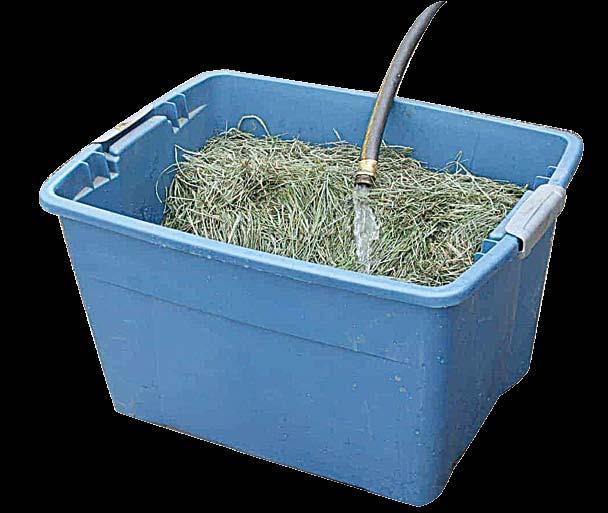
Choosing which way to prepare hay depends on several factors, including expense, ease of operation and, most importantly, the horse’s health needs. Check out this list of considerations when deciding what’s best for your horse.
1. s oa K ing and s T eaming reduce respira B le dus T par T icles significan T ly, some T imes comple T ely.
These particles originate from bacteria, moulds, fungal spores, organic dust, minute plant structures, and insect fragments. When inhaled, the particles can stimulate hypersensitivity in your horse’s airways, contributing to inflammatory airway disease.
2. s oa K ing hay reduces WaT ersolu B le car B ohydraT es (Wsc ) more T han s T eaming.
“Certain sugars and fructans identified during chemical analysis quantify the carbohydrate content of forages, and these are called water-soluble carbohydrates,” explained Catherine Whitehouse, M.S., a nutritionist for Kentucky Equine Research. “Fructans, the primary storage carbohydrate in cool-season grasses, are rapidly fermented in the hindgut rather than being digested in the small intestine like the sugar component of WSC.” The percent change in water-soluble carbohydrate losses in soaked hay can range from 8% to greater than 50%, but losses in steamed hay range from 0-18%. The variability in WSC after soaking or steaming does not guarantee the hay will be suitable for metabolic horses. Reducing WSC benefits overweight or obese horses on calorie-restricted diets.
“Because of this, soaking hay relieves the need to aggressively restrict forage intake,” Catherine added. While decreasing forage intake reduces calorie intake, limiting forage means horses spend less time eating. Fasting puts horses at risk for gastric ulcers and the development of stereotypic behaviours. By reducing WSC, horses can be offered a larger portion of hay, allowing them to eat for more hours.
Cutting WSC in hay also benefits horses with metabolic disorders such as insulin dysregulation, metabolic syndrome, polysaccharide storage myopathy, and pituitary pars intermedia dysfunction Cushing’s syndrome. Horses with chronic laminitis, often considered a complication of metabolic disorders, also benefit from decreasing dietary WSC.
3. p rolonged soa K ing leaches nu T rien Ts from T he hay.
Soaking for 15-30 minutes will reduce WSC without resulting in nutrient deficiencies. “If extended soaking is
There are many aspects of riding terms, horse conditions and management practices that are accepted in the equestrian community, without them being fully understood by everyone. Here, we have asked experienced researchers and horse people to shed some light on common ‘horse lore’.
required, particularly for horses on restricted hay diets, offering a vitamin and mineral supplement or ration balancer is essential to ensure optimal nutrition to support health and performance,” recommended Catherine. Vitamin and mineral supplements are available to help balance the diet, particularly for those on all-forage diets.
4. sT eaming preserves T he minerals, T race elemen Ts, and crude proT ein in hay.
However steaming does not result in any substantial changes in WSC and therefore may not benefit horses with metabolic disorders as much as soaking.
5. sT eaming hay reduces B ac T erial coun Ts almos T en T irely.
This benefits horses with respiratory compromise and may also support a healthier hindgut. “The health of the horse depends largely on the health of

Both steamed and soaked hays are consumed more slowly than dry forage.
February/March 24 - Page 30
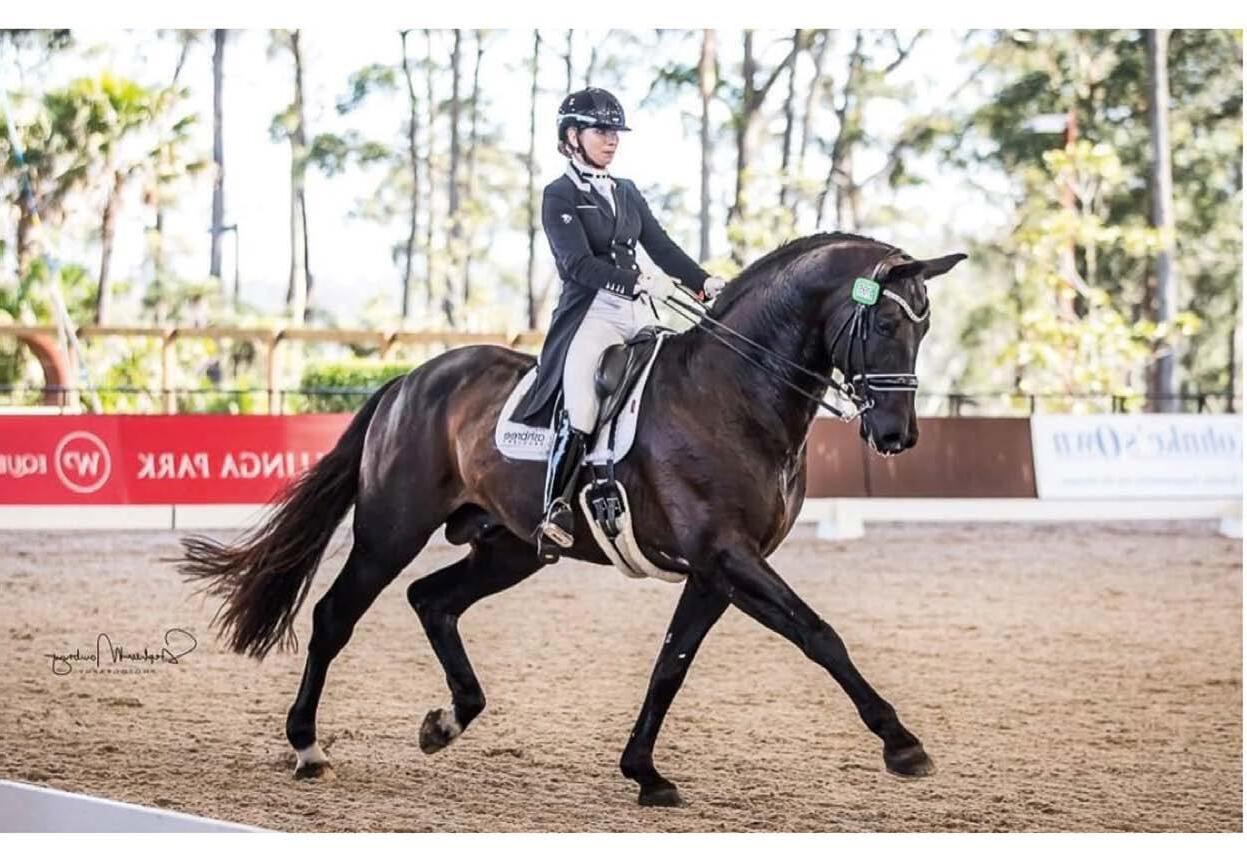
be advantageous for horses on calorierestricted diets.
9. h orses che W soa K ed hay more in T ensely T han ei T her dry or s T eamed hay.
“Chewing forage increases the production of saliva, which can help buffer the stomach and support digestive health,” Catherine said. Increased chewing may also help a horse’s dental health.
10. h orses appear To prefer s T eamed hay over soa K ed hay in T erms of palaTa B ili T y.
If steamed or soaked hay is part of your horse’s diet, work with your veterinarian to decide which method will work best for your horse. If soaking or steaming hay is part of a respiratory-health plan, consider supplementing with a marine-derived source of omega-3 fatty acids, such as EO-3, a treatment favoured by veterinarians.
Reprinted courtesy of Kentucky Equine Research.
Visit ker.com for the latest in equine nutrition and management, and subscribe to Equinews to receive these articles directly.
The topic this issue is ‘how to improve the sitting trot’. All trot work from Elementary and above must be done in ‘sitting trot’ so, if it’s something a rider struggles with in particular; it can be quite challenging getting through those tests in an elegant manner. Even if riders don’t think they are struggling with ‘the bounce’ they can unknowingly be compensating by balancing off the horse’s mouth or gripping with their knees, rather than using their core and seat.
There are a couple of exercises on the horse that come to mind to help the rider to improve their sitting trot.
• If you are new at the sitting trot you may want to gradually introduce yourself to it. Try four steps rising trot and then four steps sitting trot. Find your rhythm within the trot and try not to change the horse’s tempo when you go from rising to sitting. Return to the rising trot and repeat the exercise.
• Ride with no stirrups – riding for 15 minutes or so with no stirrups is not only a good exercise for the core but it also teaches the rider to ride with a longer leg and sit deeper in the saddle. Riders needs to try and absorb the bounce through their seat and back by not bracing against the horse’s movement.

The team at Kentucky Equine Research is here to help!
For more information contact a qualified nutrition advisor on 1800 772 198 advice@ker.com www.ker.com
• For riders who tend to hold on to the horse’s mouth, rather than use their core and seat to balance themselves, try introducing a lot of ‘half-halts’ into your training. Having that release hundreds of times during a training session physically makes the rider check that they aren’t relying on the horse’s mouth. If the horse’s tempo, rhythm, or frame changes then it’s an easy guess the rider was riding ‘with the handbrake on’ and not in balance and harmony. Relying on the horse’s mouth for balance is a very easy trap to fall into, particularly when a rider fatigues and starts resorting to other measures.
The important thing when sitting trot is not to grip or brace. Riders who struggle with the
HoW to improve tHe Sitting trot
In 2020 Mary Warren was a NCAS Level 1 Dressage Coach, a Member of the NSW High Performance Squad and a Member of the Equestrian Australia Recognition Dressage Squad.
sitting trot usually are quite rigid in their pelvis and/or back and therefore bounce off the horse’s back rather than absorb the concussion through their body with suppleness. Some riders find the sitting trot more natural than others but it is definitely something that can be worked on and improved through practice and discipline from the rider.
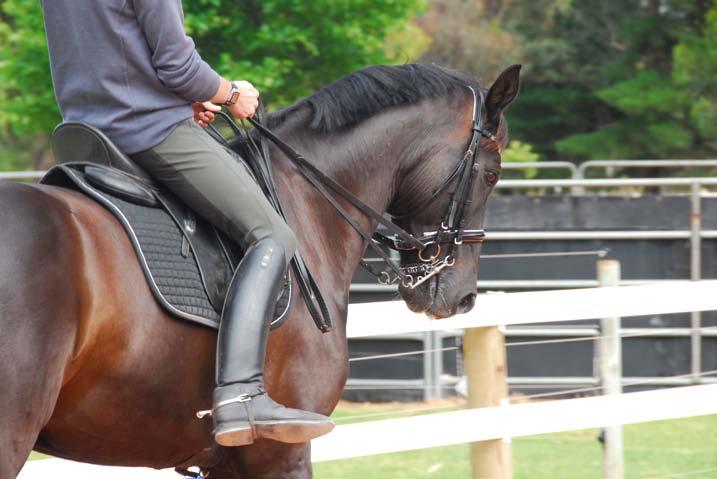
Riding with no stirrups can teach the rider to ride with a longer leg.
The only disadvantage is that the rider may try and compensate their balance on the horse by gripping with their knees or holding onto the horse’s head. This is something a rider needs to be very conscious of whilst doing this exercise.
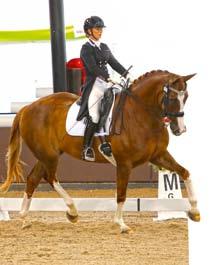
Based in Bolwarra Heights, NSW in 2020 Mary Warren was a 22 year old professional dressage rider who ran a business of agistment, training and coaching out of the family property.She had experienced training and competing multiple Young Horses right through to Grand Prix at CDI’s around Australia successfully
February/March 24 - Page 31
This article first appeared in Hoofbeats Vol42/6 2020
iS mY HorSe CrYing ?
Dr Allan Gunn
helped us to explain
BlockeD teAr Ducts:
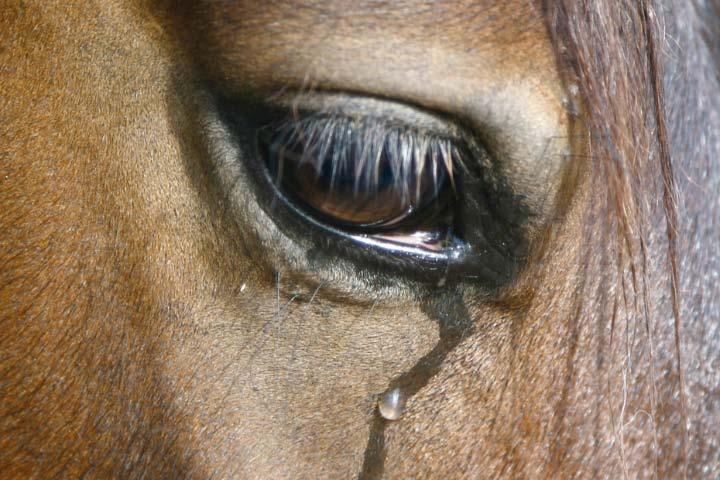
Tear ducts in horses are one of the things that owners rarely think about until they aren’t working properly, and even then it is a condition that tends to worry the owner more than the horse. However, a veterinary examination is extremely important to ensure that the problem is the tear duct, and not a problem of the eye itself, because if not treated appropriately the horse may lose sight and/or its eye.
The horse with blocked tear ducts typically presents with a persistent watery and/ or mucoid discharge from the eye. The discharge frequently recurs despite regular cleaning. The horse does not show signs of pain, like having a closed or half-closed eye, nor does the eye look red.
Normally tears are produced by glands associated with the eye and eyelids. Tears are actually a complex fluid consisting of a variety of secretions with different and important chemical properties.
For tears to be visibly flowing down the horse’s face it indicates one of three things could be happening:
1. The horse is creating excessive tears.
2. There is a defect in the eyelid, or extra hair creating an alternate route (a ‘wick’) for tears to be flowing onto the face instead of through the tear duct.
3. The tear ducts are obstructed, either temporarily with dirt or mucus, or possibly permanently from scar tissue or other causes.
Assuming there is nothing wrong with the eye such as an eye ulcer, the most common of the three would be a blockage. Back, or occasionally forward, flushing of the duct usually removes the obstruction. The tear ducts are very fragile structures that are lined with a soft membrane and, if damaged, this lining can stick to itself and block the duct resulting in an overflow of tears from the
Blocked tear ducts usually occur in the warmer months, and there is normally no pain with this condition.
Occasionally there is some mild swelling of the lower eyelid. There can be hair loss in the area of the watery discharge, or matting of the hair in this area.
To diagnose the condition, the veterinarian will likely place a green coloured fluorescein dye into each eye and observe the nasal opening of the tear duct 3-5 minutes later to determine the presence of dye at the nostril exit. If the dye does not trickle down from the eye to the tear duct opening, then the duct is likely to be blocked.
Two treatment options exist, the first is based on management of the problem. The eyes can be wiped clean twice daily with clean or sterile, soaked swabs, and the use of a fly mask used whenever the horse is turned out. Occasionally antibiotic eye drops may help.
The second option is to flush the tear ducts by inserting a catheter into the duct system and washing it out (lavaging) with sterile saline. The horse may or may not require sedation and/or the use of a nose twitch. This is not a painful procedure but the horse does feel some discomfort.
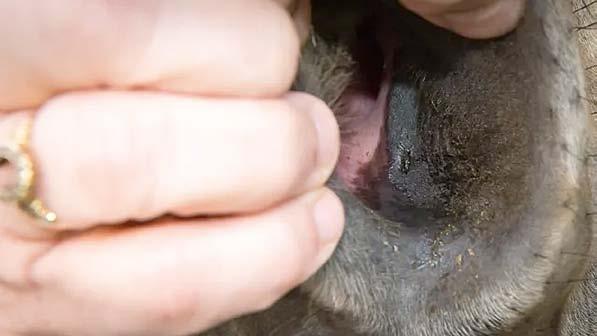
normally, the tears drain from the eye into a ‘lake-like’ (lacrimal sac) part of the inside of the eye, down to what is known as the nasolacrimal duct system. This draining tube travels from the eye where there are two openings, down through the inside of the head, and drains near the nostril opening.
eye. Although not a serious condition, the discharge does attract flies, which in turn can lead to a bacterial infection. In some cases the duct is permanently closed by some developmental problem, scar tissue, or other causes. Surgical options such as implanting a tube, or opening blockages may need to occur.
Steroid / antibiotic eye drops may be dispensed to reduce any inflammation within the ducts. This procedure often clears any acquired blockages, but it is important to remember that recurrence is possible.
This article first appeared in Hoofbeats Vol 37/3
Dr Allan Gunn has worked as a veterinarian in the UK, Zimbabwe and China. Based in Australia, he left equine stud practice in 2012 for a position at Charles Sturt University School of Animal and Veterinary Sciences.
Why can’t horses breath through their mouth?
The horse is an ‘obligate nasal breather’, which means it can breathe only through its nose, unlike many other mammals which can also take in air through their mouths. This is because the horse’s soft palate – which the back of the roof of the mouth - is very long and reaches all the way to the epiglottis. The epiglottis is a small structure made of elastic fibrocartilage that flips backwards and seals the windpipe so that food doesn’t enter it when the horse swallows. Because of its length the soft palate physically separates the upper part of the airway (nasal cavity) from the actual mouth (oral cavity), whereas in other animals it is shorter and the two cavities are therefore not sealed off from one another – meaning air can enter the windpipe from either the nose or mouth.
This biological design might seem strange for an animal as athletic as the horse that needs large volumes of air when running, but is an evolutionary advantage believed to have arisen so that horses, as fight-or-flight animals, can graze and chew their food whilst still taking in air through the nasal passages (important for smelling predators nearby). This article first appeared in Vol 40/4

February/March 24 - Page 32
Number 168
February/March 24
Produced by Hoofbeat Publications
90 Leslie Road Wandi 6167
Ph: 08 9397 0506
enquiries@hoofbeats.com.au https://hoofbeats.com.au

Is
Regular Contributors
Liz Tollarzo
Rhiannon Brown
Wendy Elks
Country Park Herbs
Articles, news, photographs, questions and artwork for inclusion in this publication are welcome and should be emailed to enquiries@hoofbeats.com.au with the sender’s contact details
Number 168
your property prepared?
the rot
timber posts.
beetles to the rescue.
Can a soil test tell you what is in your pasture? Stop
-
Dung


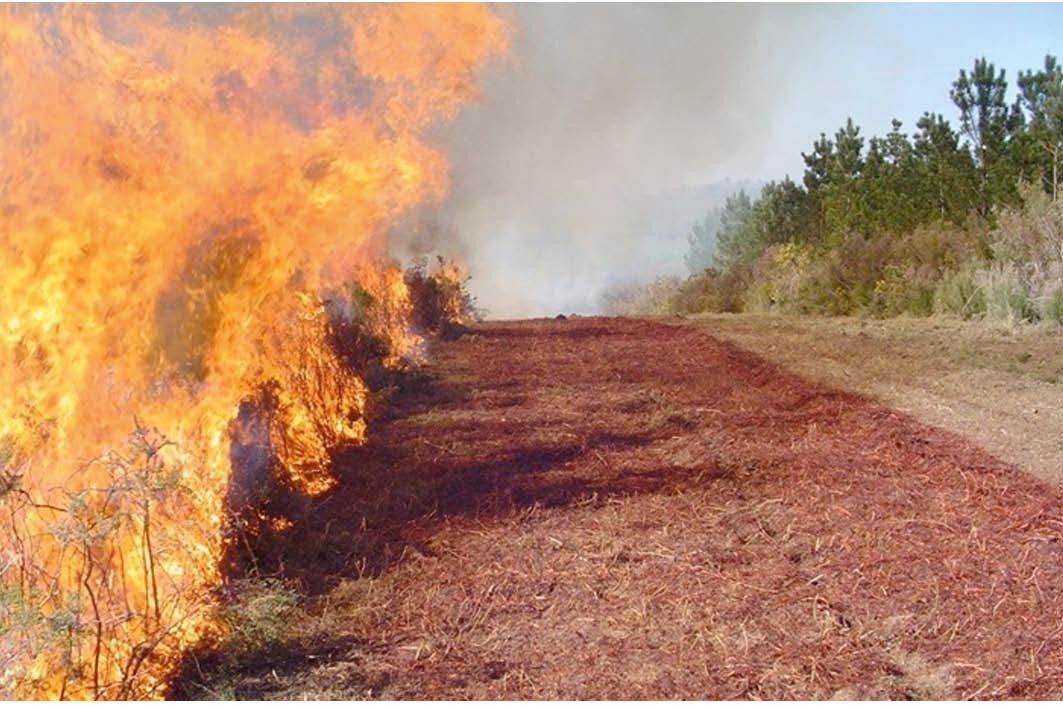
IS YOUR PROPERTY PREPARED?
IS YOUR PROPERTY PREPARED?
native bush is built to burn and because of our love of the land, we often build our homes right on the doorstep of Mother Nature’s very own ‘Redhead’ matches.
The recent bushfires and floods across Australia should be a much needed reminder to all of us who are landholders and put us all on notice that the rural lifestyle we so enjoy requires diligence on our behalf in relation to care of the land and awareness of preparedness for fire, drought and floods.
To often, fires are thrown into the ‘it won’t happen to me basket’ until it’s all too late. This has been a
our views on firebreaks from some of our earlier articles. Plough or spray?
If you have gone down the age-old ploughing path, your firebreak is probably very boggy and un-driveable if you live in sandy areas or incredibaly bumpy and rough in clay areas and could mean you need to be using your well-equipped 4x4 to take a ride around the fence lines of your property.
That said, this could be a major issue in a stress-filled paddock-run to pick the horses up with a fire breathing down your neck and water choppers circling above.
I’d prefer option two - spraying. A hard, solid, well-worn track that’s been treated chemically or sprayed with a natural nonresidual product.
Regardless of your firebreak approach, don’t sit back and think what you sprayed a few weeks ago will mean the firebreaks need no attention again this year. Some years they need attacking once, some years - four times. Seasonal changes make a difference and weeds have a habit of growing where we least want them too.
Spray? Or plough?
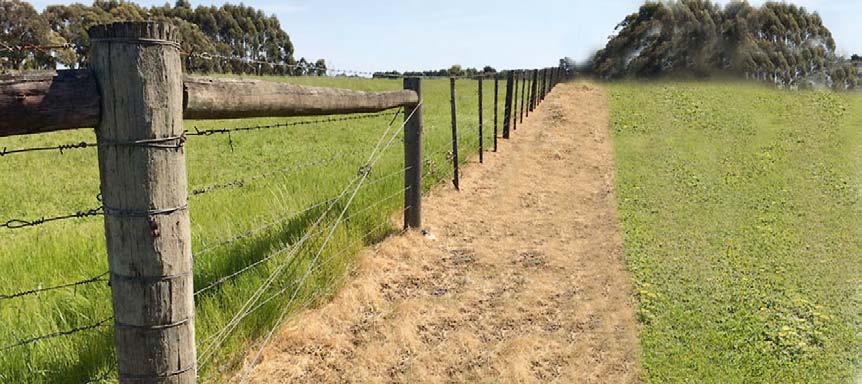
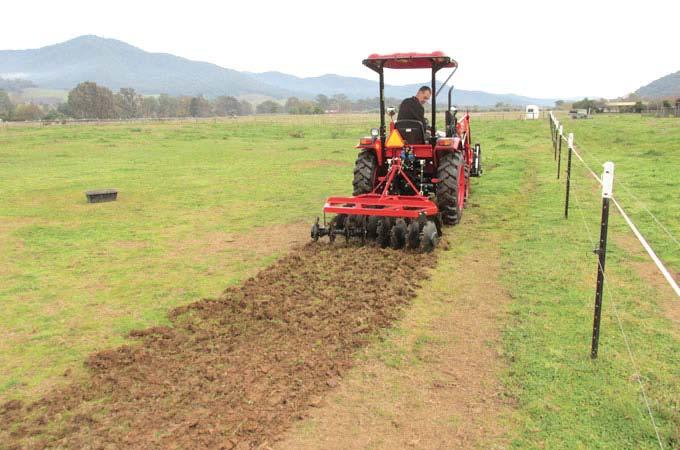
February/March 24 - Page 34 Number 168

SUmmER PAStURE GRASS wEEdS.
Most of us have them, a lot of them are South African and all of them are warmgrowing grass weeds. Long after the paddocks have been slashed, and the pasture grasses are generally low, warm-growing grasses shoot up. They’re generally pretty easy to spot too. They’re those pesky looking green bits we see from the fence line when everything else seems dead.
Cut or treat them, or even dig them out before they seed. These particular warmgrowing grass weeds can increase your fire load and summer is generally the best time to attack them, simply because of the ease in being able to see and identify them.
IS YOUR wAtER SORtEd?
Do you have access to a 12v water/chemical sprayer or motorised water tanker - that works? Is your bore water pump able to be used with a generator if the power mains are cut off?
Check your generators/pumps and motors been serviced, started, and have fuel. Regularly get them checked, add clean fuel and fire them up but don’t just sit back and hope they’ll start, because when the poo hits the fan, you can guarantee they won’t.
Check your garden hoses are holding water and not looking like swiss cheese. Do you have a larger hose that will output more water if there’s a fire and is it long enough to reach all areas you may need to defend against sparks/fire?
Where did the kids put sprinklers and where are all those hose fittings you need? All simple stuff to check, yet many of us have
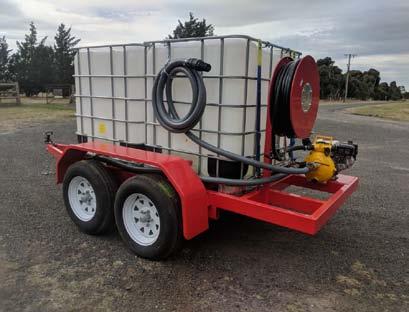
Fire fighting unit set up on a trailer.
a habit of putting these things on the back burner. Get your property defence system in shape, and don’t get caught with a hole in your hose when there is still hot weather around.
by Rhiannon BrownEnvirapest
A director for Envirapest, a pest and weed control company, Rhiannon has over 7 years’ knowledge in the industry, is a founding board member of the Professional Women in Pest Management Association as well as being a licenced pest and weed controller herself. She has a love of horses, has two of her own and has been an accomplished natural horsemanship enthusiast for over 18 years.

E: safe@envirapest.com
W: envirapest.com.au
P:1300 368 472

February/March 24 - Page 35
Can a soil test tell you what’s in your pasture?
By Nerida Richards - Feed XL
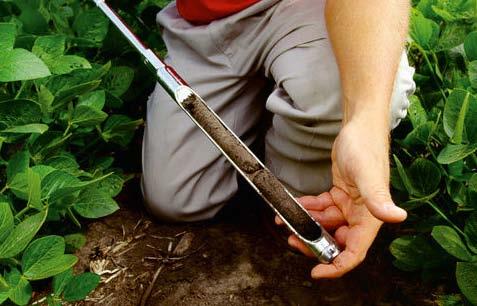

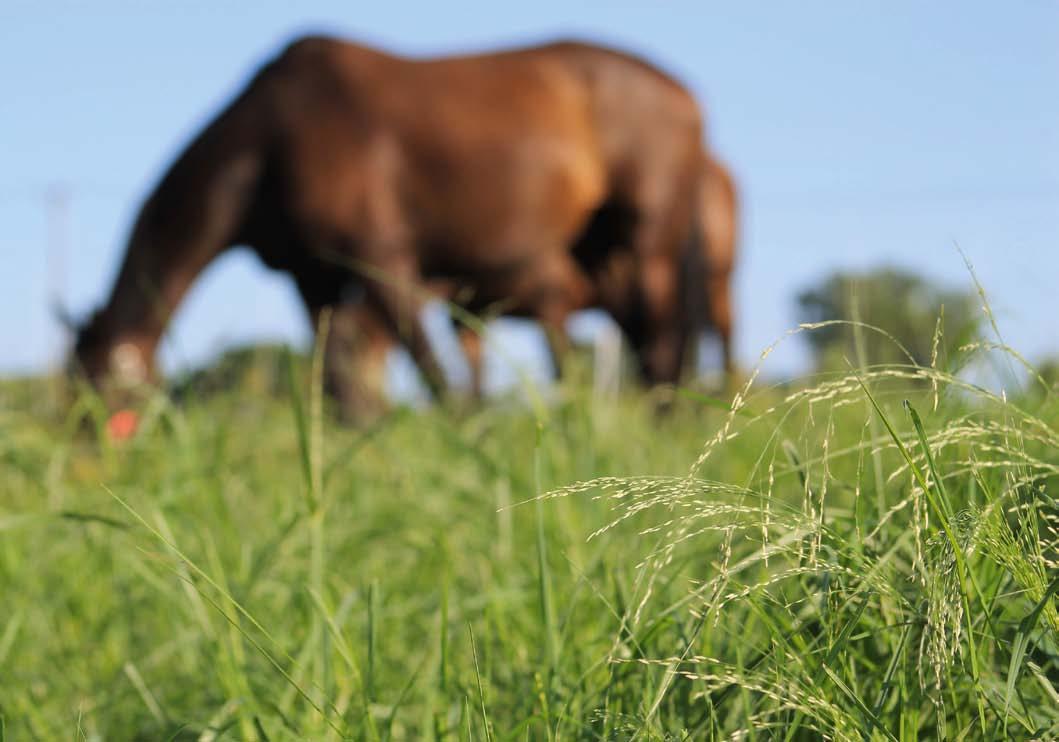
A definite recommendation for horse owners is to have their pasture and hay tested so they get a much more accurate idea of what their horses are eating.
“People ask us if soil tests can be used to work out what will be in their pasture or hay, and the answer, quite simply, is no. “While a soil test is an infinitely useful tool that will allow you to make important choices when it comes to managing your pasture, it cannot accurately tell you what will be in the pasture.
“There are definitely trends and relationships between your soil and your pasture. For example, if your soil phosphorus or potassium is high these minerals will generally be high in your pastures, especially when the pastures are lush and growing. If nitrogen is low in your soils, generally your pasture will be lower in protein. BUT, there is very little, if any, relationship between soil levels of minerals like calcium, magnesium, copper and zinc and the levels of these minerals you will find in your pasture.”
SOIL pH and PLANt mAtURItY
“The level of most minerals taken up by plants is heavily influenced by the pH of the soil and also by the stage of maturity of the plant.”
The take home message is...
• if you want a good estimate of what your horse is eating, test your pasture
• if you want to know how to better manage your soil and improve pasture growth, test your soil.
“The two work hand-in-hand beautifully, but one should never be used in place of the other.”
Stop the Rot
by BounceBack ® Horse Fence
www.fencing4horses.com.au
Timber posts tend to rot at the base. It is a normal process in the breakdown of the wood, but it can be postponed, giving a longer life to the fence post.
When post holes are dug with a shovel or auger, the disturbed soil is less compact than the surrounding soil. The hole then can become like a pond. Heavy soils like clay can hold this water for an extended period. Rain will run down the face of the post and the water will settle in the softer soil at the base. (Also ground water will run along compact soil until it finds some soft soil to dam up in at the base of your post). Thereby the timber post is left sitting in a pond of water. Note if there is concrete in the bottom of that hole this might further prevent the water draining down deeper into the soil.
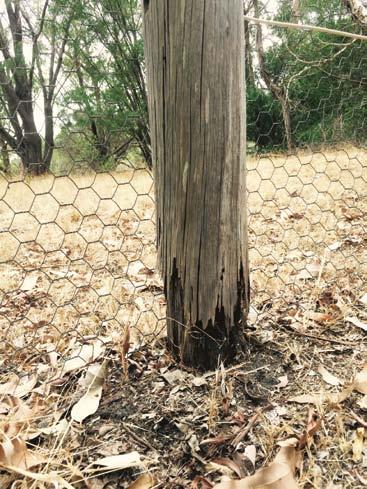
A simple tip on how to use concrete to direct the water can overcome this problem.
To overcome this issue use a concrete ring at surface level to direct water away from the base of the post and away from the hole.
Also note that the very bottom of the hole is filled with compacted soil and rubble.
This will allow any water that does makes its way to the base of the post to drain away.
Obviously moist soil will impact the life of a timber post. This method can only prolong the life by diverting as much water away as possible.
In the drawing, below, the post on the right highlights how a pond might be formed. The post on the right will suffer from water being held at its base.
Note: The dimensions used here are just to highlight the issue, in practice the hole dug for a fence post should be kept as small as possible.

Concrete ring at the base of post will direct water away from the hole.

Dr Nerida Richards holds a Bachelors degree in Rural Science and a PhD in Equine Nutrition. With almost two decades of hands-on experience as a professional equine nutritionist both in Australia and Internationally, Nerida brings a wealth of scientific knowledge and practical know-how to FeedXL. www.feedxl.com/ FeedXL recommends Equi-Analytical (http://www.equi-analytical.com/) for pasture and hay analysis.

Loose soil and rubble will fill with water during rain and become a pond.
February/March 24 - Page 36
Dung Beetles to the rescue
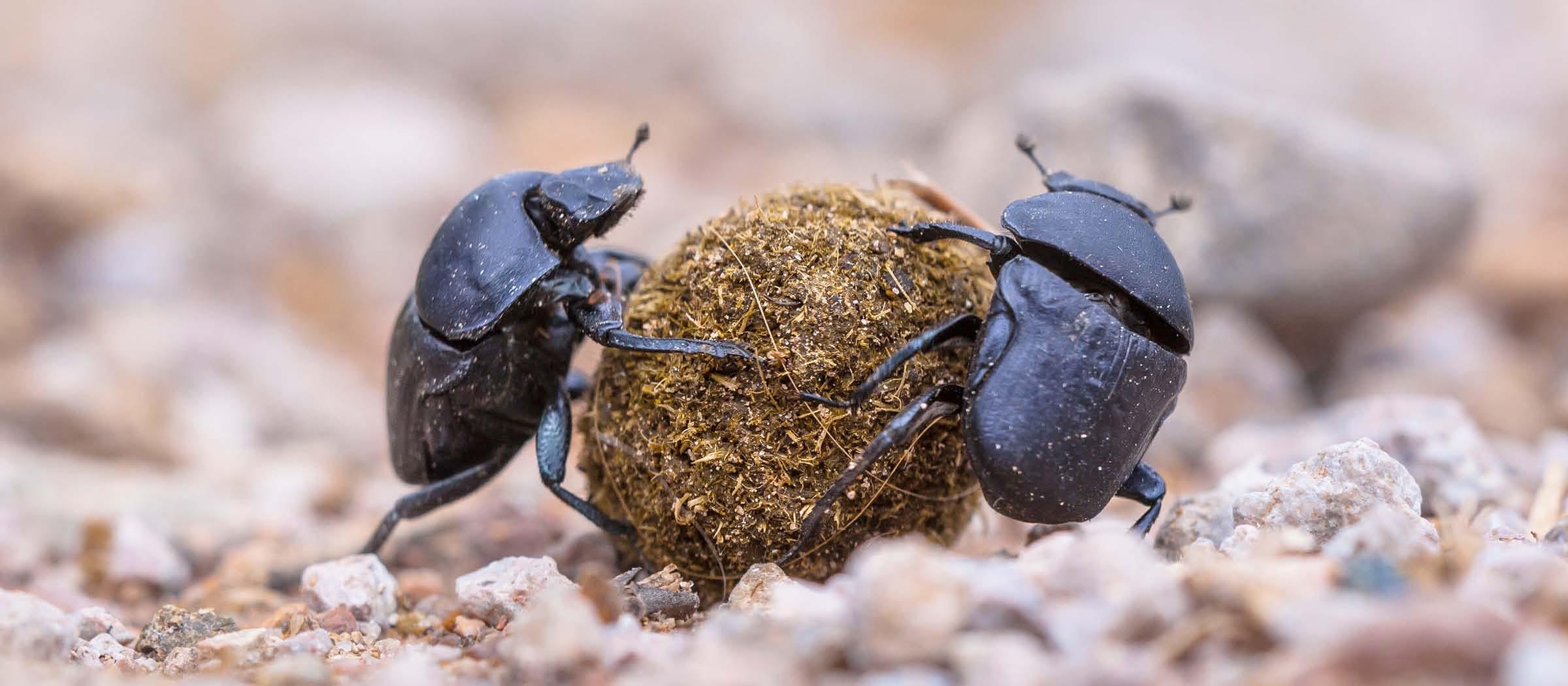
Nature is constantly proving it knows best, and regenerative farmers are tackling the problem of oxygen-starved and depleted flood affected land with the help of a humble yet powerful ally: the dung beetle.
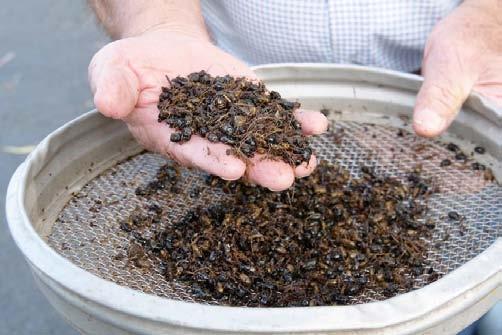
Australia’s wild weather has seen fire ravaging the West and the Eastern states dealing with bushfires and wide-spread flooding, sometimes concurrently and in quick succession. The overall losses or costs are tragic and immense, for towns, people, property, stock, crops and wildlife. The environmental consequences are huge.
With climate change bringing on onein-one-hundred-year climatic events far more frequently, the land has little time to recover. Cleared land suffers profoundly, because ploughed and cleared topsoil that turns to dust or mud is washed or blown away. After flooding, bare paddocks with a crusted surface need aeration and feeding to assist recovery. Yet this has been proven to cause more damage and soil loss. Pouring superphosphate onto cooked, compacted or muddy ground is a useless waste of money and resources.
Regenerative farmers are introducing/ reintroducing the dung beetle to naturally
by Wendy Elks
Dung beetle numbers are depleted by fire and flood, but nowadays populations can be replenished through commercial providers.
On the flood-devastated Murray River border of Victoria and New South Wales, a local dung beetle producer donated dung beetles to a number of strategically located impacted farms across the district, to kick-start this recovery process.Once established, the beetle populations will spread around 1.5 kilometres a year, infiltrating naturally back into the flooded area and assisting the re-establishment plant species.
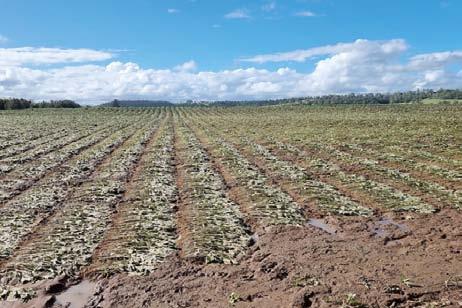
encourage and enable native plant species (which have a better chance of surviving regional conditions) to re-establish.
Once stock are reintroduced to the land, dung beetles improve the soil by taking nutrient-rich animal manure underground, delivering minerals and all-important microbial organisms directly to the root level of plants. The beetles’ burrowing also opens up and aerates the soil, bringing moisture and oxygen to where it’s needed for microscopic biota to recover, increase and work their magic. The burying of manure by dung beetles also reduces nutrient run-off into waterways.
Much is yet to be learned about dung beetles, and the Dung Beetle Ecosystem Engineers (DBEE) project, launched by a team at Charles Sturt University in 2018, should yield valuable results once the data is collated and studied. The project imported and is mass-rearing three new species of dung beetle to help plug a deficit in Australia’s lack of spring-active beetles.
“Dung beetles can play a critical role onfarm, transforming livestock dung into a multi-million-dollar benefit for producers”, a (DBEE) media release states. Distributed to 50 farms across southern Australia, with activity monitored by trained farmers, the benefits of these newly introduced spring-active species should be felt yearround as these industrious creatures bury livestock dung, in turn boosting soil nutrition, improving water permeation and potentially radically reducing fly and parasite numbers.
February/March 24 - Page 37
Dung beetles are taking nutrient-rich animal manure to flood affected land.
Lightning
and its effects on horses and riders
by Anna Marsden
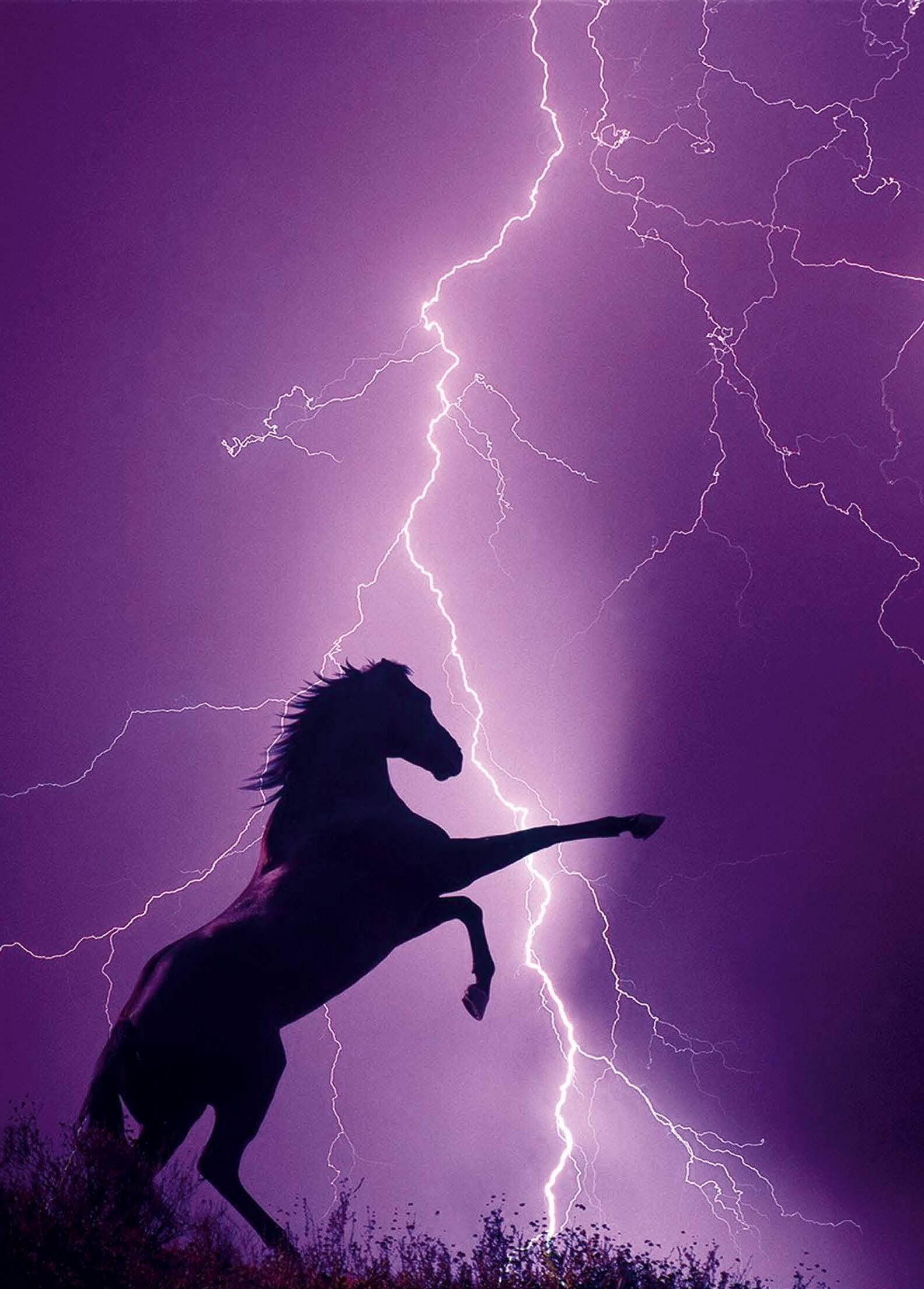
We are accustomed to extreme weather in this country – but mostly that’s defined as extremely hot weather. However, the risks associated with thunderstorms and accompanying lightning strikes have come into sharp focus over the past few months.
Apart from scorching heat waves, violent storms and floods this summer, Weatherzone announced in December last year that there had been 40,465,119 lightning strikes across this continent in November 2023.
(Yes, that’s 40.46 MILLION. In one month!)

Lightning kiLLs –people and animals
There are between five and ten human deaths from lightning strikes each year in Australia, and over 100 injuries, according to the University of Western Australia. About 80 of these injuries result from the use of landline telephones during thunderstorms, with a lightning strike able to travel along unprotected phone lines. Lightning hotspots in Australia are found in the far north, closest to the equatorial zone, but lightning can strike anywhere.
Lightning is responsible for hundreds of livestock deaths every year, and approximately half of all bush fires in Australia.
With temperatures climbing as climate change becomes more extreme, lightning accompanying severe thunderstorms will become an increasingly common phenomenon.
The risk is real – in 2009, the President of Bright Pony Club in Victoria was killed by lightning while setting up for an event.
What exactLy is Lightning?
Lightning is a gigantic spark, a bright flash of electricity, created when a massive imbalance of positive and negative charge occurs within a single cloud, between clouds, and between a cloud and the ground. It is the cloud-to-ground lightning that we see as a lightning bolt during a thunderstorm. The electric charge heats the surrounding air to thousands of degrees, causing the air to expand violently, which results in the crashing noise we know as thunder.
Some types of lightning never leave the clouds but travel between differently charged areas within or between clouds. Other rare forms can be sparked by extreme forest fires, volcanic eruptions, and snowstorms. Ball lightning, a small, charged sphere that floats, glows, and bounces along oblivious to the laws of gravity or physics, still puzzles scientists. is it possibLe to have thunder Without Lightning?
No, it is not possible to have thunder without lightning. Thunder starts as a shockwave from the explosively expanding lightning channel when a large current causes rapid heating. However, it is possible that you might see lightning and not hear the thunder because it was too far away. Sometimes this is called “heat lightning” because it occurs most often in the summer. risks
How do you know when you and your horse are at risk of being struck by lightning? The definition of a thunderstorm is where lightning can be seen and/or thunder can be heard. Any storm that produces thunder means lightning is always present, even if it is obscured by cloud.
There is a rule-of-Thumb way
To reduce your risk of being sTruck by lighTning – iT is called The 30/30 rule.
In 2017, a Clydesdale rescue centre in South Australia lost three of its horses in a single direct strike, while a racecourse worker at a race meet in Northam, Western Australia, died as a result of a direct strike. A promising racehorse, Sunburnt Land, was killed in his paddock while spelling in central Victoria in 2008.
It’s not uncommon for farmers to report cattle killed in lightning strikes. A Google search on cattle killed by lightning in Australia reveals it can happen at any time in a thunderstorm in locations from central Queensland to south west Western Australia.
as riders and horse owners, it’s vital that we know how to react and what to do when there’s a risk of lightning in the vicinity. While we can retreat to our houses and keep away from doors and windows during storms, what of our horses, many of which are out in open paddocks?
The 30/30 rule consists counting the number of seconds between seeing lightning and hearing thunder. If there is less than 30 seconds between the lightning and thunder, then the lightning is within 10km of the listener. (Thirty seconds at the speed of sound is 10.2km). It is time to take action to get shelter. After you have seen the last lightning flash or heard the final thunder, stay safe under cover for 30 minutes to ensure the hazard has passed. Blue sky and the absence of rain are not adequate reasons to ignore the 30/30 rule. Many victims are struck before the storm actually arrives because they wait too long to seek shelter.
This is a rule-of-thumb calculation only, as lightning bolts can move more than 10 km (6 miles) inside a thunderstorm. According to the US National Severe Storms Laboratory, a “bolt from the blue” is a cloud-to-ground flash which typically comes out of the side of the thunderstorm cloud, travels a relatively large distance in clear air away from the storm cloud, and then angles down and strikes the ground. These lightning flashes have been documented to travel kilometres away from the thunderstorm cloud. They can be especially dangerous because they appear to come from clear blue sky.
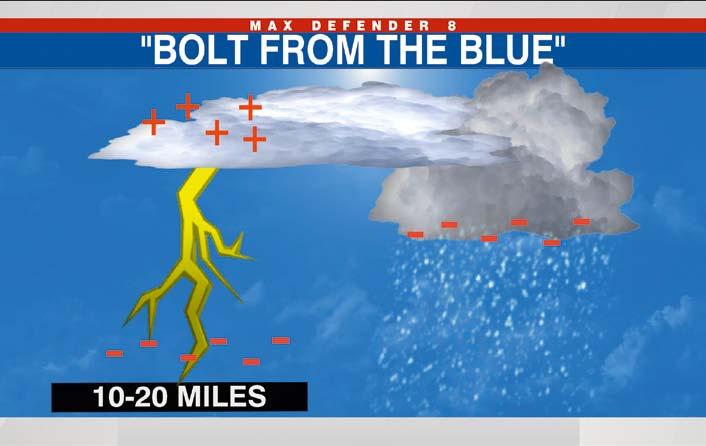
boLt from the bLue
16-32 km from storm

The Australian Bureau of Meteorology has detailed advice on how to deal with thunderstorms and lightning, some of it surprising – like “avoid touching brick or concrete, or standing bare-footed on concrete or tiled floors.”
If you are caught out of doors during a thunderstorm, their advice is to move to shelter immediately, as there is no safe place outdoors during a thunderstorm.
Seek shelter in a ‘hard-top’ (metal-bodied) vehicle or solid building but avoid small open structures or fabric tents.
Importantly, they advise never to shelter under small groups of (or single) trees, and to stay away from metal poles and things like fences and clotheslines.
And of course, don’t ride horses or bicycles in a thunderstorm, or travel in open vehicles (or play golf).
The full Bureau of Meteorology advice can be found at http://www.bom.gov. au/weather-services/severe-weatherknowledge-centre/safety.shtml
Umbrellas do not provide adequate protection from lightning, as lightning can easily travel through the metal frame of an umbrella and into your body.
protecting your horse
Never underestimate the danger of a thunderstorm to the lives of your horses.
What should you do out on the trail, or riding in an arena or paddock?
Quite apart from the risk of a lightning strike, your horse may be spooked by an especially loud clap of thunder, so getting off beforehand is probably a good idea. If you are out trail riding, stay away from ridge lines, and isolated trees in otherwise bare paddocks. you need to avoid being close to tall structures such as surveillance towers, light poles, and antennae. Lightning is attracted to water, so steer clear of lakes and rivers, hosing bays, water troughs, and swimming pools.
If you are riding in an arena, stop your training, dismount and move to safe ground.
Thunderstorms shouldn’t come out of nowhere. The Australian Bureau of Meteorology (BOM) has excellent predictive software – the BOM app - accessible on your phone. Check before you ride, and if there is a thunderstorm predicted, stay alert to the possibility - watch for distant lightning and thunder and keep note of approaching thunderstorm cells on the BOM radar.
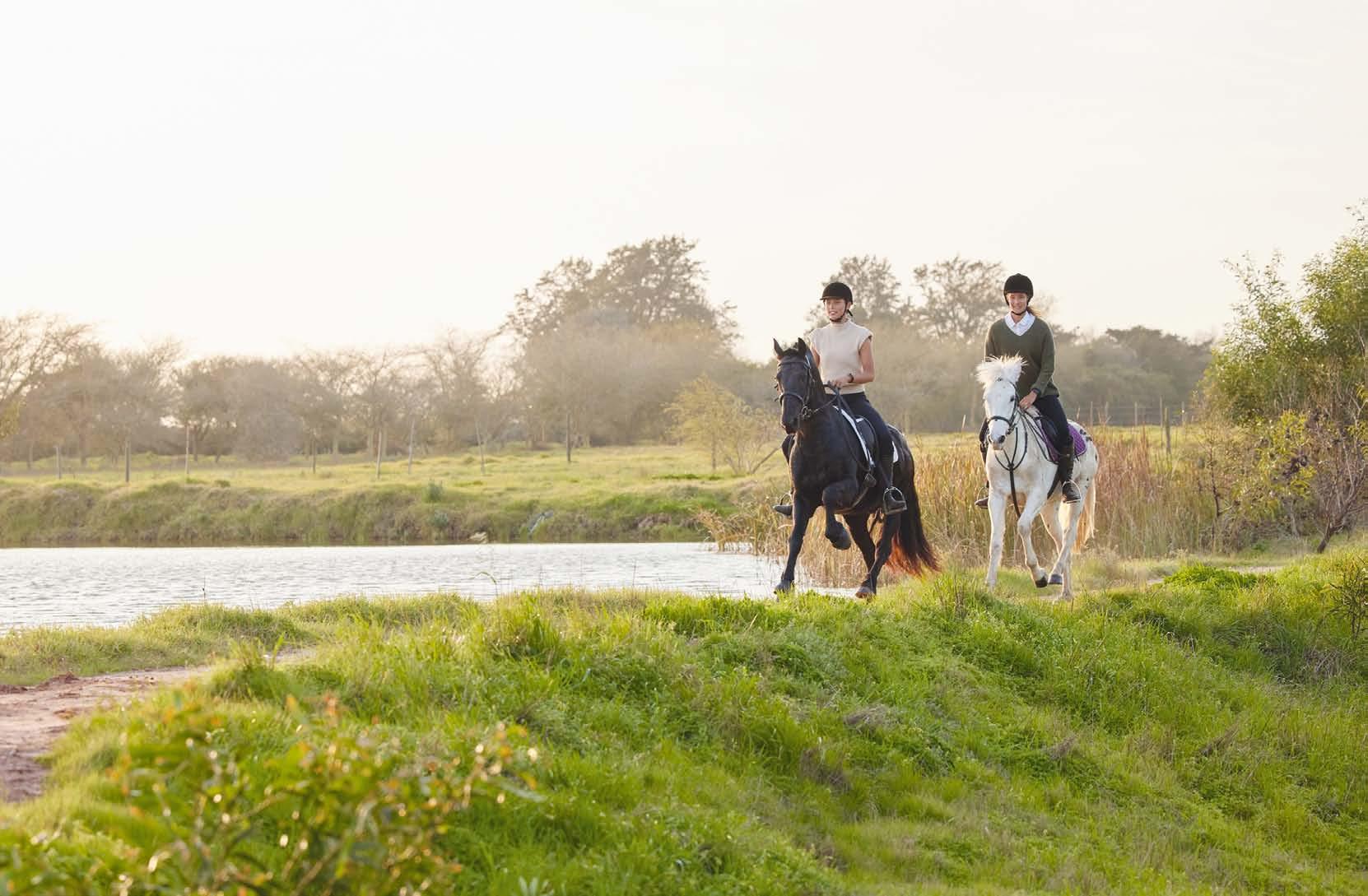
When a thunderstorm is on its Way
With streaks and flashes all around, it’s tempting to go outside to see how the horses in the paddock are coping – are they racing around, standing quietly under their favourite tree, or warily in the middle of a large, bare paddock? Should you be out there checking on them? Are you at risk as well? Should you bring them in or leave them in the paddock?
As usual, “it depends” is the only right answer. There are a lot of things to consider. Knowing how lightning ‘works’, how your property is designed and your horse’s preferences and personality will determine your best plan.
The stable or a metal fenced yard is not necessarily the safest place to keep your horses. In addition, some horses become more afraid of the loud noise if they are closely contained and they can injure themselves if they are shut in a closed stable. If you decide on keeping your horse in, there are ways to lessen the stress it may be feeling. Having a companion, a hay net, ear plugs and music playing may help.
You may find that keeping your horse outside during lightning storms is the best bet but you need to weigh the risks.


It can be helpful to know what your horse does during rainstorms. If it stands with mates under the only tree in the paddock, that could be risky. The taller and more isolated the tree, the more it is at risk of getting struck by lightning. Quite apart from the fact that the tree, or part of it, could fall on your horse, the tree itself could explode, according to Dr Gregory Moore from Melbourne University. This is because lightning strikes can be up to a million volts, and generate temperatures up to 20,000°C. The sap inside the tree instantly turns to steam, causing it to explode or lose huge strips of wood and bark. Clearly, neither you nor your horse want to be under a tree when this happens.
If you are in a very lightning-prone area, you might consider fencing off single trees with non-conductive material (such as plastic) so your horse doesn’t seek shelter near them. They will need other safe options for shade and shelter, however.

If the fence is struck, electrical charge will conduct down the fence line, and affect any animals standing nearby.
Metal shelter sheds in paddocks are also liable to be hit by lightning if they are out in the open. Fortunately, in Australia, metal structures are grounded by virtue of the fact that the metal walls are (mostly) embedded in the ground, but it is worth making sure that your structures for horses really are properly grounded. Get an electrician to install ground spikes for your metal buildings.
If your horse is hit by a direct strike, or because it is standing near the object that has taken the hit, it may be fatal. Otherwise, symptoms include appearing to be blind, mouth twitching, bleeding from the nose, ataxia (lack of balance, coordination, and trouble walking) and being unable to stand. Get the vet immediately.
protecting yourseLf
Standing underneath or near a tree is the second most dangerous place to be during a thunderstorm; the most dangerous is being outside in an open space. An enclosed building with wiring and plumbing is the safest place to be during a storm because the wiring and plumbing will earth the structure and give lightning a safe path to the ground. Trees, sheds, picnic shelters, tents or covered porches will not protect you from lightning.
The safest location to seek shelter is inside a large enclosed structure, with electrical/telephone wiring and plumbing. Keep away from doors, windows, metal fittings and devices connected to the electricity supply. Another alternative is an enclosed metal vehicle, (such as a car, van or bus) but do not touch any metal. Avoided buildings with exposed openings such as small
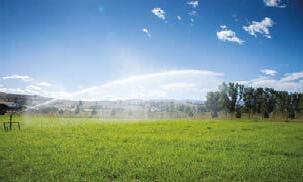








structures or sheds, open paddocks or arenas, and not close to the tallest local structure (for instance a surveillance tower, tree, light pole or antenna). Oddly enough, umbrellas pose a significant risk.
Avoid the use of land line telephones (as if!) and other electrical equipment. Before the storm arrives, if possible, disconnect external aerials and unplug appliances. (Unless you have surge protection, unplug your computer, too.)
If someone is struck by lightning, immediate medical assistance and an ambulance is critical. First aid is required urgently if a person has been struck. A qualified first aider is a great thing to have at events, but even bystanders can administer CPR to save a life. Remember that the human body cannot hold an electric
February/March 24 - Page 41 WA Reticulation Supplies offers Perth’s largest range of professional irrigation products in the leading brands plus rain water tanks, mains power and solar pumping solutions. With the biggest irrigation store in the West we have what you need! trade prices on all materials for february/march www.wareticulationsupplies.com.au sales@waretic.com.au Come in and see the team for expert advice regarding the design, supply and installation of reticulation for your horse property. the grass is greener Armadale 9399-9399 4/277 South West Hwy Armadale WA Midland 9274-5500 3/12 Lloyd St Midland WA Rockingham 9529-1000 8/117-119 Dixon Rd Rockingham WA a reticulation supplies mention this advert to get the discount
Continued
charge, so there is no danger from the victim to those treating. are thunderstorms
on the increase?
Ian Richardson from electrical infrastructure specialists IPD Australia writes that lightning strikes are on the rise. The ongoing warming conditions, facilitated by climate change, are predicted to increase lightning strikes by 50 per cent by the year 2100. Australia has been identified as one of the countries most affected by this phenomenon because of the heightened moisture stored in clouds, which are at the heart of lightning formation. It is true that as you get further away from the equator, the incidence of lightning tends to drop. But with climate change increasing lightning overall, that is little comfort.
What shouLd happen if you are at a competition?
Most sporting codes in Australia recognise the impact of increasingly hot weather on sport in general, but few recognise that the risk of lightning and thunderstorms goes up with the increasing temperatures.
If you are at a competition or training event, the organisers should check for any current severe weather warnings on the day of the activity. If there is a current severe weather warning, organisers and participants need to get up to date information from the Bureau of Meteorology (BOM) website.
The action plan should be based on the 30/30 ‘flash to bang’ rule. When the ‘flash to bang’ count is below 30 seconds, the storm activity is closer than the 10km safety zone. At that point, all activities should be suspended.
With luck, when weather warnings begin and storm activity is detected, someone on the organising committee will be
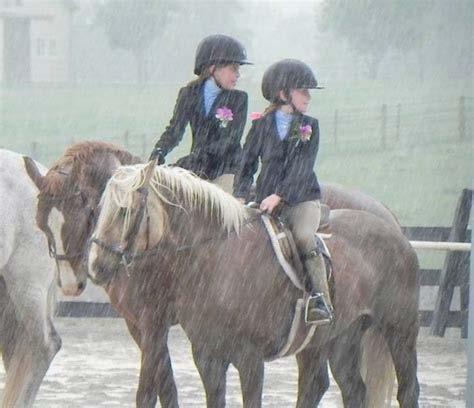
designated to be the ‘weather watcher’ who will monitor storm activity, record information from the BOM and document details when applying the 30/30 rule.
An on-course announcement should be made to ensure all participants at the venue seek shelter and arrangements are made to secure horses.
As trailing storm clouds still carry a lingering charge, activity should not resume until 30 minutes after the final recorded lightning and thunder activity within the 10km safety range. Blue skies and lack of rainfall are not adequate reasons to resume activities early.
If the event or activity is suspended or delayed, the reasons for these decisions should be documented.
MYTHS BUSTED
myth: Lightning never strikes same place twice.
fact: Lightning does strike twice in the same place repeatedly — especially if it’s a tall and isolated object, like the Eiffel Tower in Paris. It gets hit about five times a year.
myth: a lightning victim is electrified. if you touch them, you’ll be electrocuted.
fact: The human body does not hold electricity. It is perfectly safe to touch a lightning victim to give them first aid. Don’t be afraid to administer CPR to a lightning victim.
myth: Rubber tyres on a car protect you from lightning by insulating you from the ground.
fact: Most cars are safe from lightning, but it is the metal roof and metal sides that protect you, NOT the rubber
tyres. Convertibles, motorcycles, bicycles, and cars with fibreglass shells offer no protection from lightning. When lightning strikes a vehicle, it goes through the metal frame into the metal rim of the wheels and then jumps the small tyre gap to the ground. So don’t lean on the doors during a thunderstorm.
myth: structures with metal, or metal on the body (for instance jewellery, mobilel phones, watches), attract lightning. fact: Height, pointy shape, and isolation are the dominant factors controlling where a lightning bolt will strike. The presence of metal makes absolutely no difference on where lightning strikes. Mountains are made of stone but get struck by lightning many times a year. When lightning threatens, take proper protective action immediately by seeking a safe shelter — don’t waste time removing metal. While metal does not attract lightning, it does conduct it so stay away from metal fences, railing, bleachers and so on.

February/March 24 - Page 42
association/cLubs
thunderstorm and Lightning poLicy
A growing number of national sporting bodies have detailed policies to deal with thunderstorms and lightning. These include Sports Medicine Australia, AFL, Tennis Australia, Hockey Australia, Volleyball Australia, Australian Swimming Coaches and Teachers Association and Play Football Australia.
Very few Australian equestrian bodies have a policy on dealing with the risks of lightning. Neither Equestrian Australia nor Pony Club Australia have thunderstorm and lightning policies.
The Show Horse Council has an extreme weather policy, but limits it to hot weather, while HRCAV states on its website that it is expected organisers will observe all Extreme Weather alerts including alerts of storms, extreme winds, and extreme fire danger and will not knowingly bring competitors into danger.
Most horse racing bodies have a thunderstorm and lightning policy, except for Victoria and Queensland.
reader’s






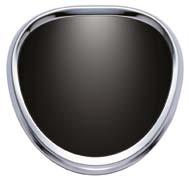

STORM LOSS
When severe thunderstorms impacted much of Western Australia on the evening of Friday January 12th there was little anyone could do as strong winds, rain and thousands of lightning strikes broke a 44 day dry spell. As is usually the case with summer storms some areas were impacted more than others with the small town of Gingin, about an hour north of Perth, particularly hard hit with multiple reports of storm damage and a bushfire emergency in the days following after lightning started a number of fires.
Local residents and Gingin Trading owners Moyra and Len Choules’ property was in one of the areas impacted, with them

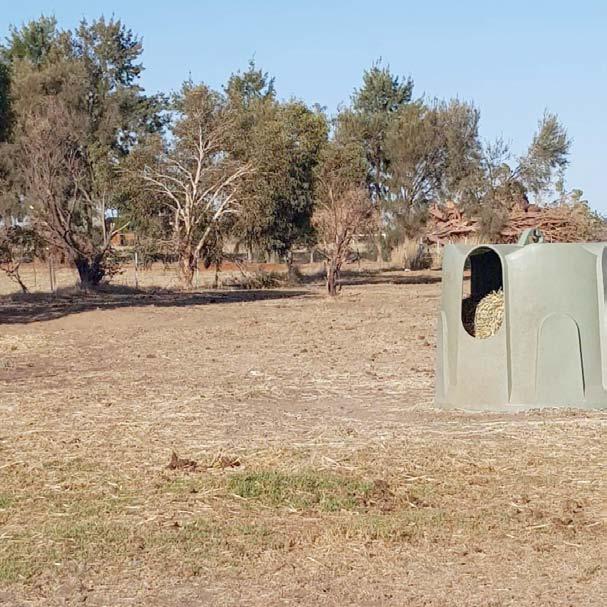
taking shelter inside their home as strong winds and lightning strikes wreaked havoc for 20 odd minutes. As soon as it was safe to venture out Moyra went straight to the horses as she’d seen two galloping around the large cleared paddock during the storm and another laying on the ground by the fence. Taking bolt cutters to free the horse from the fence, instead Moyra found 25 year old Thoroughbred Capel deceased, his body laying parallel to the fence and all four legs sticking through to the other side. Two of Capel’s paddock mates had jumped the fence into the adjoining paddock while his other paddock mate Polish stood dazed in the middle of the paddock. While there was a little foam around Capel’s mouth his mesh rug was clean and he had no visible marks on his body, and there was no signs of a struggle in the ground surrounding him, leaving Moyra to presume his death was pretty instant. She wonders if Polish might have experienced some effects from a lightning strike too as he appeared shell shocked and dazed for quite some time and acted a little strangely for a week or so after, although his behaviour could have been the result of mourning his long time paddock mate.
Sadly the storm also resulted in the death of another horse in the area after being hit by a large branch as he took shelter under a mature tree and one horse sustained a large gash from flying debris. Moyra will never know if Capel was killed by lightning hitting the ground near him or perhaps the fence that he was nearby but she is thankful his death appeared to be quick and he did not suffer.
February/March 24 - Page 43 0447 710 056 www.cdtractors.com.au 112 WANDENA RD, MUCHEA WA 6501 FOR A RANGE OF EQUIPMENT TO SUIT YOUR EQUESTRIAN PROPERTY TRACTORS FROM 25HP & UTV’S FROM 22HP


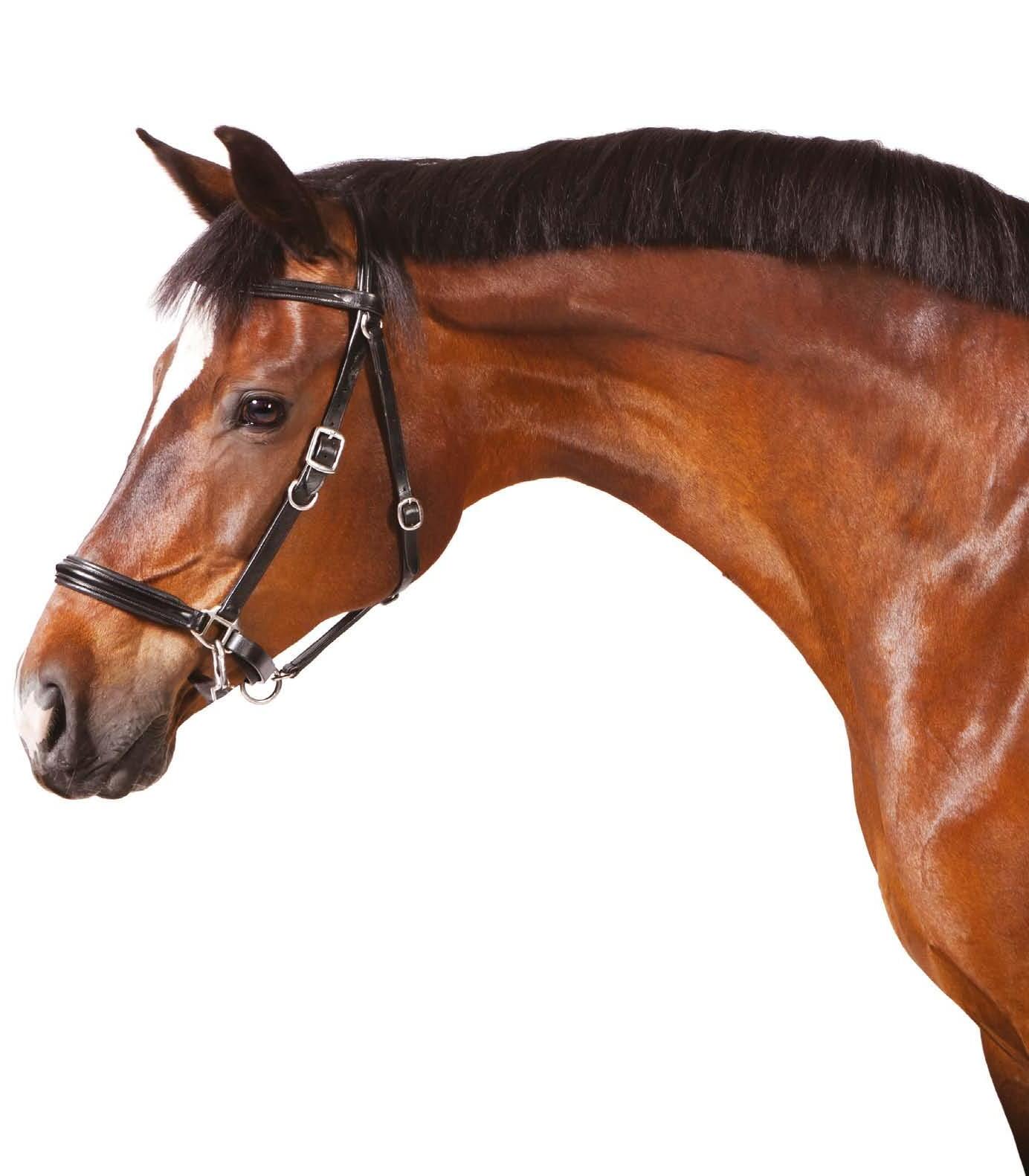
CC CC

Ejoy your horse...
Ejoy your horse...
whatever the weather!
whatever the weather!
The seasons in Australia can greatly influence your riding habits. In most states there are days, and sometimes even weeks, when it is too hot or too humid to compete or even ride. So, what can you do with your horse over these periods?
Many riders opt to spell their horse during the warmer months, and that can be a viable option, but if you’d prefer not to spell there are lots of activities that you can do with your horse that will help consolidate your training without too much sweat!
However, before we begin, it’s important to know a little bit about your horse and the heat.
About the Author: Dr Portland Jones
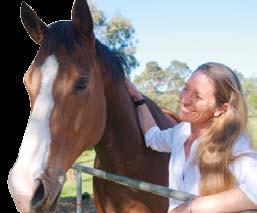
There are two main conditions that can effect exercising horses in hot climates and these are heat stress and dehydration. Although they can present simultaneously it is also possible for a horse to have one but not the other. It is useful to understand both when managing horses during hot weather.
Heat stress
When horses exercise they generate heat - the more intense the exercise, the quicker the heat is generated. A galloping horse can generate enough heat to raise its body temperature by 1 degree for every minute of exercise. This heat is lost through the evaporation of sweat. When it is particularly hot or humid the horse’s capacity to lose heat via evaporation is limited and this means that the horse may be more prone to heat stress.
Horses with heat stress will have elevated rectal temperatures, will look depressed and will have an increased respiratory rate. Those that have been exercised excessively in very hot temperatures (such as endurance horses) may develop a more severe form of heat related illness and might become irritable, shake their heads and kick out randomly. Both forms of heat stress require immediate action. Horses should be continuously cooled with the application of running (preferably very cold) water until the vet arrives.
A horse trainer, lecturer and author, Portland has been coaching riders and training horses using an evidence based approach for many years and is particularly interested in welfare and sustainable training practices. She has written widely about Equitation Science and has recently been involved with the rewrite of the Pony Club Australia curriculum – the first time an evidence based model has been applied to Pony Club. Portland’s second novel Only Birds Above has been published and she is working on another novel and a second non-fiction book about horses.

The rate at which the horse can sweat and therefore lose body heat is determined by the combination of both heat and humidity. High humidity makes it more difficult for both horses and humans to sweat, which is why it feels so uncomfortable to exercise when it’s humid.
The Wet Bulb Globe Temperature (WBGT) is a measure of heat and humidity that offers insight into how easily a horse can become heat effected on a given day. The Australian Veterinary Association recommends that at a WBGT index of 28-32 caution should be taken when horses are exercised and rapid cooling undertaken if required. If the WBGT is over 33 all equestrian competitions should be cancelled as the potential for heat stroke is too high. The WBGT can be found at http://www.bom.gov.au/ info/thermal_stress/
You can see from the chart that when the temperature is high but the humidity is low the WBGT is not high. So, for example on a day when the temperature is 37 but the relative humidity is 25% the WBGT is only 32. However, when the temperature is 34 but the relative humidity is 45% the score is 33. These readings will be affected by wind speed and the amount of cloud cover but they provide a useful insight into the ways that heat and humidity interact to affect the horse’s ability to lose heat during exercise.
We

Note:
1. set goals for the year ahead
The less busy hot weather season provides a great opportunity to reflect upon the current state of your training and make goals for the upcoming season.
De HyD ration
When horses sweat they lose both fluid and electrolytes. If fluid is depleted faster than it can be replenished the horse may become dehydrated. The symptoms of this can be an unsteady gait, muscle weakness and a lack of coordination. Interestingly the horse may also lose interest in drinking because the loss of electrolytes interferes with the thirst response.
The main components of electrolytes are sodium chloride (salt), potassium, magnesium and calcium. Horses that are not exercising excessively or living in an extremely hot environment can get by with access to a salt block or around 25-40 grams of salt (around 2 tablespoons for the average 500kg horse) added to the daily ration. Horses that are galloping or jumping in hot environments will need supplemental electrolytes.
It is very important to always offer plenty of fresh, cool water for the horse to drinkparticularly when electrolytes are given as they will trigger the thirst response.
Many horse owners test for dehydration by pinching a small fold of skin on the shoulder and watching to see if it snaps back when released. If the skin is slow to return to its original position the horse is very possibly dehydrated and needs fluid immediately. However, as with humans, it is far better to avoid dehydration in the first place.
Continued
Although the hot weather may curtail the competition season it doesn’t mean that there are no more opportunities to train your horse.

T Bu LB G LOB e Te M per AT ure C HA r T Temperature (ºC) r elative humidity ( % )
Avoid exercising the horse unless absolutely necessary if the WBGT score is over 30 and avoid stressful situations like transport, a change of paddock or the removal of a friend if the weather is hot and humid. This table is compiled from an approximate formula which only depends on temperature and humidity. The formular is valid for full sunshine and light wind.
tH ings to D o w H en it’s too H ot to ri D e
In order to set goals it’s necessary to make an accurate assessment of your current position. It’s a little bit like using Google maps, the app has to know your current location in order to plan a route for where you want to go. This is a good conversation to have with your coach or a trusted mentor. We are often too hard on ourselves and tend to dwell on our failures so ask your coach to help you identify areas of both strength and weakness.Then you can make

Address any training areas that need an overhaul. You could embark on a program of desensitising your horse to the scary things and reward when it is accepting of these.
a plan for the year ahead. The goals you set don’t have to be competition goals, they can simply be training or management goals that you want to achieve. For example you may want to become more confident on trail rides or improve your position or increase your fitness.
When setting goals it’s important to outline clearly what success looks like, otherwise you won’t know if you’ve achieved your goal. It’s also really important to break your goal down into many small steps. There is an old saying: a journey of a thousand miles begins with a single step. Goal setting is about setting yourself up to take the first step and then the second and the third and so on. The steps you choose should be clearly defined so that it’s easy to know when to move onto the next one.
Write your goal down and write down a plan for how you’re going to achieve it. It doesn’t matter if the goal seems too big or ambitious – as long as it doesn’t effect your horse’s welfare and your safety, it’s good to dream big! It can be really useful to find yourself someone with whom you can share your goal. Sometimes people call this person their accountability partner. It can be your coach or a trusted friend - their job is to check in occasionally on your progress.
2. address any training gaps
Another task for the warmer months and one that you can do once you’ve talked to your coach or mentor is to fix up any gaps in your horse’s training. Have a chat to your farrier and body worker too – they will tell you if your horse’s behaviour could do with an overhaul.
Ask yourself if there is an area of your horse’s training that could be better. For instance, does your horse consistently shy at the same thing? Summer is a great time to embark on a program of desensitisation. Horses don’t pretend to be frightened but rather, are driven by their evolution to avoid things that frighten them or that they don’t understand. Because of the importance of the flight response to the horse’s long term survival avoidance habits relating to scary things can be acquired with very few repetitions.
A program of desensitisation must never include punishment but rather, should start so gradually that the horse doesn’t react to the scary thing. You get more of what you practice so if the horse is frightened by the scary thing what he learns is to be frightened of the scary thing. Introduce the scary thing at a very low threshold and reward the horse generously for standing calmly and do that progressively until the scary thing eventually becomes a signal that generous rewards are coming.
Another area of training that it is good to assess is loading onto a float. Unfortunately many of us live in areas that are prone to bushfires and flooding. Too many horses have been lost because when the time came to be evacuated their float training was not good enough. Float training must be absolutely reliable because in an emergency your horse may have to load onto a strange float or be loaded by someone unfamiliar.
If you’re unsure how to address your horse’s float training ask your coach to help outline a program to help.
3. assess your own fitness
Sadly, after middle age, adults lose 3% of their muscle strength per year. The muscle loss and subsequent weakening is called sarcopenia and it particularly effects women over the age of fifty. This is often the time when lots of women finally have time to ride their horse more as their children have grown up and they have more time for themselves.
If you are planning on riding into your old age one of the best insurance policies is a program of resistance training to combat age-related muscle loss. This is particularly relevant for horse riders as it seems that the fast twitch muscle fibres are the first to disappear and it is those that provide the strength for quick, powerful movements - the sort of movements you need in order to stay on your horse if it bucks or shies.
The good news is that it doesn’t take much to offset the effects of aging on your muscles. A couple of hours per week is enough to maintain strength and fitness. You don’t even need to join a gym; a good personal trainer can develop a program for body

February/March 24 - Page 48
activities for a H ot Day
If you’d rather not ride there are still plenty of ways to engage with your horse.
try groundwork
Having good control over your horse on the ground has many benefits both for your safety and your horse’s welfare. If you don’t know how to progress there are some groundwork dressage tests available online (or in the Pony Club Australia manuals) that will test your abilities.
take your horse for a swim
Most coastal cities in Australia have designated horse exercise beaches that have plenty of room for float parking. Just remember to go early enough so that your horse doesn’t get too hot on the float ride home.
give your horse a shower
A cool hose down on a hot day can leave you both feeling so much better.
Let your horse bob for apples and carrots in a bucket of water
Float safely chopped up pieces of your horse’s favourite fruit in a bucket of clean water and let them catch them. On hot days you can freeze the fruit. Not only will this keep your horse occupied it will also help with hydration.

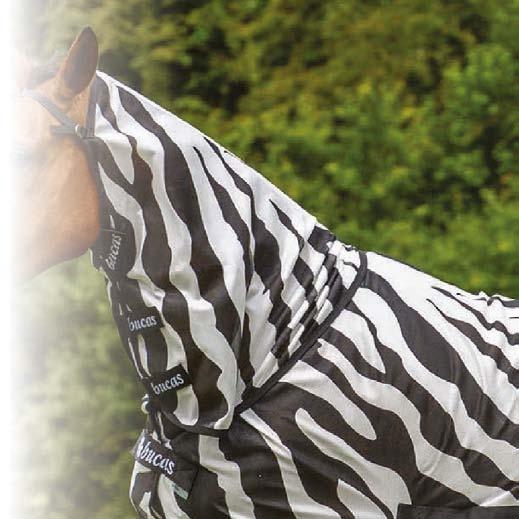

February/March 24 - Page 49
Let’s talk about
sid e ways

Yielding the hindquarter, yielding the forequarter, leg-yield and shoulder-in.
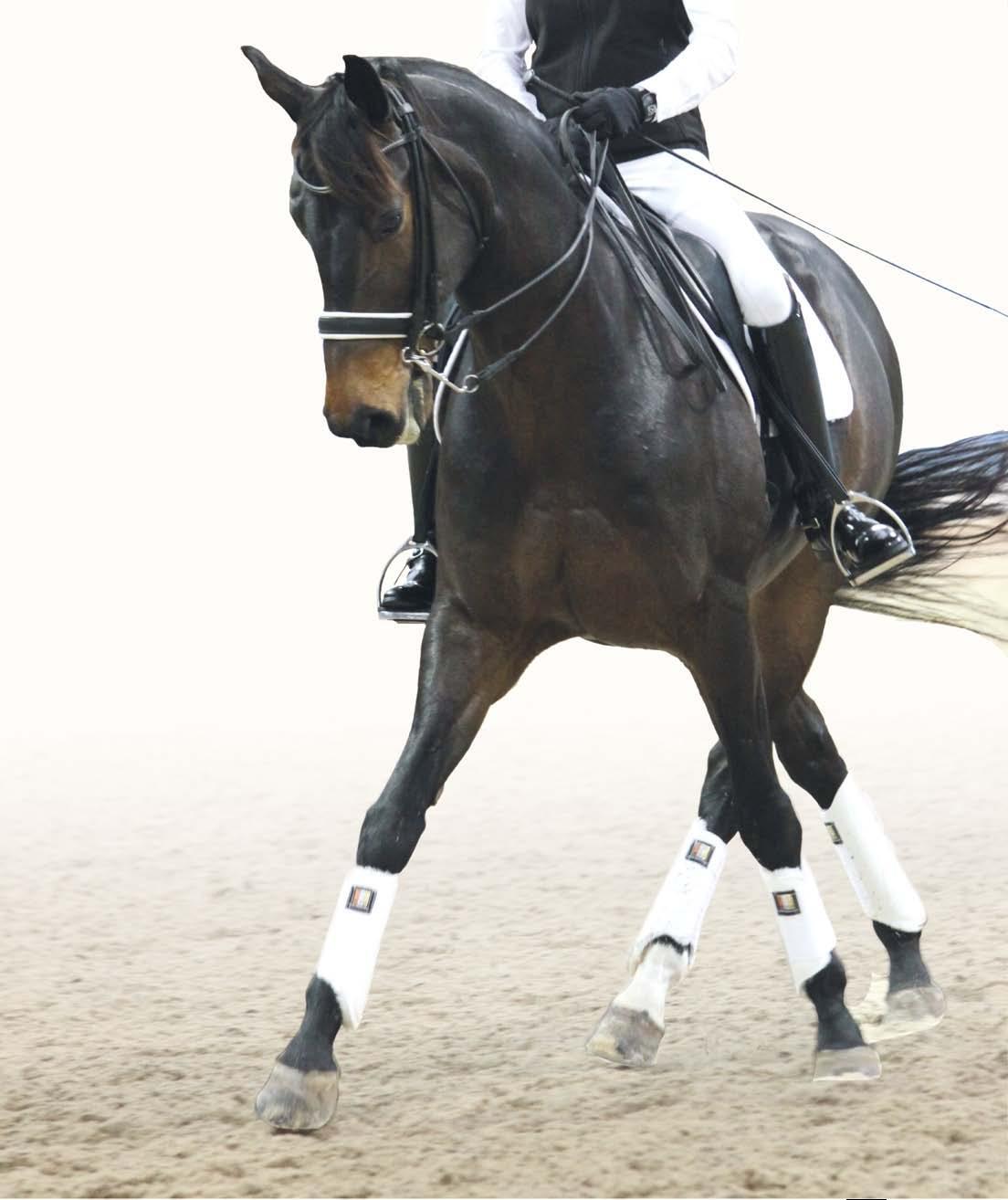 by Liz Tollarzo
by Liz Tollarzo
When people hear the words ‘lateral work’ in regard to horses, they may immediately think of dressage - watching those Olympic horses with fancy crossing legs moving sideways around an arena - however teaching a horse the ‘sideways’ or lateral exercises can be useful for any horse’s education, whether competing in dressage or not!
Each lateral movement has particular benefits for the horse, developing more suppleness, strength, straightness, co-ordination and obedience and as such increasing the time a horse will remain sound later years of its life.
Whether a Pony Club pony, jumper, western, working equitation, show horse, polo pony, polocross, eventer, dressage or just a horse used for pleasure riding - the ability to move sideways when asked is of major importance and useful for every rider, from being used to open and shut gates or being able to be directed and controlled with little or no use of the reins. Lateral work has particular usefulness in building muscles and strengthening tendons and ligaments of the horse, particularly through the shoulders, back and hindquarters, which can completely change the physical appearance as well as helping prevent injuries, especially for fast, hard or repetitive work.
February/March 24 - Page 50
Lateral work can be started on the ground with the horse in a halter, cavesson or bridle and using a training stick or dressage whip, the horse can be taught to move away from the pressure or movement of the stick — starting generally with moving the hindquarters away, then the forehand and finally the whole body can be asked to yield sideways when directed. These exercises would be similar to first a turn on the forehand (horse yielding the hindquarters), turn on the haunches or hindquarters (horse yielding the forehand), shoulder-in (the forehand slightly bent around the handler with the forehand travelling in on a different track to the hindquarters) and then a sidepass type movement (horse yielding the whole body sideways). Most lateral work is trained easier and quicker if first taught from the ground with the exceptions being movements where the horse is flexed and
TURN ON THE FOREHAND Yielding the hindquarters
Normally the best way to start teaching a lateral exercise, the turn on the forehand is best first taught from a halt - the turn happens when the horse’s forelegs more or less stay still and the hind legs step under and across sideways as the inside front leg forms a sort of pivot. In most examples of training the turn on the forehand, the inside front pivot leg should not actually stay planted in the ground (as this is bad for the horse’s joints), but instead step up and down or with some slight sideways forwards motion with the outside front stepping in a small circle. The inside hind leg steps under and across the body and the outside hind steps forward and sideways outwards as the horse turns. This is the easiest start exercise and can be first done facing a fence before attempting it in the open. Once a horse understands this exercise it can be done from the walk which will help keep the horse flowing and thinking forward as well as testing the rider’s or handler’s timing - this is a very useful exercise for opening and shutting gates!

bent in the direction of travel such as travers, renvers and half pass — these are certainly able to be done from the ground but require a knowledgable trainer with good feel and timing. With ridden work - all exercises should be first taught at the walk and for a short duration and only increased when the horse understands the aids without tension. Only once the rider or handler is confident the horse understands the work should any lateral exercise be increased in duration and/or at a higher pace. Once a horse feels discomfort or becomes tense and associates this with a particular exercise, it is very hard to regain a horse’s trust. Taking the time to ensure the horse understands whilst avoiding over-stressing muscles and joints will keep the horse keen to learn and attempt the new movements.
TURN ON THE HAUNCHES Yielding the shoulders
If teaching on the ground the next step is yield the shoulders, this can also be called a turn on the haunches (performed from a halt or walk) and when ridden at a walk this is a walk pirouette. However, many riders will prefer to teach the leg yield beforehand as this is often an easier movement when under saddle. The turn about the haunches can be first taught facing a fence to encourage the horse to understand the turn whilst allowing the handler or rider to use less restraining aids. To perform the turn the horse keeps the inside hind ‘pivot’ leg more or less on the spot, whilst the forehand of the horse ‘turns’ around, with the outside foreleg stepping forward and across the inside foreleg. Ideally again the inside hind should not remain planted on the ground but instead walks a small circle or marks time up and down as the horse turns to avoid straining tendons and ligaments.
However in western competitions it is required that the inside hind stays as a pivot and only is moved when needed as the horse turns, such as a ‘spin’ movement. When teaching a ‘roll back’ type
Turn on forehand
3: Driving leg and seat aids with giving hands to create forward movement.
2: Slightly bend the horse away from the direction of movement. The rider’s inside leg applies pressure behind the girth. The outside rein controls the bend and prevents the horse from moving forward.
Turn on haunches
1: Begin the turn on the forehand with a half halt.

February/March 24 - Page 51
example of this movement often it is encouraged that the outside foreleg actually steps across and behind the inside foreleg - this turn often having been started after a reinback. A ‘dressage’ turn on the haunches or walk pirouette must not step backwards or ‘ground’ the hind feet at any time but remain in the correct walk sequence with the hind feet walking the smallest circle possible, the inside hind being lifted up and placed down almost in the same spot with no sideways deviation, with the tightest possible pirouette being the width of the horse’s haunches.
If teaching turn on the haunches from the ground the horse may be straight or even flexed away from the direction of the turn as the handler can use their body to assist directing the horse where to move.
However, when being ridden the horse should be more or less straight, or have slight flexion and bend in the direction of the turn.
The rider must always only ask for initially one step and take their time to make sure the horse completely understands the exercise before building up from one step - to a quarter turn (three steps) before attempting to complete a full 180 degree turn.
LEg YiELDiNg
In a leg yield the horse travels both forwards and sideways whilst keeping its spine straight, with both shoulders and hindquarters being equal distance from the spine. The horse is flexed (meaning the rider can see the horse’s inside eyelash and side of the nostril) slightly away from the direction it is travelling with the inner legs crossing in front of the outer legs, whilst the horse’s body remains parallel to the outside wall.
Leg Yield right
Directionoftravel

Tracks
The leg yield is usually performed at walk and trot although can be done at canter. The amount of sideways travel should always be little until the horse learns how to cross its legs without hitting itself. Once it is confident the angle can be increased until four equally spaced tracks can be seen by the horse’s legs — never more than 45 degrees — the angle is not the priority however but the quality of the movement and the horse’s acceptance of the aids is!
As rider’s must have the ability to co-ordinate their aids the ability to do the turn on the forehand proficiently at the halt and walk is very important before attempting leg yielding.
This movement instantly demonstrates whether a horse understands how to move away from the leg pressure and highlights the horse’s supple and stiff sides whilst showing any problems in the contact to the horse’s mouth.
For dressage competition (novice level) the horse should leg yield with a straight spine - from the head to the tail with only flexion at the poll away from the direction of travel with the horse travelling forward and sideways almost parallel with slight tendency for the forehand to be in the lead (it is a bad fault for the hindquarters to lead).
However there are exercises and different trainers who may incorporate a slight bend away from the direction of movement, some with clear bend, shoulders or hindquarters leading etc, depending on what exercise is being used and for what purpose. It is however important to remember that the way a horse is flexed is always termed as the “inside” which can be confusing in performing a leg yield as the horse is flexed away from the direction of travel. Therefore to perform this movement the terminology to use for travelling sideways towards the left, away from the right leg — is “leg yield to the left”.
The first ridden aids to perform a leg yield left would be — using the right hand, ask for the horse to flex at the poll by squeezing and

February/March 24 - Page 52
that the Right leg is on the girth, ready to be applied to move the horse forward and straight if impulsion is lost.

Top exporter Scoot Boot™ names James Arkins as Brand Ambassador
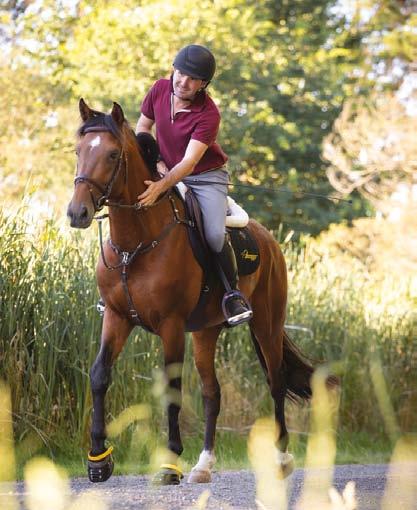
Tasmanian-based hoof boot company Scoot Boot has announced elite Australian and international show jumper, James Arkins, as their official Brand Ambassador.
Arkins is well known as one of Australia’s top show jumpers. He competes on the international circuit each year and is now preparing for his European and United States campaign for 2024.
James has been trialling and using Scoot Boots with some of his top jumpers at his horse stud, Rosthwaite Farm in Moss Vale, New South Wales. He is now ready to implement them into his competition program.
“There has been a movement in recent times to compete showjumping horses barefoot, with many top riders globally making the transition, including the gold medal winning team at the Tokyo Olympics and the gold medal winning team at the 2022 World Championships. To facilitate this, these riders use Scoot Boots as a vital part of their training program. I was keen to try them for myself,” Arkins said.
Scoot Boot Co-Founder and Chief Executive Officer Annette Kaitinis said Arkins was a great choice for Brand Ambassador as his methods and ethos were fully aligned with her company.
“Co-founder and former Farrier, Dave MacDonald,
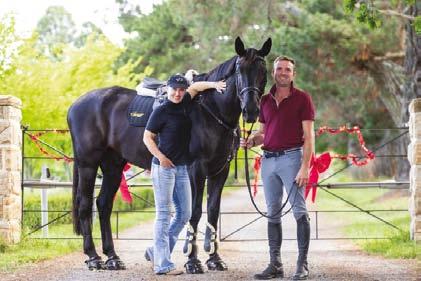
designed Scoot Boots to enable more horses to go barefoot and enjoy longer, healthier and happier lives,” Ms Kaitinis said.
“While James does need to continue using iron shoes on some of his horses, it’s an achievement to see him accept hoof boots as an alternative and transition some of his prized horses to barefoot.”
“He is a great role model for young riders as well as a trainer and coach to emerging talent up to the highest level in showjumping.”
As part of his Ambassadorship, Arkins will be working closely with the Scoot Boot team to help grow the brand globally and share his experiences as he continues using hoof boots and promoting the barefoot movement.
releasing pressure on the right rein whilst the right leg supports and guards against the horse turning. The left hand keeps steady contact and prevents the horse from bending the neck whilst regulating the speed/tempo and preventing the horse’s shoulder from falling out. The rider’s weight should be equal on both seat bones - however there are some occasions where the weight may be moved to the inside seat bone to be over the active leg and yet a different horse may require the rider’s weight to be shifted slightly towards the direction of travel to help encourage the horse to move that way (this is why having someone knowledgable watching the rider is so important when starting leg yielding). Once the flexion to the right is established, the rider moves the right leg a little behind the girth to ask for the sideways movement. The right (inside) leg needs to be applied (pulsed) as the horse’s inside hind leg is lifted off the ground and about to step forward, this enables the horse to respond immediately to the aid stepping both forwards and sideways. The rider’s left leg remains in line with the rider’s ear, shoulder, hip and heel at the girth in a guarding and controlling position, ready to ride the horse forward and straight when the movement is completed. To finish the leg-yield, the rein and leg aids once again return to neutral, becoming equal and both legs applied as necessary to create forward energy. It is very important as with any lateral movements that the horse’s movement is not diminished or affected by the sideways exercise but stays pure and expressive at all times - showing no difference in the gait whether going straight or laterally. The leg yield to the right uses the same aids but obviously in reverse.
SHOULDER-iN
Once shoulder-in work begins, the horse is on its way to develop collection, straightness and self carriage - increasing its obedience, strength and suppleness. The horse’s shoulders are





Inside rein is used in a pulsing action in time with the rhythm of the gait to keep the horse soft, flexed and slightly bent. Inside leg at the girth encourages the bend and assists in stepping the horse’s inside hind underneath its body.



The rider’s shoulders must be parallel to the horse’s shoulders and the rider’s hips parallel to the horse’s hips.


Exercise: Starting shoulder-in from a corner..
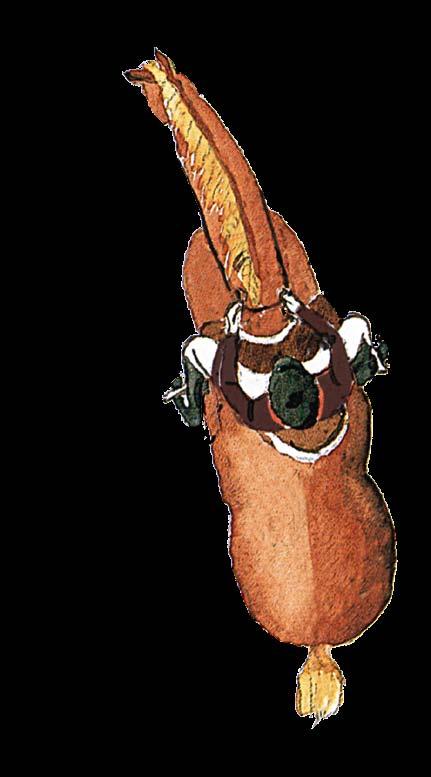
Outside rein steadies and contains the forward energy
Outside leg is slightly back guarding that the hindquarters don’t swing out.

Once shoulder-in work begins the horse is on its way to developing collection and self carriage –increasing its obedience, strength and suppleness; attributes all necessary for this seemingly ‘easy’ lateral movement, which is in fact a very difficult exercise to perfect.

brought in from the track as if turning onto a small circle, the horse then continuing along that line on three tracks — bending around the inside leg of the rider (or around the handler), flexed and bent away from the direction of travel. The horse’s inside foreleg passes and steps in front of the outside fore, whilst the hind-legs remain on the track travelling more or less straight (they travel closer together but must never cross).
Three Tracks
Looking from the front or back, the spectator can only see three legs, which is why this lateral movement is called ‘three tracks’. The first track is the outside hind leg, the second is the inside hind and outside foreleg in line with each other and the final third track is the inside foreleg. The angle depends on the conformation of the horse however it is approximately 30 degrees.
Shoulder in can be performed in walk, trot and canter although when cantering ‘shoulder fore’ is often used
February/March 24 - Page 54
instead, which is similar but ridden with less angle to assist with straightening the canter (shoulder-fore can be used at any gait).
Used in dressage tests from Elementary up to FEI shoulder-in is equally useful to any discipline as it strengthens the horse’s back, loins, hip, stifle and hocks. As the horse’s inside hind steps further under the centre of gravity, this shifts more weight onto the horse’s hindquarters enabling the forehand to become lighter and more elevated - all this increasing collection whilst helping correct the natural crookedness of a horse. As the horse improves its joint and ligament mobility as well as toning, suppling and developing muscle whilst redistributing its body weight more over the four legs by moving the centre of gravity more to the hindquarters, the chance of common injuries lessen.
Riding the shoulder-in
To perform a shoulder-in on the left rein, the horse will be bent and flexed around the rider’s inside or left leg - similar to when riding a corner or circle. After riding the corner out of the short side of an arena, the rider continues to turn the horse as if to ride a circle - as the horse steps off the track with the forelegs the rider applies the inside (left) leg at the girth encouraging the bend. This slight sideways pushing aid assists the horse’s inside hind leg to step further underneath the body towards the centre of gravity, whilst at the same time the outside (right) rein steadies and contains the forward energy (keeping the horse at the same angle of the turn whilst stepping with the hind legs straight down the track). The rider’s outside (right) leg is slightly back to ensure the horse’s hindquarters don’t swing out and the inside rein is carefully used in a pulsing action in time with the rhythm of the gait to keep the horse soft, flexed and slightly bent and should be able to be given at any time without affecting the shoulder-in. There are some instances where the inside rein may be shortened before the shoulder-in is started, however this is a training style and not a rule of thumb.
At all times as with all lateral exercises, the rider’s shoulders must be at the same angle as the horse’s shoulders and the rider’s hips always at the same angle as the horse’s hips.
The rider must keep his/her head in the centre of their shoulders and resist the urge to turn the head to look up the track or look down. Generally the rider’s weight should be a little more down the inside seat bone however some horses may require the opposite and some more equal weight - seeking the assistance of a experienced instructor to assist with what works best for the individual rider and horse is recommended.
Finishing the movement
A shoulder-in is finished by either riding forward into a turn or onto a circle; or by straightening the horse by bringing the horse’s shoulders back to the track. Whenever a shoulder-in goes ‘wrong’ it is often the best solution to circle out of it and when returning to the track - start again - this keeps the horse forward and willing.
In most dressage tests the judges are looking to see that the rider actually brings the shoulders back to the track when completing the shoulder-in such as before a corner.
This seemingly ‘easy’ lateral exercise is very difficult as it is a small angle and doesn’t involve a lot of bend, it is often ridden with too much or too little neck bend and riders must always think that the horse’s spine from the tail through the back and the neck itself must all be showing the same amount of bend throughout to perform a true shoulder-in!
Conclusion
There are no specific ‘do or don’ts” in how to combine different lateral movements although there are rules when competing in official dressage freestyle competitions. It is important however, to be aware that whilst it is tempting to just randomly try different ideas without prior planning this approach will often result in a poor performance with an unclear result - leaving onlookers (and perhaps the horse) wondering ‘what was that supposed to be?’
The rider’s aim should be to always maintain mental relaxation of the horse, allowing it to understand each movement clearly without confusion, before changing or attempting to add a following movement. Only a relaxed horse can give its mind and body to the rider to perform without resistance and to obtain this the rider must clearly understand the aids for each movement and remember the feel of each ‘correct’ exercise - one at a time. If the horse is rushed from one movement to the next without the correct execution of ‘either’, any previous training can actually be ‘undone’ and the response to the aids will decrease instead of improve, as well as there being the possibility of physical damage if the horse becomes unbalanced in the attempt.
Always remember that the aim of lateral work is to improve the horse gymnastically - increasing flexibility and suppleness and developing the paces by increasing the carrying power of the hindquarters. Lateral work should ‘improve’ the horse’s natural gaits whilst assisting the physical development of the horse - if the opposite is happening, then the rider/trainer needs to stop and re-evaluate what they are doing. Asking too much, too soon, will harm the paces, injure the body and even alter its temperament!
The horse’s behaviour and physical appearance will always illustrate whether the riding and training have been correct. Always be ready to step back and revisit the basics and re-establish the horse’s correct responses to the turning, bending, forward driving, restraining and sideways driving aids. Riders need to listen to the horse, feel and improve their riding position every day, use video or ‘eyes on the ground’ to assist whenever available. Be inventive but always aware of the training scale, evaluate every exercise and alter if required and above all - enjoy their riding and their horse will enjoy the work as well.
Next issue will cover Travers, Renvers and Half Pass.

About the Author - Liz tollarzo
Liz is an EA NCAS Level 2 Dressage Specialist
Coach and Coach Educator and has competed successfully at FEI level dressage on Altissimo (deceased) and Wandiera Bay (retired). Liz has also bred Warmblood horses on a small scale, many of which have already proven themselves in the competition arena.
Facebook: Wandiera Park Dressage
Email: wandieraparkdressage@gmail.com
February/March 24 - Page 55
Online Competitions
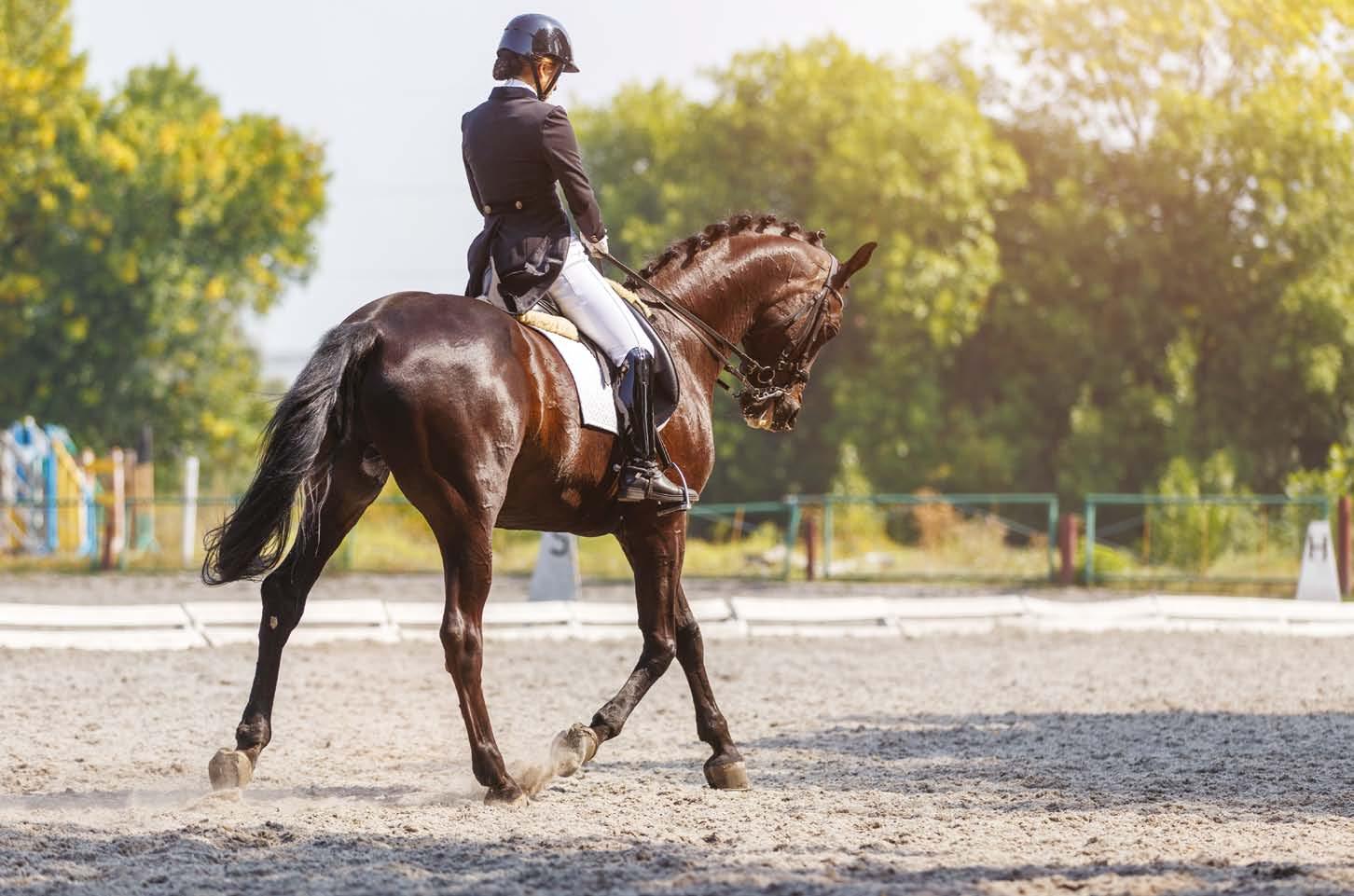

Popular during COVID, online equestrian events have once again come into their own during the cost-of-living crisis, providing riders at any level with equine competition experience that requires far less effort and expense.
Utilised as a way to inject some competitive fun during COVID-19, online equestrian events are gaining popularity as the cost-of-living crisis creates holes in the horse owner’s pocket.
They might lack the atmosphere of a traditional show, but online competitions are a great way for competitors to practice their sport, for novices to have a go, or try out a test after a break or injury, or just to compete casually at home, without the cumulative expenses of entry fees, ground fees, stable or yard fees and, of course, the fuel.
The rising cost of feed, due to poor supply and natural disasters, plus the rising cost of living generally means that many riders are needing to carefully choose what equestrian events they can afford to attend. But while such luxuries might take a back seat, it’s important in these challenging times to have some fun, too. Taking part in a competition from the
comfort and ease of one’s property or place of agistment - without having to worry about how much it’s costing, or the work and time it takes to get there - is a much better alternative to having no such events on the horizon.
Online events are also a boon to interregional, interstate and international competitions, at a time when travel has become largely prohibitive due to cost or time difficulties. Methods of delivery for these online events have been streamlined and generally follow the same routine.
An online event can be tailored to just about any discipline, from dressage, showing, show jumping, combined training, Western to in-hand classes. There are also events offered that are purely for fun, where horses and ponies need not be registered, and riders/presenters don’t have to belong to an association or club to enter. Equestrian clubs of all kinds are offering online events in lieu of public events, where the attendant costs would include arena or grounds hire and
by Wendy elks
insurance, thereby saving riders the cost of higher entry fees, levies, stable or yard hire and fuel.
The impact of financial strain is being felt by clubs, too; those that want to stage events for their members, and for the allimportant fundraising that keeps a club going strong. Online events can keep the interest and momentum of training and competition going. Importantly, they create an opportunity for remote riders, or those who’d like to take part but are not yet set up with their own transport/horse float.
Virtual events are a democratic opportunity for everyone to enjoy equestrian sport.
Pony Club Australia began running virtual events during COVID, but a virtual component in their National Championships now remains a permanent fixture. Held biennially, in a rotation of states, attendance became financially prohibitive for most riders on the far side
February/March 24 - Page 56
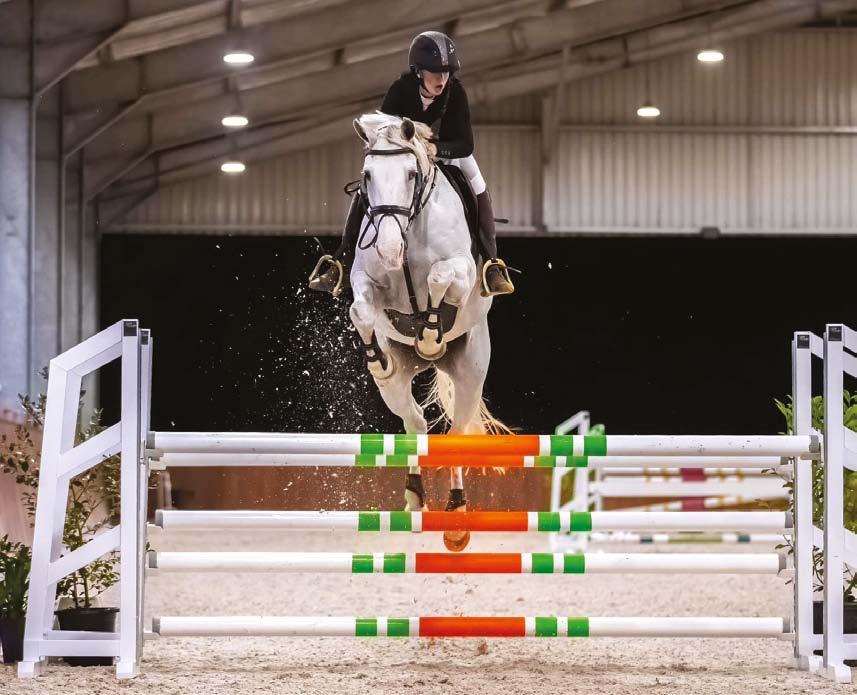
of the country, so teams can now attend virtually instead. Last year the Nationals were held in Perth, Western Australia, and teams from as far away as Tasmania and Queensland were able to compete in all disciplines apart from cross-country, where the course could not be duplicated.
“Championship events are held at a central hub in each state, with identical tests and show jumping courses,” says Pony Club Australia’s marketing manager, Bronwyn Wheatley. “The event must be held within a specific time slot and filmed from exactly the same perspective. After the competition we put together a video showing 30 seconds of each combination’s performance, their names and club. Winners were announced at the end of the video.
“It’s a fair bit of work, but it was very popular, and it’s given a lot more kids the chance to compete for their club, and state. Pony Club Australia also competes in the same manner internationally, with Britain, the United States, South Africa and Hong Kong, in dressage and show jumping. You have to be selected, then you ride for your country at your State equestrian facility.”
While the atmosphere and cultural exchange is lacking at a virtual international event, it’s a way to maintain international competition at a time when overseas travel for teams is financially prohibitive. And it gives
future competitors a taste of international competition.
Though there might be a delay between the competition wrap-up and getting the results, due to logistics, virtual comps in any discipline or interest are a way to maintain a competition schedule, for riders of all ages and levels to see how their training is going, for fun, a reason to keep training and maintain interest and connection during off-seasons, and for those working toward next-level advancement.
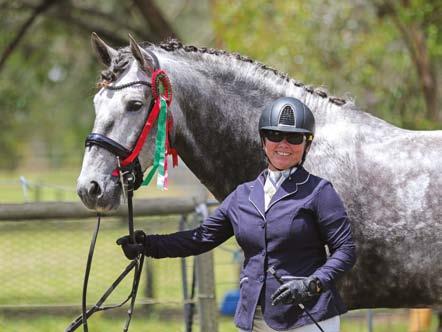
jumping, combined training and working equitation virtual comps. It’s fun, a reason to keep training, and the same thrill is there if you win a place or prize —these are sent out in the mail. You can afford to enter more comps because there are no levies, ground fees, stable or yard hire, and so on, to pay.
“Certain rules have to be adhered to so that it’s fair for everyone. For instance, in working equitation and jumping you need to set up the identical pattern provided by the organisers, and shoot it from the angle stipulated. The competitor has a certain amount of time to get their test in (by posting it online). Usually a link is provided so competitors can see the other tests, so it’s still instructive … although my daughter does miss being able to watch tests in real time, on the day.
“When judging, the judge should be prepared to sit down and judge every test in one go, for the sake of continuity, and complete the task in a timely manner and get the results back to the organisers, to avoid delays. They should also avoid stopping and starting viewing/judging a test, once again for reasons of continuity.
“The onus is on the competitor-at-home to take the competition seriously and treat it like a normal competition. There are no performance times to adhere to, but once you decide to do the test, don’t be tempted to start it again half a dozen times to get the best result, after all, you can’t do that at a comp.”
This means that first-timers and newbies have the chance to hone their skills, without any pressure or expense of travel, and purely for fun.
“Between us, my daughter and I have competed in virtual dressage, show
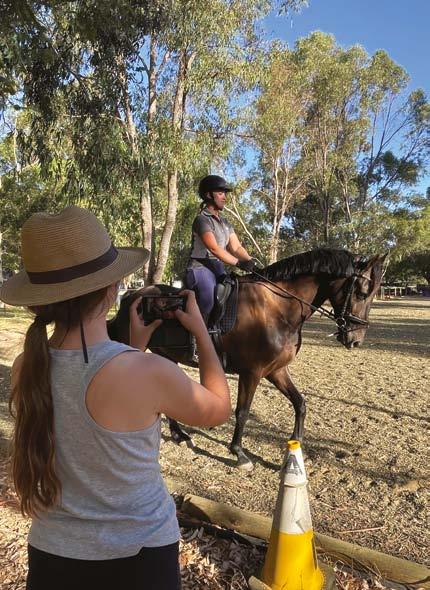
February/March 24 - Page 57
The Pony Club National Championship events are held at a central hub in each state, with identical tests and show jumping courses.
Well-known Australian horsewoman, rider, EA competitor and FEI judge, Liz Tollarzo judges international events and has some good tips for riders, and judges.
Liz Tollarzo, EA competitor and FEI judge, with Nemo (SPA) (IMP)
General GU idelines f O r filmin G a h O rse e V en T
With a video camera or phone in the hands of someone willing and able to concentrate on what they are doing, anyone can film and upload to a competition.
Even if not entering an event, taking a video of your self riding and then watching it can be beneficial, as often we do not ride like we ‘think’ we ride, and the video highlights this.
Tips for dressage comps:
1. To make sure you are not videoing directly into the sun you may need to swap letters around.
2. If you do not have dressage letters, make it a project to make some by painting them on buckets, bollards, laminated card or flower pots, for example.
3. Ask the person videoing your test to stand either immediately in front of C with their back to C on the centre line, facing A; or, if there is room, stand behind C on the centre line facing A -- then set the zoom on the camera so the whole of the horse remains in the frame for as much of the arena as possible.
4. Stand a little further back (if possible) from the arena at c, facing a, so that the judges can see the whole test.
5. Keep the rider and horse in the centre of the frame and in full view of that part of the arena, especially if making a transition by a marker.
6. Do not stop videoing until at least four seconds after the last halt and salute. If a video is stopped and re-started, it will likely be rejected.
A goal to work towards in one’s chosen sport is motivational and a happy distraction when finances are tight. Anyone with a horse, at any level, can find a competition to suit their interests, and take part in the joy of equestrian competition, whether they are isolated, injured or without transport.

Tips for show classes:
1. You will need a digital camera, phone or tablet capable of recording clear video footage.
2. If videoing with your phone or tablet, have the video on landscape orientation.
3. Make sure your device has a zoom function, as it will be necessary to use this when the horse and rider are at the far end of the arena, but avoid excessive zooming in and out as this can make it hard to watch.
4. Ask the viewer/filmer to keep the horse in the centre of the view finder, and ask them to start videoing a dozen or so strides before the start of the test or workout, all the way until after the final halt.
5. For good results, a steady hand or a tripod is essential!
6. Check the rules of each online competition regarding the regulations on what tack your horse needs to wear, or shouldn’t wear, and the type of competition gear you need to wear too. Some events require everything to be as they would in open competition, others are more casual and might not require you to wear show attire.
7. Some competitions don’t allow you to use video that has previously been submitted for another event, so check the rules for each competition first.
8. Standing on a tack box will give a better view of the arena.
9. Set the camera to a high-quality setting. Many video formats use compression technologies. The more one compresses the video, the smaller the final file size. While small files are generally good for the web, they are not necessarily good for viewing and can be very blurry or jumpy. The reason is that compression reduces video quality when it is replayed. Jerky or jumpy video movements could lose marks in a dressage competition.


February/March 24 - Page 58
Competing at the National Dressage, Merricks PC 2023, Sam Noakes
For the Love of them...
The non-ridden horse
by Wendy Elks
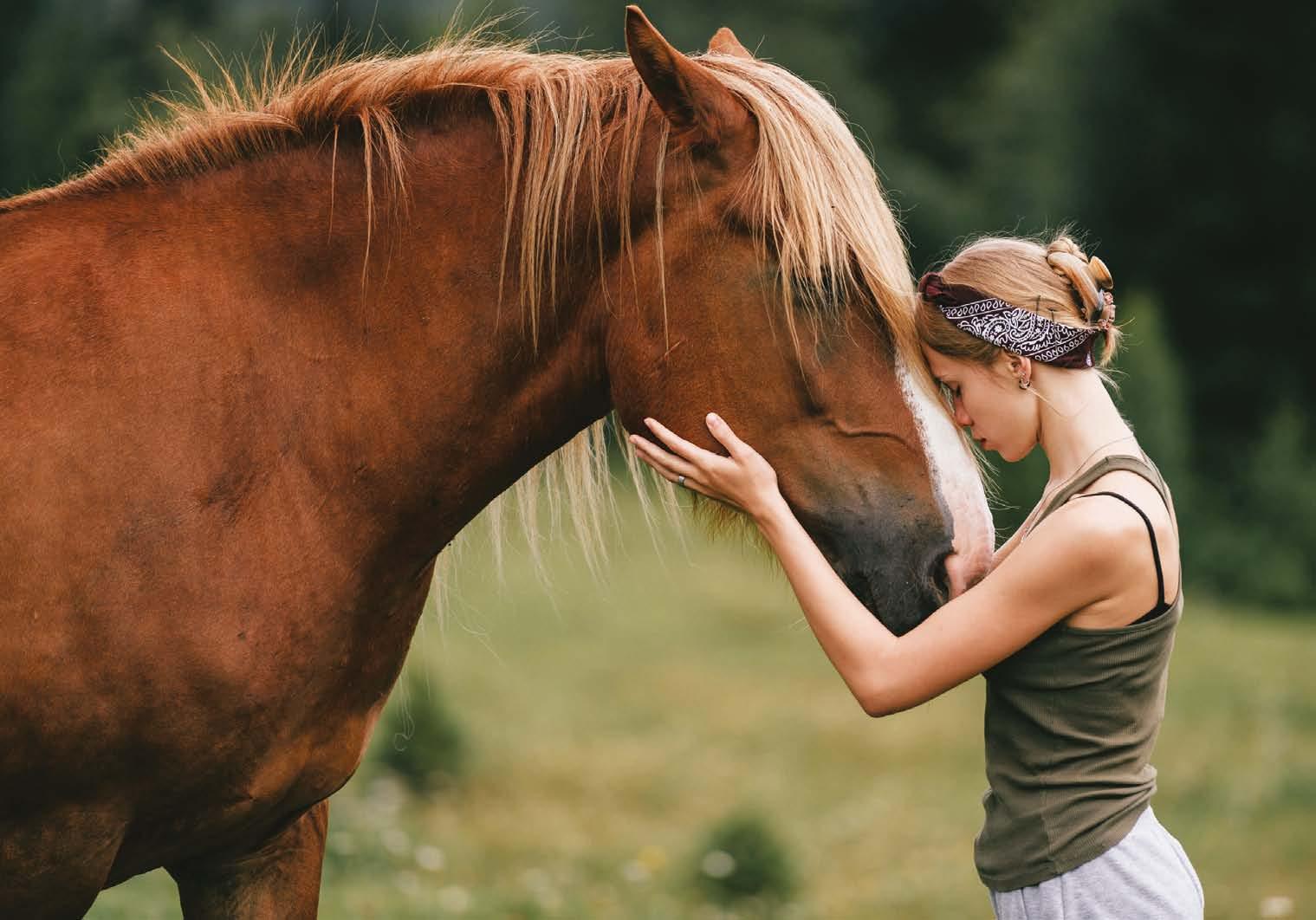
In an achievement-driven society, those who own horses but rarely, if ever, ride them can feel challenged or criticised by their peers. To some riding friends, and even non-horsey ones, not using your horse for ‘what it was made for’ seems, just … wrong.
The paddock ornamenT
Often, a subtle criticism goes with the challenge of, “When are you going to start riding that horse?” Genuine and well-meaning riding friends, keen to involve the non-rider and guide them into their wonderful world of riding, may offer help, suggesting lessons or coming for a quiet ride. They may even offer to start working the horse to make it easy for the non-riding horse owner to climb aboard.
Some riders don’t seem to appreciate that, for others, coming home to see their horse grazing in its paddock gives them all the satisfaction they need. Or that the smell of a horse and the feel of that warm breath and velvety muzzle is enough to instantly transport the owner to a relaxed state and forget the worries of the world. And that is what they want from their horse.
Not everyone starts out with the intention of being a non-riding horse owner. There are many reasons why Australian pastures are dotted with ‘paddock ornaments’. These could include: injury to either horse or rider; age - children grow up and their beloved, elderly equine deserves a comfortable and happy retirement; it’s

unintentional but life gets in the way; the owner enjoys caring for rescued, neglected or unwanted animals and loves having a horse in their life…
Anna Blake, an American coach, author and horse advocate speaks eloquently of the many reasons why not riding is sometimes the right thing to do.
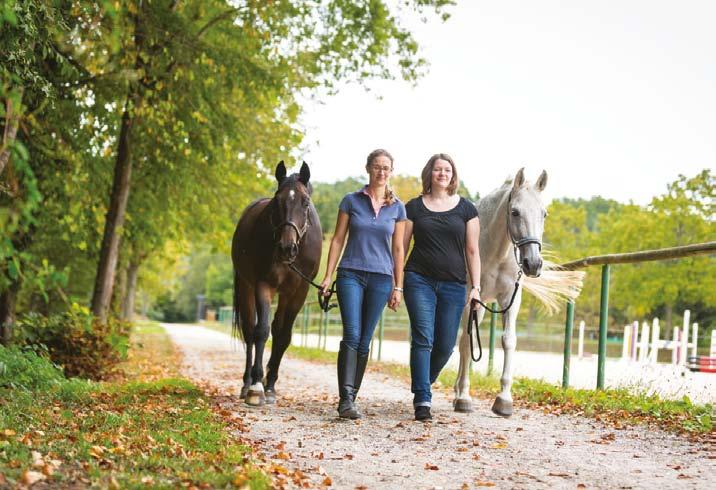
Going for a relaxing walk with one’s horse, grooming and talking to it, or just reading a book out in the paddock may be the perfect no-stress, mutually beneficial relationship for a human and their horse.
not. Relationship, as it relates to herd dynamics, is what matters to horses, and that isn’t defined by our altitude. Maybe it’s time to re-invent ourselves and up the conversation. Wouldn’t it be ironic if no longer riding meant that our horsemanship improved?”
The pressure on non-riders is sometimes self-inflicted and increases when their own inner voice, or a partner, questions the expense of keeping a horse without riding.
Hearing continual comments from others can make the nonriding owner sensitive to the issue. Comments such as “Horses get bored standing around in the paddock all day; horses were made to work; they are healthier and live longer; they get naughty and suffer health problems if left in a paddock all the time,” etc. etc. They are lucky enough to have a horse - a dream of many who are unable to do so – and may question themselves as to why they aren’t riding it?
Ahh, guilt…that uniquely human emotion that can ruin the most innocent of dreams.
There is something to be said for giving an animal a job to do. All creatures are happier when allowed to fulfil their natural instincts, but a horse’s job is to find enough food, water, shelter and companionship. It is not born with the instinct or desire to get high scores in dressage or win a showjumping round, barrel race or riding class.
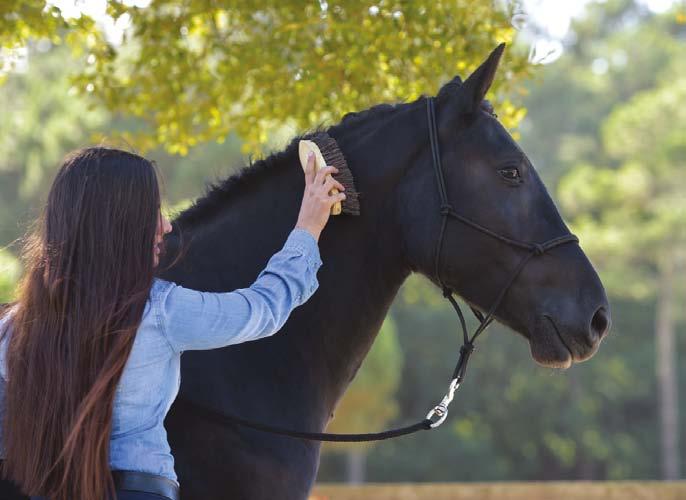
“Maybe it’s you that is having a hard time; your past injuries are catching up and it’s hard to get comfortable in the saddle. Maybe you are a certain age and your ‘courage hormones’ have abandoned you.
“Or time makes you rush too much. You have a list of all your lists and so many people depending on you. You burst into the barn and ride fast, but you’re still late. Your horse behaves like the victim of a drive-by assault. It’s an honest response and you’ll deal with it when you have more time.”
The conflict the horse owner can feel is immense. “You feel obligated. You feel like a loser. You’re too old or too busy or too frightened. You’d hate to think what people might say. You’d be letting your horse down. But in the quiet, when you listen to your heart, you know.
“Humans seem to put so much self-judgment on whether they ride or not. I see it every day, as an instructor. Riding is wonderful; I’m glad I’m still in the saddle. But the longer I’m around horses, the more I believe that they don’t care if we ride or
eQUaSY: a danGeroUS addIcTIon To horSeS
Riding is not a natural function of the human body, which is why many riders struggle to do it well at a higher level. By default, their horses struggle, too. It is also riskier when there’s a lack of confidence. The keen and ambitious enjoy the challenge; but now that horses are no longer essential to human endeavour, riding is a desire, not a necessity.
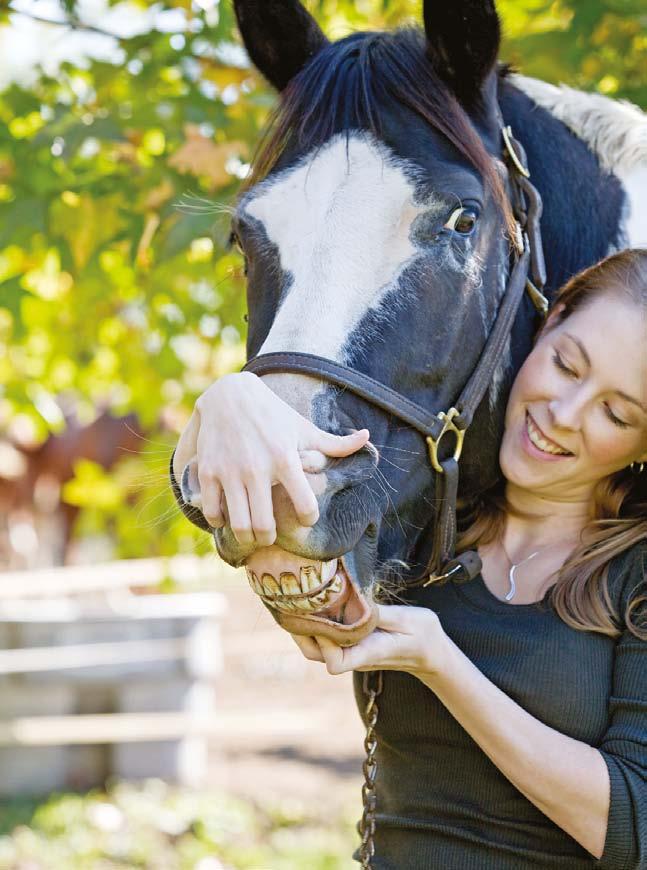
February/March 24 - Page 60
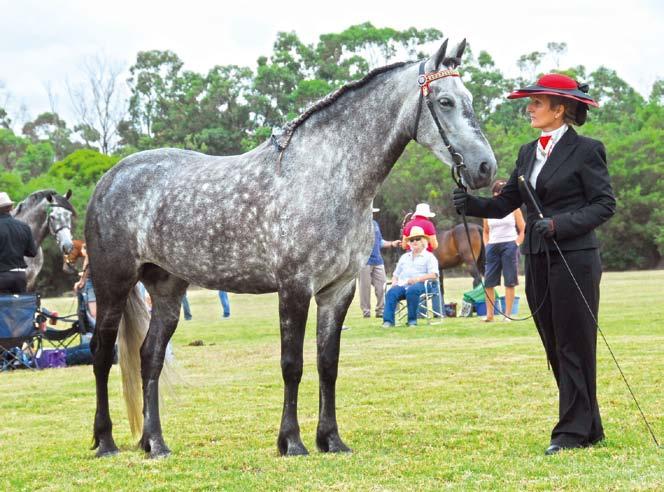
When riding isn’t what an owner cares about, there are more ways than ever to enjoy horses in other, highly interactive and rewarding ways … including competition.
In an article he wrote in 2009, British psychiatrist and drug dependency expert Professor David Nutt cited a condition he called Equasy: Equine Addiction Syndrome, a condition ‘characterised by gaining pleasure from horses and being prepared to countenance the consequences, especially the harms from falling off/under the horse’.
More than slightly tongue-in-cheek, Professor Nutt defined equasy as “an addiction that produces the release of adrenaline and endorphins and which is used by many millions of people in the UK including children and young people”. On a more serious note, “The harmful consequences are well established –about 10 people a year die of it and many more suffer permanent neurological damage. It has been estimated that there is a serious adverse event every 350 exposures and these are unpredictable, though more likely in experienced users who take more risks with equasy”.
He compared the love of horses to an unhealthy drug dependency to make a point to law-makers, but Professor Nutt raises a pertinent point. Addiction to adrenalin or success, flirting with death and the desire for long satin ribbons may be complications of some riders’ attitude to horses and riding.
While not considered an extreme sport where danger is a key element in its attraction, the risks associated with horse riding put it at the top of the dangerous sports list. People die and are permanently damaged from falling – with neck and spine fracture leading to permanent spinal injury (Silver and Parry, 1991; Silver 2002). Head injury is four times more common though often less obvious and is the usual cause of death. In the USA, approximately 11,500 cases of traumatic head injury a year are due to riding (Thomas, et al., 2006), while in some shire counties of the UK it has been estimated that riding causes more head injury than road traffic accidents (Nutt, 2009).
While we would never suggest that people give up riding because of the possibility of injury, the key point here is that many riders are forced to stop because of injury or loss of confidence. Does this mean that they should give up the pleasure of owning horses, entirely?
Who SaYS horSeS have To Be rIdden anYWaY
Welfare issues for animals are highly topical, and there’s a growing sentiment among animals rights activists that horses shouldn’t ridden at all. This might seem an extreme view, but the horse owner who opts not to ride can take pride in choosing to keep a horse without expecting to make it work hard for them. There’s an evolving understanding of horses’ minds, and appreciation of their innate qualities is increasing. When riding isn’t what an owner cares about, there are more ways than ever to enjoy horses in other, highly interactive and rewarding ways … including competition.
The amazing results that in-hand training can achieve is an example. Julie Johnson, horse enthusiast and past rider from NSW, has a story similar to many: an injury precluding her from riding sent her equine interests in other directions: breeding and showing. “I was fortunate to own a lovely Arab stallion. The passion for horses doesn’t go away, but it changes.”
“Some riders do come down hard on non-riders. I wanted to create a safe (non-judgemental) forum for people who don’t ride, to seek advice and support one another. It took on a life of its own. There are a lot of non-riding horse enthusiasts out there.”
So long as the owner spends time with their horse, ensures it has everything it needs to thrive and be happy, and doesn’t spoil its character or health with the wrong kind of love, horse ownership without the activity of riding may be highly symbiotic and rewarding for both parties.
Going for a relaxing walk with one’s horse, grooming and talking to it, or just reading a book out in the paddock may be the perfect no-stress, mutually beneficial relationship for a human and their horse.
With way too many horses being bred, and consequently, so many in need of loving homes and care, those who love horses for their own sake and decide (or have the decision thrust upon them) to have paddock ornaments, who feed, love and care for them without a blue ribbon in sight, may rank right at the top of the leaderboard with the best horse owners there are.

February/March 24 - Page 61

Bandages Ban in the netheRlands
The Royal Dutch Equestrian Federation (KNHS) has announced a significant rule change in equestrian sports in the Netherlands which prohibits the use of bandages on the competition site for dressage, jumping, driving and vaulting. The rule, which was already in place for eventing, aims to enhance horse welfare based on scientific evidence indicating that bandages offer ineffective leg protection and may harm horses.
Fenna Westerduin from the KNHS underscores the necessity of discontinuing bandage use, emphasising available alternatives for safeguarding horses’ lower legs. Studies, including those by Morgan Lashley, a specialist in sports medicine and equine rehabilitation at the University of Utrecht, reveal that bandages fail to prevent overextension of the fetlock and can elevate leg temperatures, adversely affecting tendon elasticity. Moreover, incorrect bandage application poses risks like entanglement or pressure, potentially leading to tendon trauma. These regulations have been put in place for horse well-being during competitions and are effective from March 1, 2024, for vaulting and April 1, 2024, for dressage, jumping, and driving.
the cuRious case of the hoRses that ‘hiBeRnate’.
The Yakut horses of northern Siberia may provide lessons in how animal populations can respond to environmental extremes.
of Siberia. Researchers say that this hardy breed not only has the capacity to achieve a physical state akin to hibernation during periods of extreme cold, but it developed this adaptation with surprising swiftness.
The Yakutia region of the Russian Federation, also known as the Sakha Republic, is one of the coldest inhabited places on earth. Temperatures of -40 degrees Celsius (-40 degrees Fahrenheit) are common during the winter. In the portion of Yakutia above the Arctic Circle, temperatures may go as low as -70 degrees Celsius (-94 degrees Fahrenheit). Nonetheless, horses and humans continue to live and thrive in the region. Today Yakut horses are ridden, pull sleds and serve as sources of milk and meat—as they have for centuries.
An international group of researchers investigated the origins of the Yakut horses and the qualities that enable them to survive and thrive in their inhospitable environment.
DNA analysis to used to determine that modern Yakut horses descend from those brought by people who migrated to northern Siberia during the 13th and 15th centuries. What’s more, the researchers say, the Yakut horse population quickly developed adaptations to its frigid environment. Specifically, modern Yakut horses are small in stature with compact bodies and short legs, conformation that helps conserve body heat. They also grow thick winter coats, which help insulate them from cold.
Finally—and perhaps most interesting—Yakut horses appear to adjust metabolically to extreme cold. The researchers observed that the horses enter a ‘restful’ state characterised by low body temperature, slow heart rate and reduced metabolic activity for hours at a time during winter. This response, called torpor, helps bears, squirrels and other animals cope with periods of cold and low food availability, but it had not previously been documented in horses.
Extended torpor, lasting for several days or weeks, is sometimes described as hibernation. Even as their metabolism slows during the harsh winters in their region, Yakutian horses remain active, entering a state that some researchers call ‘standing hibernation’. Normally, an evolutionary response to environmental pressure plays out over thousands of years. However, the international research team determined that the Yakut horses made these adaptations in about 100 equine generations, one of the most rapid adjustments to extreme environmental conditions documented in animals.
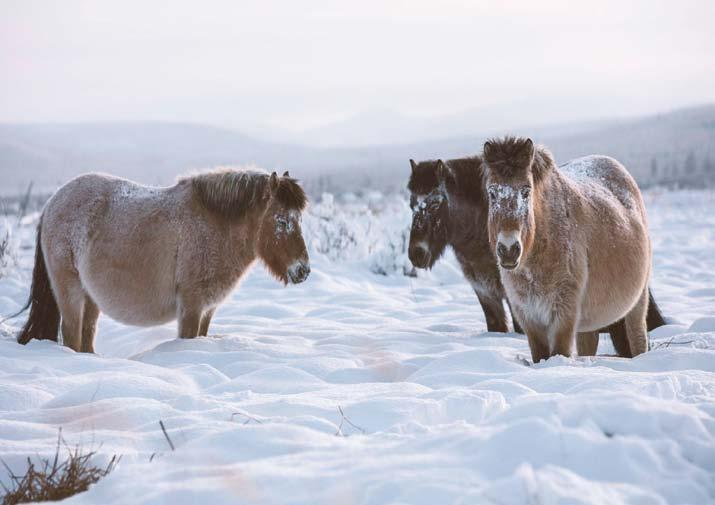
These findings, say the researchers, could help to improve our understanding of how animals adapt to climate change and aid in the development of selective breeding programs that produce animals better suited to cope with extreme environments.
dRessage chef d’equipe appointed
By equestRian austRalia
Amanda Renouard has recently been announced as Dressage Chef d’Equipe to provide leadership to Australian Dressage riders until the 31 December 2024. Australia has a large contingent of riders based overseas, and in 2024 many Australian domiciled riders will travel to Europe to campaign for the Paris24 Olympics. High Performance Director Will Enzinger recognised the need for leadership within the Europe region and for the first-time EA
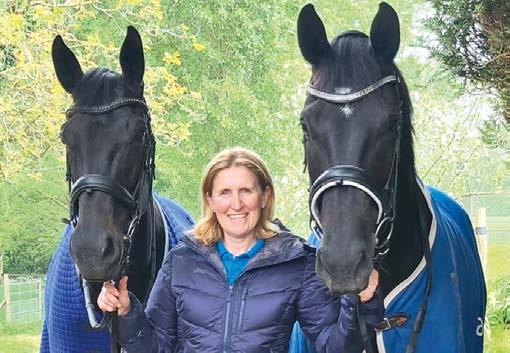
requested applicants for the role be based in Europe or the UK. Amanda, a British citizen, has lived in France for the past fifteen years where, with her husband (who is in event management) and son, currently manage their own horse breeding facility. Amanda’s career path started in horse nutrition where sales and marketing introduced her into barns working with professional athletes. An interest in managing the athletes led to Amanda acting as an Agent for many of the riders. Time spent in Event Management at some of the leading horse shows provided good background on the pressures behind the scenes at large events, and an understanding on how that affects officials, management teams, horses and riders. She has also worked for other NF in a consultancy capacity, developing High Performance programs and squad development. “I am honoured to be offered this opportunity to help the Australia Dressage Team achieve their goals at the 2024 Paris Olympics and beyond. This comes at a time when Australia has some exciting horsepower and talented athletes alongside the very experienced riders. It is going to be a busy year and I am delighted to be part of it.”
hoRsetalk new Zealand site closes
Horsetalk.co.nz has closed, the website so well known for its equestrian news, research and information now greeting visitors with a notice advising of its closure after 28 years. The site’s editor has posted there will be discussions on how some, or even all, of Horsetalk’s thousands of articles might be archived and made accessible in the future.
Relaxed hoR Bette leaR
A new study has revealed the more relaxed a horse is the better it is at learning new tasks. Equine scientists at Nottingham Trent University wanted to see how the level of arousal in horses – the extent to which they might be excited or stressed for instance – affected their performance in a cognitive task. They measured physiological markers of
arousal including heart rate variability and eye temperature while the horses were resting and again during learning. A group of 20 horses was given a choice of two targets, with the correct one resulting in a food reward. Once the horses had learned to select the correct target, the researchers ‘reversed’ the task so that the horses had to select the opposite target for reward. The team found that horses that had lower arousal both at rest and during learning performed significantly better in the cognitive challenge. Horses that did best in the task also showed an increase in left eye temperature and this was a significant predictor of performance. The researchers suggest that the left eye temperature may have increased as a result of increased blood flow to the left hemisphere of the brain, with the left hemisphere responsible for learning targeted responses to stimuli and feeding behaviour, both of which were integral to the challenge. The research team suggest that as well as revealing that horses that are more relaxed perform better at tasks, their study demonstrates the use of physiological markers to predict how individual horses might learn.
ReseaRcheRs attempting to gRow a hoRse gut
According to Dr. Beth Wells of Scotland’s Moredun Research Institute the next technological step in horse disease research is being developed. During a presentation on equine grass sickness at the International Thoroughbred Breeders’ Federation’s webinar in January Dr Wells revealed that researchers are currently attempting to create a laboratory-grown horse gut. Dr Wells said the method has proved possible with other livestock species and completion of this horse gut would be “a world first for equine”. To grow the gut, Dr. Tanith Harte of the Moredun Foundation Equine Grass Sickness Fund has been taking tissue from healthy horses who had to be euthanised for other reasons, but also from horses who died due to EGS. “She’s been growing up initially part of the gastric glands,” Dr Wells said. “These will eventually form a very mini horse stomach with exactly the same physiology as in the horse.” An autonomic nervous system dysfunction that predominantly impacts the gastrointestinal system of equines, EGS was first reported in Scotland in 1907, the mystery going unsolved in cause and prevention for over a century. “This, of course, will be an absolute godsend in terms of improving our understanding of how the horse gut functions in both healthy animals and in grass sickness cases,” said Dr Wells. EGS has proved a confusing and deadly problem for horse owners, especially in Europe. Horse owners worldwide are encouraged to consider donating samples and report cases of EGS at grasssickness.org.uk.
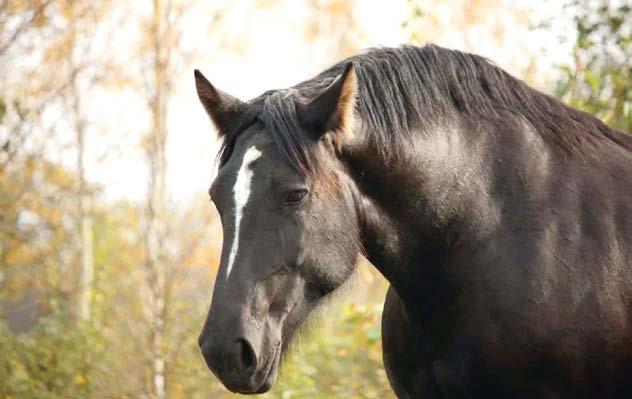
tRainee and upgRading ea oaches
Hundreds of people start on the EA Coach Pathway, but it can feel like a lonely pursuit, and many drop out. The great news is, firstly the Pathway has become more flexible and secondly completed slips and modules are valid for a lifetime. Trainees can complete 100% of some modules electronically, and up to 50% of others remotely with approval from their State Committee. Recognition of Prior Learning is also an option, especially for competition riders. Wendy Barker, an EA Coach Educator who really loves working with trainee coaches, ran seven evening webinars for coaches and horselovers last winter and was thrilled with the
February/March 24 - Page 63
A MANDA R ENOUARD C HEF D ’E QUIPE EA
interest and positive feedback across all states. Currently, Wendy is running both webinars and practical sessions for potential and upgrading coaches such as sample Lesson Plans with videoed ‘Demo Lessons’ for coaches who need more support to complete modules. All the activities are recorded electronically so that remote trainees and those who miss a session can still register and benefit, receiving Word Templates and Samples to make tasks clearer. Coach Catherine Forbes added, “I am so happy we are now working as a group, there are more opportunities to learn and problem solve, and it so much more motivating!” People can register on Nominate.
100 plus hoRses seiZed in VictoRia
RSPCA Victoria’s Inspectorate executed a warrant seizing 109 horses from two Campaspe properties in December. After successfully prosecuting the owner in September 2023 over his failure to provide adequate food and veterinary treatment to the horses, Magistrate Ian Watkins imposed a ban on the man owning or being in charge of horses for three years over the cruelty offences and gave him three months to offload the herd.
saudi aRaBia hosts inteRnational aRaBian hoRse festiVal

When inspectors arrived at the properties to check compliance they discovered the man had instead purchased more horses.
RSPCA Victoria’s chief inspector Michael Stagg said the man was essentially thumbing his nose at the law by failing to comply with the court order.
“If you want to own an animal in Victoria, you must take care of that animal,” Chief Inspector Stagg said. “In this particular case, it’s incredibly disappointing to see someone not only fail to provide that care to so many horses despite orders to do so, but blatantly disregarding a court order as well.”
The horses will be assessed by RSPCA staff with the assistance of Racing Victoria, which will see if the herd can enter the racing group’s rehabilitation and rehoming program. “Horses seized by RSPCA tend to spend over 250 days in our care, and that could cost upwards of $18,000 per horse,” Mr Stagg said. Racing Victoria has also banned the man, who was not a licensed participant, from racing events.
palataBilty of hemp foR hoRses
As feed expenses escalate in the horse industry and hemp becomes more accessible, researchers are examining hemp as a potential substitute for horse feed.
A recent American study examined the palatability and acceptability of hempseed meal pellets, comparing them to other commonly used horse feed options.
During an initial experiment, horses were provided with soybean meal pellets (SBM), rice bran pellets (RBP), or beet pulp pellets (BPP) in one bucket (500g) and hempseed meal (HSM) in a second bucket (500g) twice daily for three days. The feeding regimen involved rotating the treatments so that each group of horses received every type of feed during the trial. Horses had a 10-minute window for eating during each feeding session.
Horses consumed significantly more hempseed meal pellets compared to soybean meal pellets and beet pulp pellets. The quantities of HSM and RBP consumed were similar. A gradual increase in hempseed meal consumption was observed as the study progressed.
The researchers conclude that HSM may be similar in palatability to RBP and more palatable than SBM and BPP. Consumption of HSM increases over time but is not impacted by hay consumption. They suggest that hempseed meal may serve as an acceptable replacement to more common feedstuffs in equine rations.
The three day International Arabian Horse Festival in Riyadh wrapped up at the end of January with Al-Rajihiyat Stud’s Equator winning the gold medal for the finest stallion after intense global competition. Prince Khaled bin Sultan, along with royal dignitaries, ambassadors, and horse enthusiasts, attended the event, the atmosphere highly competitive as more than 200 elite Arabian horses and their 111 owners, from nine different countries, took part at the King Abdulaziz Arabian Horse Center in Riyadh.
This great stallion, with numerous titles on his account, is a descendant of the stallion Gazal Al Shaqab, whose impact on the Polish breeding program was enormous. Equator’s collection of titles is impressive. He was chosen the Junior Spring Show Champion, Polish Junior and Senior Champion Stallion, European Junior and Senior Champion Stallion, and won almost the full American Triple Crown being the Scottsdale Show Champion, Las Vegas Arabian Breeders Cup Show Champion and US Reserve Champion. In August 2021, Equator was purchased during the Pride of Poland Auction for EUR 450,000 ($737,000) by Al Rajihiyat.
impRoVing puBlic acceptance of equestRianism
World Horse Welfare (WHW) hosted a virtual conference in January to bring horse sport leaders together to learn about the strategies that leaders of other industries have used to address public concerns about their activities – often emerging stronger as a result. WHW, a leading global horse charity that works to improve welfare through care, research, education and influence, convened the event as part of its work with horse sport, governments, academia and institutions to ensure the welfare of the horse is better prioritised in the horsehuman relationship.
‘Maintaining public acceptance of equestrianism: What can we learn from other industries?’ was attended by more than 150 leaders from racing and equestrian sport globally, the role of public trust in the ongoing sustainability of any industry a consistent theme. Strategies such as proactively inviting critics to the table, using ‘radical transparency’ to demonstrate your industry’s openness and honesty and ensuring you are aligned with the values of the public were highlighted as being key to building trust. The importance of these recommendations is underscored by the results of a survey conducted for WHW by You Gov in May, 2023. The data indicated that while around 30% of the UK public broadly trusted horse sport regulators to put horse welfare first, around a quarter did not and almost 50% did not know or were not sure – suggesting much more could be done to build trust on the extent to which equine welfare is prioritised in equestrianism.
Roly Owers, Chief Executive of WHW said, “As part of our commitment to ethical horse sport we hosted this event for sport leaders to help them learn lessons in building public trust from other industries that involve animals, and how making changes to build trust is not only possible but essential for equestrianism to grow.”
February/March 24 - Page 64
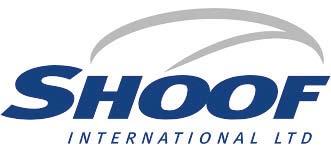




to hoofbeats to WIN Three subscrIbers WIll each WIN a bucas buzz-Off zebra rug
The Buzz-Off zebra range of fly and insect protective products are made from a specially developed lightweight fine mesh fabric with zebra print. This mesh blocks even the smallest of insects. Research has discovered that flies hate the zebra stripes as they find it confusing and so steer clear of them! find out more about the bucas range at www.shoofdirect.com.au/bucas Subscribe online: www.hoofbeats.com.au Call to subscribe: 08 9397 0506 Email: enquiries@hoofbeats.com.au Hoofbeats magazine, 90 Leslie Road, Wandi, WA 6167 HOWTO SUBSCRIBE Have your copy delivered direct to your door or favourite device! All current subscribers will automatically be entered in the draw to WIN! Visit the online store: www.hoofbeats.com.au THE PERFECT GIFT AVAILABLE FOR APPLE & ANDROID Congratulations to the winners of the December/January issue’s subscription prize. JaCqUIE LEWIS from Castlereach, NSW; has won Wattlelane Stables Flower’s Gold 12kg, Wattlelane Stables Hair in a Bucket 3kg and a Neddy Wear 600D Rainsheet rug. GWEnda nGUyEm from Jeetho, VIC; has won Wattlelane Stables Flower’s Gold 4kg, Wattlelane Stables Hair in a Bucket 2kg and a Neddy Wear Cotton/Mesh Hybrid Combo. Visit www.wattlelanestables.com.au and www.neddywear.com.au maGaZInE SUBSCRIPTIOn (6 ISSUES) $48 aPP SUBSCRIPTIOn (6 ISSUES) $29.99 (3 ISSUES) $16.99
shoof Direct - the easy way to buy online

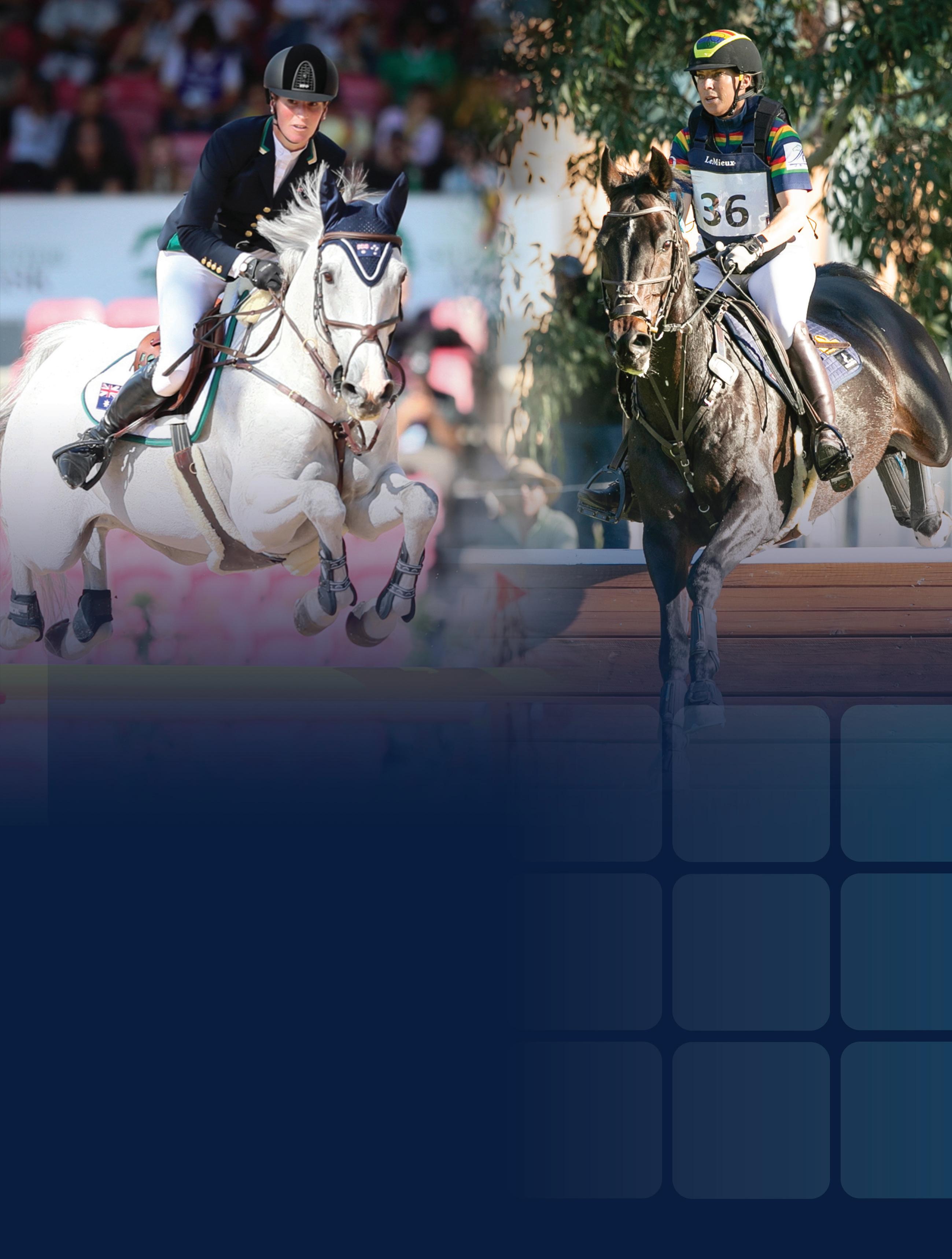
Developed by Kentucky Equine Research® World Leaders in Equine NutritionTM 1800 772 198 • advice@ker.com Discover science-based products or your closest retailer at ker.com
For over 30 years Kentucky Equine Research has continually developed innovative solutions to the health and nutritional challenges inherent in modern equine management. The results of studies conducted at its research farms, as well as advances in equine nutrition from institutions around the world, are applied and thoroughly tested in the creation of KER products. Proprietary ingredients and science-based solutions characterise KER Targeted Nutrition. Top equestrians worldwide in a variety of disciplines know they can rely on KER to fuel world-class performance. Targeted Nutrition for World-Class Performance






































 by Wendy Barker
by Wendy Barker









































































































































































 by Liz Tollarzo
by Liz Tollarzo









































